







By Karen Robinson-Jacobs for The St. Louis American
Two prominent St. Louis-area programs that help smooth the re-entry process for former inmates freed from incarceration are expanding to better address “the big problem”: the staggering rate of recidivism.
St. Charles-based Connections to Success, which launched in 2001 as Dress For Success Midwest, offers returnees a support system that includes not only access to clothing and transportation to aid in the job search process, but also mentoring, skills building and “life transformation coaching,” officials said. The organization, which serves about 600 new individuals annually, has begun training other groups to offer similar training.
In August 2020, Concordance Academy of Leadership,
By Dana Rieck
Of The St. Louis American
St. Louis Corrections Commissioner Dale Glass on Wednesday announced his resignation, effective June 1.
While a release from St. Louis Mayor Tishaura Jones’ office noted that he was not asked to resign, Jones and U.S. Rep. Cori Bush, D-St. Louis, released statements that indicated he didn’t have much of a choice. Jones wrote that
which recently moved its national headquarters to Creve Coeur, launched The First Chance Campaign – a $50 million fundraising effort chaired by David Steward, World Wide Technology founder and chairman – to expand its ‘holistic’ re-entry model outside of St. Louis.
About $15 million has been raised so far in the effort to add up to 11 U.S. cities by 2025, including potentially Kansas City, Kan., Dallas and Chicago.
Reducing the rate of recidivism – the revolving door that sees many of those convicted of crimes head back to prison in short order – not only saves tax dollars, experts said, but also helps break what can become an intergenerational curse.
“We call it the big problem, frankly,” said Roderick Nunn, executive vice president and head of education and
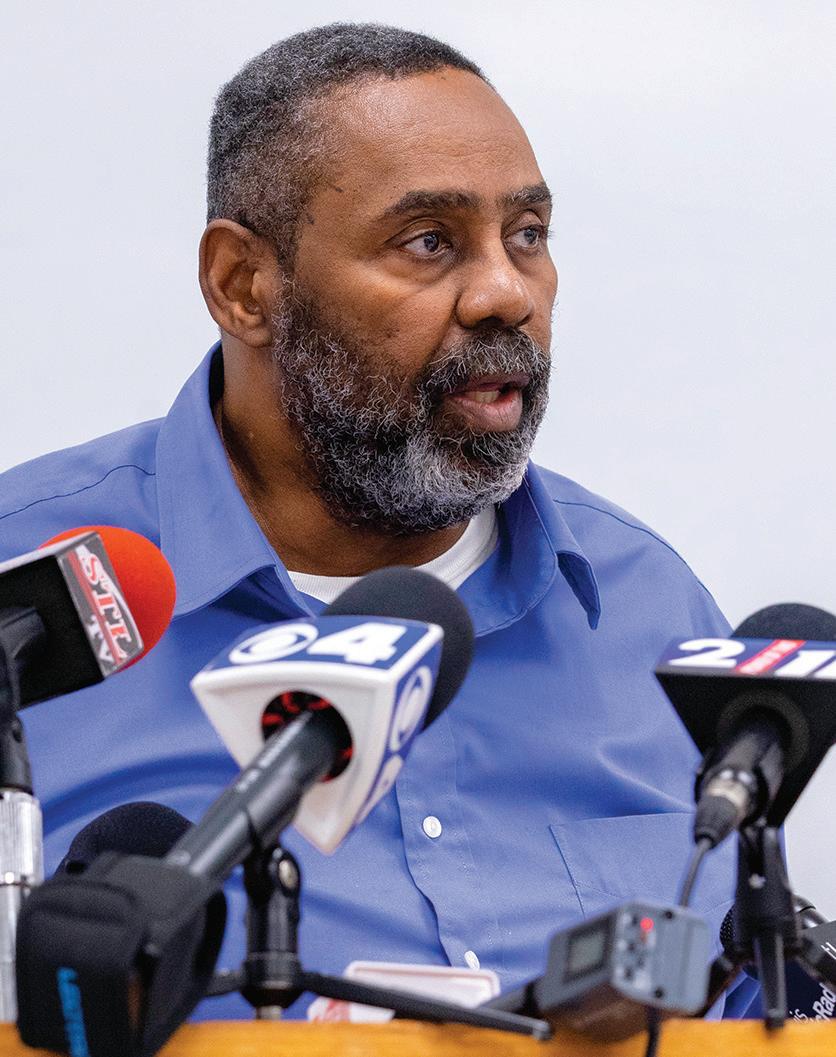
Action at Sumner one of 100 nationwide
By Sophie Hurwitz Of the St. Louis American
The late John Lewis would have been proud.
About 75 people gathered to march and ride in a “votercade” in recognition of National John Lewis Voting Rights Advancement Action Day at Sumner High School on May 7. It was part of a nationwide movement by 180 organizations to urge Congress to pass the “For the People Act;” “the John Lewis Voting Rights Advancement Act;” and Washington, D.C. Admission Act for statehood.
n “New skills, new patterns of behavior...I believe in that stuff, because I’m a living witness to it.”
– Mataka Askari
Former Corrections Commissioner Dale Glass speaks at a press conference on April 5, regarding the uprising that took place at the St. Louis City Justice Center on Easter Sunday.
The choice of Sumner for the event’s location carried significance: over the past several months, community members have gathered in support of the school’s reopening next year, though it was initially slated for closure as part of a “right-sizing” of St. Louis Public Schools.
Now, the school will reopen in Fall 2021 as an “arts and activism” high school, making it an appropriate choice for the setting of an event named for well-known Civil Rights activist and Congressman John Lewis.
Alderwoman Dwinderlin Evans, Ward 4, called the event “fantastic, right on point.”
“From the votercade to the activities later in the day, it was very successful,” she said. Sumner is located in Evan’s ward. “I plan on being visible and very actively involved to make sure Sumner is viable and stays
II of
On the cusp of revolutionizing political power in St. Louis n In Missouri, voter restriction and gerrymandering as strategies of voter suppression are not uncommon.
By Rebecca Rivas

J. Cole releases The Off-Season album, documentary
Grammy Award-winning rapper J. Cole‘s new single, “interlude,” off his highly anticipated album The Off-Season will be released Friday.
After 2018’s K.O.D. album, he dropped Revenge of the Dreamers III Dreamville Records compilation in 2019. He revealed during a concert perfor mance that same year that the longawaited album The Fall Off in 2020 - but it never came. Instead he dropped two singles, “The Climb Back” and “Lion King on Ice.” An Instagram post implied that Off would be released after Season J. Cole also debuted a documentary, Applying Pressure:The Off-Season Documentary on May 10 via YouTube. It is directed by Scott Lazer, who has also collaborat ed with Daniel Caesar, Tierra Whack, BJ The
Chicago Kid, Ari Lennox, J.I.D, Thundercat and Bas.
Sterling K. Brown to host OWN Father’s Day Special

OWN will premiere a television special,“Honoring Our Kings: OWN Honors Black Fatherhood” at 8 p.m., Father’s Day, June 15. Oprah Winfrey and Sterling K. Brown will host the Reginald Hudlin-produced two-hour special, which features conversations with everyday dads, celebrity fathers and music performances recognizing fathers worldwide.

“The greatest role of my life happened 10 years ago when I became a father for the first time,” said Brown, who also serves as executive producer.
“I am honored to celebrate these exceptional men who are my ‘Brothers in Fatherhood’ and continue to shift the national perception of Black fathers.”
‘Verzuz” unites SWV and Xscape in 1990’s girl group nostalgia
SWV and Xscape entertained millions of
viewers on Instagram Live, Triller and Fite.TV, with their harmonic vocals for a ‘Verzuz’ battle celebrating Mother’s Day. They went head-to-head in a showdown, performing top 20 best hits including “Rain,” “Just Kickin It,” “Weak” and “Understanding.”
The night was dedicated to the nostalgic era of 1990’s R&B and girl-group mania with the evening’s soundtrack controlled by DJ AOne, Xscape’s touring DJ and DJ Spinderella of Salt ‘N’ Pepa.
“We are standing in Agape here tonight for all the girl groups who never had an opportunity.” said Leanne “LeLee” Lyons of SWV. Femme It Forward joined sponsors Cîroc Vodka and Urban Decay Cosmetics to present the live broadcast.
Swizz Beatz and Timbaland launched the Verzuz series in March 2020 to celebrate legendary artists in the music industry including Babyface, Teddy Riley, E-40, Too Short and many more.
According to the New York Daily News, last year’s home invasion robbery that resulted in the murder of Pop Smoke was committed by a 15-year-old.
On May 7, Det. Carlos Camacho of the LAPD confirmed the teen was with intruders interested in stealing Pop Smoke’s Rolex



























watch. According to police, Camacho and others rushed the rapper’s rented Hollywood Hills mansion earlier this year and attempted to steal a Cuban link gold chain. Pop Smoke was killed and the thieves left with a diamond-encrusted watch that was later resold for $2,000.
The suspect, the youngest of four defendants, will face murder and robbery charges. He reportedly confessed to the shooting during a recorded conversation with a cellmate.
Woman alleges Trey Songz guilty of road rage incident
TMZ reports that Trey Songz allegedly struck a woman’s car with his vehicle, and then her hand, in a case of road rage. Minutes after midnight May 6, Songz and a woman allegedly began arguing while each were in their respective cars.
The unnamed woman told police officers that she got out of her car to confront him after he bumped his car into hers. She said as the singer sped off his vehicle hit her hand. He was gone when police arrived, and a hit-and-run report was filed.
Sources close to Songz’ camp claim the woman’s allegations are untrue.
It’s unknown what the alleged argument was about or whether the two knew each other.
Sources:



By Rudy Keller and Tessa Weinberg of Missouri Independent
The General Assembly made swift work of $35.7 billion in appropriations on May 7, passing 15 bills to fund state government operations and capital needs while leaving one big question, worth about $2 billion more, unanswered.
The operating budget increases state support for school transportation to its highest level in years, provides a modest boost to higher education funding and increases payment rates for those who provide services to people with developmental disabilities.
But it does not fund the expansion of Medicaid eligibility set to take effect July 1, and no lawmaker – whether voting for or against the bills – went home after adjournment expecting the issue was settled.
It has become an urban voter against rural voter debate, that will most likely be settled in a courtroom.
“I think it’s absurd to sit up here and second guess people who voted for Medicaid expansion,” Sen. Karla May (D-St. Louis) said during debate.
“The state of Missouri has spoken on subject of Medicaid.”
Voters approved expansion by a vote of 53.25 percent to 46.75 percent. A total of 1,263,776 voters weighed in on the measure.
Winner takes all, right?
Not according to House Budget Committee Vice Chairman
Dirk Deaton, (R-Noel), who said, “I take issue, I wonder if you do, with the thought that we don’t know what’s good for our own counties and our people.”
“Rural Missouri voted overwhelmingly against Medicaid expansion but yet we seemingly are too backwards to know what’s good for us.”
Gov. Mike Parson must decide whether the Department of Social Services will provide coverage as directed by the constitutional provision approved by voters in August.
Senate Minority Leader John Rizzo told reporters that backers of expansion will sue if services are denied, and opponents will sue if they are provided.
“The Republican legislature has punted their duties to a judge, and it is unfortunate that has happened,” Rizzo said.
Republicans hold more than two thirds of legislative seats and overwhelmingly opposed funding services to the expansion population of about 275,000 working-age adults. That opposition was stated repeatedly and by large legislative majorities, House Budget Committee Chairman Cody Smith, (R-Carthage) said at a separate news conference.
The breakdown of costs, according to Parson’s budget, is $1.65 billion from federal funds, about $130 million from the state general revenue fund and the rest from a variety of sources, including taxes on medical providers.
The executive branch should
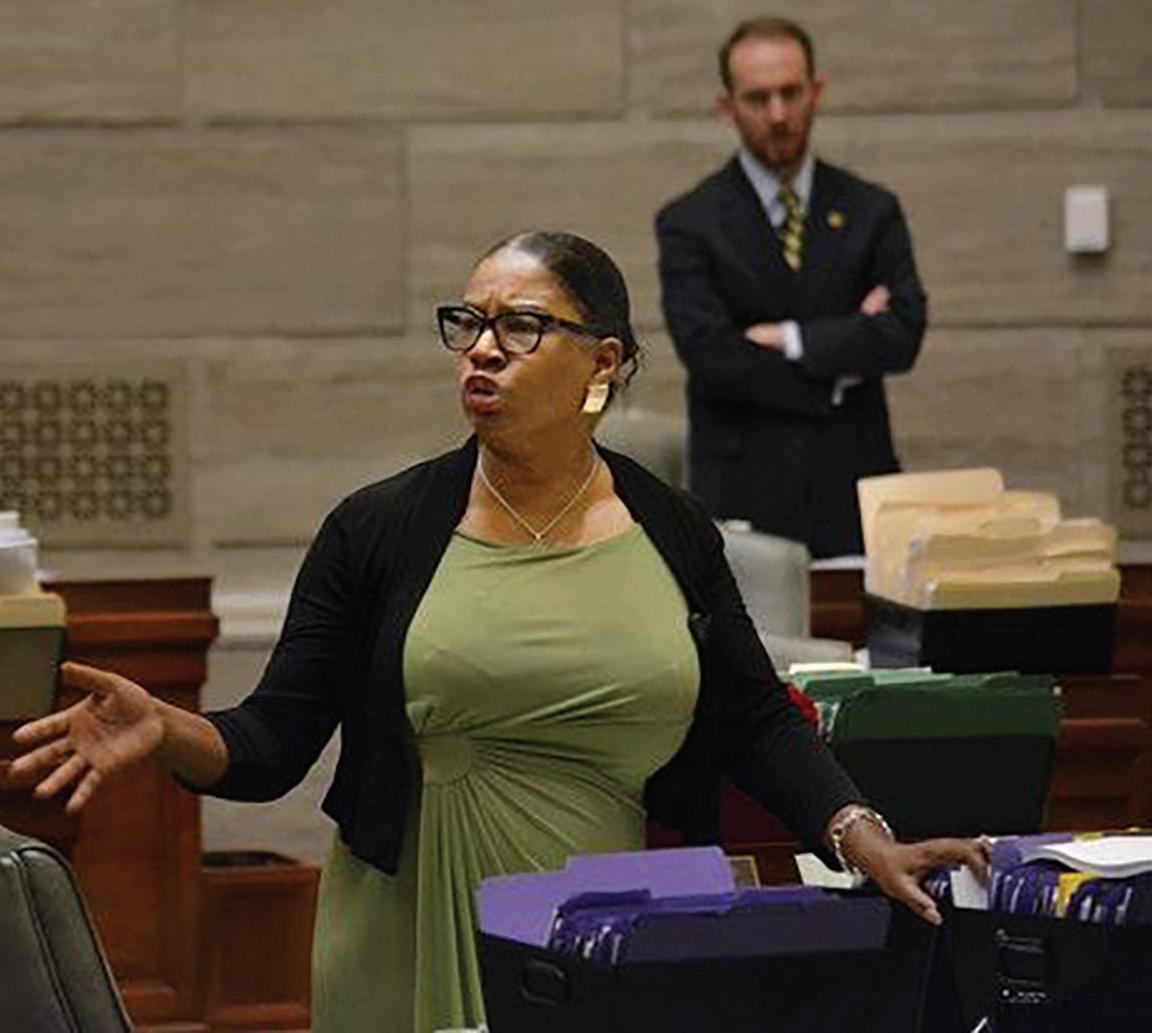
not obligate the state to pay that cost, Smith said.
“This budget tells them there is no money for the Medicaid expansion population,” he said.
“In my mind there is no need to enroll that population as there is no money to provide a benefit to them.”
But for Senate Majority Leader Caleb Rowden, R-Columbia, the budget approved Friday provides funding for everyone who is eligible for Medicaid in the new fiscal year. It may not be enough for the full year, but it doesn’t exclude those who become eligible on

July 1.
“My perspective has always been that, at the end of the day, if the governor doesn’t freeze enrollment of the new population when they are eligible, then there is money in the budget for those folks to enroll,” Rowden said.
The state has already submitted its coverage plan for federal approval.
The biggest question the courts will answer is whether the new section of the Missouri Constitution passed as Amendment 2 violated an existing section that prohibits initiatives
that appropriate money without providing a source of funds.
A pre-election court challenge to Amendment 2, arguing it violated that section, left the question unsettled.
State Rep. Sarah Unsicker (D-Shrewsbury) read a list of mostly rural counties where more than 20 percent of the population is uninsured. All voted against Medicaid expansion.
“If we don’t fund Medicaid, not only are we gambling with our federal funding, but we will also risk an expensive lawsuit,” Unsicker said.
State Sen. Karla May is among Democrats wondering how rural legislators can claim their constituents’ wishes are being ignored in regard to Medicaid expansion after more than 53 percent of Missourians approved it last August.
Photo
“I just hope that we don’t employ contract attorneys that charge $500 per hour like the Gaming Commission did last year, because spending money like that to keep from doing what voters decided is not fiscal responsibility.” During the debate, Republicans pointed to rate increases for many Medicaid providers and said the extra funds will help support existing Medicaid clients, who have the greatest need.




Spend nine minutes and 29 seconds to make a difference
“Stopping unemployment benefits just to force Missourians into jobs without a living wage will only increase the burden of poverty on our working families.”
-St. Louis Mayor Tishaura Jones
“[Parson’s announcement] is yet another massive failure that will put the lives and livelihoods of regular, everyday people at risk… I know what it’s like to work 40, 50, 60 hours a week and still not have enough to live.”
-U.S. Rep. Cori Bush
“If you’re having trouble hiring people pay more.”
-Kansas City Mayor Quinton Lucas
Gov. Mike Parson, playing the Republican Party’s national playbook, is cancelling federal unemployment benefits in mid-June. His decision will send thousands of Missourians back into poverty. (Parson’s action will end all of the COVID-19 programs, including the $300 additional weekly unemployment payment that was added to regular state unemployment programs.) The extra 13 weeks of income, in addition to the usual $20 given by the state, will also end.
The governor echoed other red state governors with his comment that, “Many business owners and employers across the state are still struggling. Not because of COVID-19, but because they can’t find people to fill the jobs. Continuing these programs only worsens the workplace issues we’re currently facing.” He didn’t add that they can’t find workers at the wages they are willing to pay.
Missouri has an unemployment rate of 4.2 percent. So it’s obvious that what the business community in this state wants and what a growing list of Republican governors in Alabama, Arkansas, Montana, South Carolina, Idaho and Tennessee have already done is giving the workers who will work the substandard wages they received before the pandemic.
Minority House Leader Crystal Quade rightly responded to the governor’s action, “The notion that Missourians are refusing to work so
they can temporarily collect $300 a week is an offensive right-wing myth.” According to the Kansas City Star, “the Missouri minimum wage is $412 a week. That’s below the poverty line for a three-person family. The maximum benefit in Missouri is $320 a week. To that, Washington added $300 a week in expanded unemployment benefits through early September. The combined benefit is enough to move the family of three out of poverty, if only for a few months.”
We agree with U.S. Commerce Secretary Gina Raimondo, who said last Sunday that nothing in the data suggests that enhanced unemployment checks are the reason people are out of work. Moreover, a Yale University study confirms that expanding unemployment did not dissuade people from seeking work.
Judy Conti, government affairs director of the National Employment Law Project, said that ending the additional federal unemployment benefit is, “ill informed and cruel. It’s still going to take awhile to get people back to work. When you choke off money from the unemployed, you’re only going to slow the recovery.”
What is missing fundamentally in this policy debate is the fact that working people should have a living wage. But just as importantly, these Republican governors are supporting a policy that is inherently “cruel and unjust.”
By Ben Jealous
Thanks to the voters who elected President Joe Biden and Vice President Kamala Harris, we now have a Department of Justice that actually cares about justice. And I am not just talking about justice as an idea. I am talking about a Department of Justice that is willing to take on abusive policing and law enforcement agencies that are corrupted by racism. In his first month on the job, U.S. Attorney General Merrick Garland reversed a Trumpera policy that made it harder for the Justice Department to investigate police departments and hold them accountable for violating people’s civil rights. And he was just getting started. In the past few weeks, the Justice Department has announced that it is starting an investigation of the police departments in Minneapolis—where George Floyd was murdered by former officer Derek Chauvin while other officers watched. The Minnesota AFL-CIO has called the city’s police union a white supremacist-led organization. The Justice Department has also launched an investigation of policing practices in Louisville, where Breonna Taylor was shot to death in her own home. These investigations will look at more than those individual killings. This kind of “patterns and practices” investigation looks at the big picture to determine whether and how a law enforcement agency is violating people’s civil rights. They are a way to evaluate—and do something about—the impact that systemic racism has in a police department and the communities it is supposed to serve.
“Patterns and practices” investigations can lead to consent decrees–agreements
that require police departments to change the way they operate, with oversight from the Justice Department to make sure change actually happens. In the past, Justice Department investigations and consent decrees have been important tools for getting violent police behavior under control and changing abusive cultures in out-of-control departments.
When the Trump administration shut down this kind of investigation, it sent a signal to police departments that the Justice Department would look the other way rather than hold them responsible for misconduct.
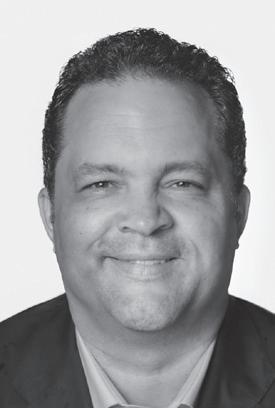
Of course, Trump himself repeatedly made it clear that he was not opposed to violent policing. In fact, he encouraged it.
President Biden has spoken personally about the importance of ending police violence and reimagining public safety. He has called on Congress to pass the imperfect but important George Floyd Justice in Policing Act. Another good sign was the announcement that the FBI is doing a civil rights investigation of the killing of Andrew Brown, Jr., who was shot in the back of the head by police in Elizabeth City, North Carolina.
All of these are important steps in protecting Americans, especially Black Americans, from abusive policing.
President Biden has also spoken out against Republicans’ racist efforts to pass new voting restrictions in states all over the country.
By Marc Morial
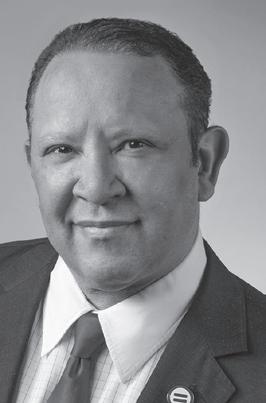
I just had the honor of delivering the commencement address at Tennessee State University. Like many historically black colleges and universities (HBCUs), TSU was born in the crucible of the age of segregation. It was born at a time when our forefathers and foremothers were escaping from the throes of the Ku Klux Klan. They were escaping from the pandemic of lynching which was sweeping the South.
If they lived in the 1870s, 1880s, and 1890s, they may have had a chance to vote. A chance to hold public office. A chance to own property. Then in the late 1896, the Supreme Court ruled in Plessy v. Ferguson that legal segregation did not violate the U.S. Constitution. For the sons and daughters of enslaved ancestors, that represented a great betrayal. And in those times, just imagine the courage it took, the determination it took for the sons and daughters, grandsons and granddaughters, of our enslaved ancestors, to aspire to a college education. That entire generation, faced with this betrayal, didn’t run for cover and they didn’t quit. They created great, historically Black colleges and universities. They created the NAACP and the organization I am proud to lead, the National Urban
Biden has called those efforts “sick” and we can count on his Justice Department to do what they can to challenge voter suppression—even though right-wing justices on the U.S. Supreme Court have greatly weakened the tools that the Voting Rights Act gave the department to prevent Black voters from having their rights denied.
The Justice Department’s Civil Rights Division has just written the Arizona Senate president to raise concerns that a bogus “audit” of ballots from last year’s presidential election that is being conducted by private contractors from the so-called “Stop the Steal” movement could be violating the Voting Rights Act.
There are more signs that we can expect changes at the Justice Department. Associate Attorney General Vanita Gupta, who was recently confirmed by the U.S. Senate, started her career as a civil rights attorney by winning freedom for dozens of mostly Black people wrongly jailed in a small Texas town.
The Senate should soon confirm Kristen Clarke to head the civil rights division, where she started her legal career investigating police conduct, hate crimes, and human trafficking. Together with President Biden and Attorney General Garland, Gupta and Clarke will save lives, defend civil rights, and give millions of Americans hope that greater justice is coming.
Ben Jealous serves as president of People For the American Way and People For the American Way Foundation. Jealous has decades of experience as a leader, coalition builder, campaigner for social justice and seasoned nonprofit executive. In 2008, he was chosen as the youngestever president and CEO of the NAACP.
League. They created the Alphas, the Kappas, the Omegas, the AKAs, the Deltas, Zeta Phi Beta, and all the rest. They created organizations of Black doctors, and nurses, and lawyers. And they were determined to strive against those difficult times.
What does that have to do with today? Well in 2020, the year just ended, our lives were upended by an invisible virus, an enemy we couldn’t see, and we couldn’t touch. But it could see us, it could touch us, it could infect us, and it did kill us.
And our lives were upended, by nine minutes and 29 seconds of a knee on the neck of our brother George Floyd in
n “If we can lift Black lives from the margins of society, we can lift all lives.”
– Jody David Armour USC Law Professor
Minneapolis. Nine minutes and 29 seconds that ignited a new flame of activism.
All of this presents a question to the Class of 2021 – a class that has withstood a year of virtual instruction, a massive wave of job loss, interacting from behind masks at a distance of six feet. The Class of 2021 has seen family members and friends fighting for their lives on ventilators. The Class of 2021 has overcome this invisible virus, and the challenge of those nine minutes and 29 seconds.
988 Line needs to be funded in Missouri
May is Mental Health Month. By urging my public officials to prioritize suicide prevention, mental health, and crisis care, I am hoping to influence collective change to support #MentalHealth4All.
Right now, individuals in crisis are able to call 1-800-273-8255 to reach the National Suicide Prevention Lifeline. The Lifeline provides 24/7, free and confidential support for people in distress and those that care for them. Soon, it will be much easier to remember how to reach the Lifeline as the number will be changing to “988” nationwide by July 2022.
And that question is: What will you do now? Will you become spectators, or will you seize the moment?
My charge to the Class of 2021 is to commit to nine minutes and 29 seconds each day to the fight for social justice and civil rights in this country.
Nine minutes and 28 seconds, spent urging the United States Senate to pass the George Floyd Justice in Policing Act. Nine minutes and 29 seconds spent telling states like Georgia: we will not be silent while you suppress our votes. Nine minutes and 29 seconds a day reaching back to your high school or community, serving as a role model and a guide for another young person. Nine minutes and 29 seconds, every day, to honor the memory of George Floyd and all the men and women who have lost their lives to racially motivated police violence. To honor the memory of the lives lost to structural racism in our health-care system during this awful pandemic.
Whether we graduated this week or 50 years ago, we all stand on the shoulders of the brave men and women who came before us, the men and women who built great universities in the crucible of Jim Crow, men and women who had the audacity to seek a college education against all odds. We all should remember their courage and carry it with us as we work to build a nation without racism, without poverty and without bitter division.
Marc H. Morial is president and CEO of the National Urban League, the nation’s largest historic civil rights and urban advocacy organization.
Knowing this, it is critically important that states pass legislation NOW to reliably fund 988 and their state’s crisis response system, just as we fund 911 and emergency services - through small fees on our phone bills. Reliable funding will help to ensure all 988 callers can reach a counselor in their own state who is familiar with and can connect them with local resources.
Kimberly Duprey
Keep up the fight for Medicaid expansion
Thank you St. Louis American and all your health partners and Dr. Denise Hooks-Anderson for continuing to fight for Medicaid expansion. Several of our extended family members fall into the 275,000 folks who are being left behind until this is approved. Voters throughout Missouri overwhelmingly said ‘yes’ to expansion, but then Jeff City government comes in and does what they do. What’s right is right and with God’s will this will all work out. I pray it works out sooner than later as many Black folks’ lives could be lost while waiting. Please keep fighting for the underserved.
Cicily Givens





If you need a summer job, the Urban League of Metropolitan St. Louis and STL Youths Jobs want to hear from you. The organizations are supporting summer employment opportunities for people ages 15-24.
“The Urban League is proud to partner once again with STL Youth Jobs to provide valuable learning and work opportunities for our youth,” said Michael P. McMillan, president and CEO of the Urban League.
“We know that providing early exposure to careers and the inclusion of caring mentors in a young person’s life can have a tremendous impact on their outlook and Future.” Applications are available for prospective employees and employers can check their eligibility and apply at www.stlyouthjobs.org until May 30.
STL Youth Jobs has provided paid work experience, job readiness training, financial literacy education and career and mentoring services to more than 4,500 youth since 2013.
More than 200 employers in 16 industries representing small and large businesses in the public and private sectors have been part of the summer jobs program.
McMillan said the coordinated system between the Urban League and STL Youth Jobs “creates a centralized
point of entry for all youth and businesses to participate”
The summer partnership offers employers an opportunity to meet summer staffing needs while training, mentoring and developing the future workforce. Businesses interested in providing summer work experiences are encouraged to sign up.
By supporting STL Youth Jobs, you are making an investment in ensuring our young people succeed and our community thrives,” said Hillary Frey, STL Youth Jobs executive director.
“Our community’s young people are the catalyst that is needed to increase the quality and inclusivity of the St. Louis workplace.
“The solution to creating inclusive economic growth is through the creation of access, opportunity and experience. By increasing local investment, partnerships and opportunities, we strive to create a network of stakeholders who are collectively focused on the future of St. Louis.”
It costs $2,600 to fund one summer job, including salary, job training, financial literacy education and job coaching.
STL Youth Jobs is seeking in-person and virtual opportunities for about 500 young people as the organization remains responsive to CDC guidelines and local public health restrictions related to COVID-19.
By ReShonda Tate Billingsley
I’m going to give Texas Republicans their props.
They are masters at “The sky is falling” messaging. Their latest ‘Theseminorities-are-trying-to-erase-us’ move is scaring white folks into believing that teaching students diversity is somehow a bad thing.
The Texas legislature is really introducing bills to change the state’s civic education curriculum by advancing bills that would restrict the discussion of current events and public policy in the classroom and prohibit critical race theory in public schools.
If you think that’s not a big deal, just look in Southlake, Texas, a community northwest of Dallas. ‘Anti-woke’ candidates who opposed critical race theory in schools swept local elections recently and took over the school board.

They managed to scare voters into rejecting a school diversity plan as an effort to indoctrinate students with a far-left ideology that would “institutionalize discrimination against white children and those with conservative Christian values.”
The landslide for conservative Republicans came nine months after progressives on the school board introduced a plan to install critical race theory in the local school curriculum and force educators to take diversity training and other so-called anti-racism courses.
They’re going to do everything they can to whitewash our history. Let us not forget the Dallas teacher last year who was teaching students that Black folks loved their masters and were happy to be slaves. Yeah, look for more of that with this move.
St. Louis American editor’s note:
In the affluent Rockwood School District in St. Louis County teachers are receiving threats of violence and death for planned curriculum that is in no way “critical mass theory.”
Mary LaPak, Rockwood School District spokesperson, has repeated that the district doesn’t teach “critical race theory,” adding the district’s curriculum meets Missouri learning standards.
She said Rockwood is “trying to implement a more inclusive curriculum and close racial disparities in discipline and test scores.”
But one parent commented, “Those who embrace critical race theory hold the belief that law and legal institutions in the U.S. are inherently racist. Other accusations include the district teaching students to become political activists and to feel guilty if they have white skin.”
Like Texas and other states controlled by Republican state legislatures, Missouri is getting in on the act.
Missouri state Rep. Nick Schroer has introduced an amendment to House Bill 1141 that would bar school districts from teaching “critical race theory.” Report for jury duty
The recent Jury Appreciation Week in Harris County (Texas) got me to thinking…How many of you got your notice for jury duty, then tossed it aside?
Wait, don’t answer that. Just know that doing that is something we as a people have got to stop.
The Derrick Chauvin case is proof positive of what’s possible when the makeup of a jury is racially diverse. The only way that’s going to happen is if we show up. So make sure you answer the call!
ReShonda Tate Billingsley is managing editor of the Houston-based Defender Network, which covers local and national news, sports and entertainment topics.

Continued from A1 employment with Concordance, which works exclusively with returnees. He was referring to statistics showing that more than two-thirds of individuals released from prison are rearrested within three to five years.
“We believe in getting our participants on a healing journey to help stabilize them,” Nunn said. “We have licensed clinicians who are addressing the therapy [needs] and the underlying trauma. We have education, job readiness and we’re addressing skills deficits.
“We are connecting and tethering all those services together,” he added. “It makes a difference when you take a holistic and integrated approach.”
Perhaps no region of the state has more to gain from addressing the issues of incarceration and recidivism than St. Louis city and county.
In the state’s fiscal year 2020, more people who were released on parole had been sentenced in St. Louis city or county than in any other area of the state -- 2,683 released inmates or 14 percent of the statewide total, according to data from the Missouri Department of Corrections.
Another 714 hailed from St. Charles County, which also is in Concordance’s service area. Usually, but not always, those leaving confinement seek the familiar and the familial, which means a return to the county where they were sentenced, according to the DOC.
The U.S. releases more than 600,000 people from prison each year, according to the federal Office of Disease Prevention and Health Promotion. Within 3 years of their release, more than half are incarcerated again.
Concordance serves about 250 new participants a year and plans to expand that number to 500 a year “and eventually to a thousand a year in the St. Louis market and in other geographic locations across the country as

well,” Nunn said. The Concordance business model, Nunn said, was created by researchers with the goal of reducing reincarceration rates by 33 percent. In the years since the program launched in 2016, the drop has been closer to 44 percent, Nunn said. “We’re serving the hardest to serve,” said Nunn, who formerly was vice chancellor for economic development and workforce solutions and an interim campus president with St. Louis Community College. “We’re taking on those indi-
viduals in the population who really need the help. We’ve been holding steady at a 44 percent reduction in reincarceration. We’re just very humbled by that.”
Armed with an annual budget of more than $3 million, including corporate support from Emerson Electric and Edward Jones, Connections to Success worked with about 545 new individuals in 2020, down somewhat from the 738 helped in 2019. In 2020 and 2019, about 70 percent of the participants had
previously been incarcerated, according to Brandi Jahnke, executive vice president of programs. Nearly 60 percent of the participants are men and 42 percent are women. Just over half are African American, and 36 percent are Caucasian.
The Connections model generally begins with pre-release training and continues with more “personal and professional development” once the participants are released from custody, said Ruth Lee, who has been chief executive of

Connections to Success since January.
The training ranges from sharing workplace skills to focusing on parenting and healthy relationships.
The organization has offices in St. Louis, St. Charles, Mo., Columbia, Mo., Kansas City, Mo., Kansas City, Kan. and East St. Louis, Ill.
Lee hopes to expand to Houston, where her team would train people to train others on the organization’s “personal professional,” model.
The organization also has been training some members of the Department of Corrections staff to deliver Connectionsstyle training to “returning citizens,” Jahnke said.
In a promotional video from a 2019 conference on reentry co-hosted by the DOC, Mataka Askari, who served 23 years in prison for a nonviolent drug crime, talked about the value of learning “new skills, new patterns of behavior” through Connections to Success.
“I believe in that stuff, “ said Askari, who in 1995 originally was sentenced to 30 years behind bars, and now works
for Connections to Success, “because I’m a living witness to it.”
For participants who are fully engaged with the program for at least the first 12 months, only “about 12 percent recidivate,” Jahnke said.
Stats like that, Nunn said, create a circle of winners. “We have an incredible vision about ... reducing reincarceration rates and not just for the numbers,” said Nunn. “But helping to ensure that the citizens can enjoy purposeful, abundant and joyful lives. That’s what you see behind the numbers: real people, you know, who are living their best lives.”
For more information contact Concordance Academy of Leadership https://concordanceacademy. org Connections to Success https://connectionstosuccess. org/
Karen Robinson-Jacobs is a business news reporter and a 2021-’22 @Report4America corps member.

Continued from A1
“Between failing locks, lackluster maintenance, and subhuman conditions for the detainees under our care, it only further justifies my promise to shut down the Workhouse within my first 100 days,” Jones wrote, in part. “We look forward to bringing effective leadership into the corrections division that can account for these issues and raise the bar on effective management and oversight of the City Justice Center.”
In her statement, Bush reiterated the deplorable conditions she and other local leaders witnessed during a tour of both the Workhouse and City Justice Center Jail late last month.
“Transforming our approach to public safety in St. Louis has been long overdue, and the Mayor’s bold and early leadership on this issue has been exemplary,” Bush wrote, in part. “We share a commitment to reducing harm in our communities and ending the cycles of trauma that have caused far too many of our neighbors to be locked up in our city’s jails.”
Since their late-April visit to both jails, Jones’ release stated that her administration has taken several actions, including reducing the jail overall population to 660 people.
In addition, the Civilian Oversight Board is collecting
Continued from A1
open.”
The march was one of “over 100 votercades” organized in “over 100 cities,” per the National Voting Rights Alliance website, marching against voter suppression laws currently being proposed in several states. The event began with a
filed complaints within the Department of Corrections dating back to 2017. The creation of this board was the number one recommendation of a task force assembled by then-Mayor Lyda Krewson to investigate the jails’ conditions. As for the jails’ operations, daily reports are now required regarding the delivery of meals to detainees, as well as the status of units and cells whose locks are still pending repair.
Jones and her staff have also scheduled listening sessions with Department of Corrections employees who have shared their concerns about the management of the two facilities.
There have been at least four major detainee uprisings since December — with the most recent taking place on the evening of Easter Sunday when inmates took over both the north and south side of the third floor of the City Justice Center. They broke the windows, started fires and threw debris down onto the street.
During a press conference the next day, Glass called attention to the community support the inmates have received.
“One of the things that concerns me in these types of situations is when the first events happened, we the public appeared to be condoning or justifying or lending cause to their behavior,” he said at the time. “And I’m not judgmental about that issue, but I would say it has a tendency to embolden.”
The third uprising occurred in early February, where 117
series of speakers, which included Mayor Tishaura Jones and Congresswoman Cori Bush, on the front steps of the historic Sumner building. It continued with a loud, horn honking, ‘votercade’ of cars winding through the Ville Neighborhood, and concluded with a gathering at Tandy Recreation Center.
The event featured mock voting booths to teach citizens about the process of voting in national and local elections.
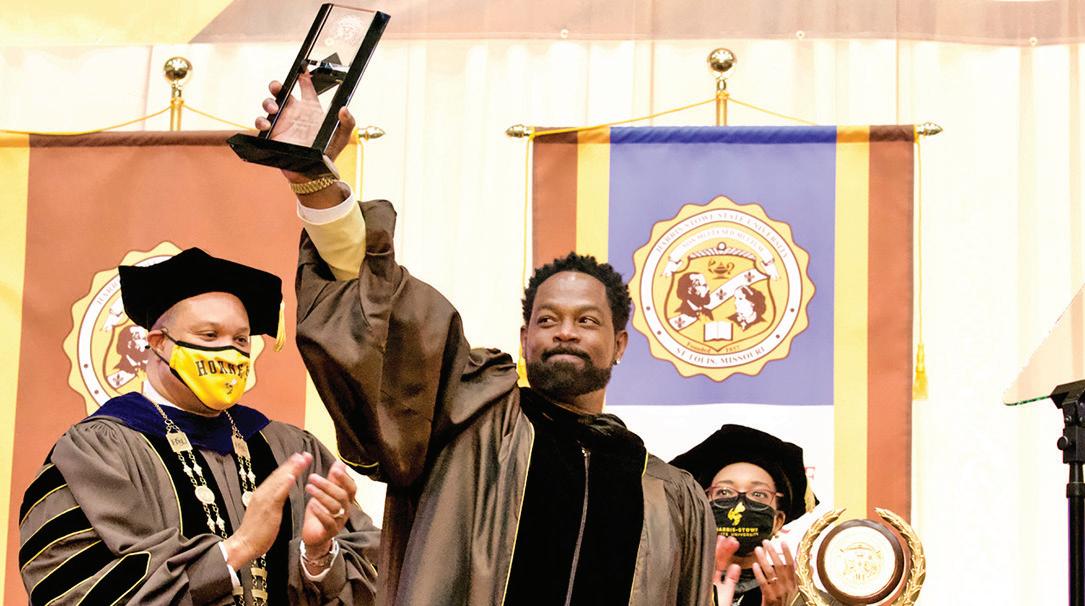
inmates took over the north side of the fourth floor of the jail, also breaking the windows and throwing debris down onto the sidewalk and street.
After that, Jimmie Edwards, the city’s public safety director at the time,
There were also booths connecting residents to St. Louis Community College and Urban League resources, and helping with the actual process of voter registration.
SLCC was also recruiting for its “Black Male Achievers” program, which helps Black high school senior boys in St. Louis prepare for college.
In a Real STL News livestream, an attendee spoke about his work with the Saint Louis University College Church

told the public that the cells’ “locks don’t necessarily lock” and that is how inmates were able to break free and overpower the correctional officer on duty.
The city approved $1.5 million to fix the locks in March, and last month Krewson said
ID and Birth Certificate program, which helps people gain access to the documentation needed for many forms of employment, medical access, and other necessities.
“A lot of the people who I’ve spoken with have just come out of incarceration,” he said. “And they’ve got nobody helping them…we help people like that.”
This event came as several bills restricting voting are proposed across the country—the
the work should be completed in May.
Two other protests occurred just before and on New Year’s Day. Each time, the inmates refused to return to their cells in protest of inadequate protections against COVID-19 for those being held there.
most headline-grabbing being in Georgia, where state law mandates that handing water or food to those standing in line to vote could become a criminal offense.
In Missouri, voter restriction and gerrymandering as strategies of voter suppression are not uncommon: the most recent bill would make the photo ID requirements to vote significantly more stringent, disenfranchising voters who may not have access to the
Following each protest, groups of inmates were transferred to the Workhouse, which had been slated to be closed Dec. 31, 2020. Fifty-six people were transferred from the Justice Center to the Workhouse on Dec. 29, followed by 45 on Jan. 1.
necessary documentation.
“Legislators are pushing forward the effort to pass a confusing amendment in order to implement a restrictive photo ID law they knew was unconstitutional,” Nimrod Chapel, NAACP Missouri State Conference president told KSDK.
“We will work with the community to make sure the rights of Missouri voters are restored and everyone can have their vote counted.”



After Black activists saw police reform efforts fail, they came up with new plan
Continued from A1
appeared on the Zoom.
Jokingly, she told Strode to “calm down,” though in truth, she was trying to calm herself.
Six of the seven St. Louis aldermen the Action St. Louis Power Project endorsed were in the lead, she told Strode.
But the most important race – the one to decide the next St. Louis mayor — was still too close to call.
Every time she had been maced by police while protesting in the streets of Ferguson. Every time she’d fought for police reforms from the outside. Every time their demands were put on the shelf. The thousands of doors she’d knocked on the past five years — all of it led up to this moment.
Reed wasn’t the only one on the Zoom call who was stressing about the election. The tight group of organizers had been fighting side by side since 2014 and understood how high the stakes were for their city — and for the future of Black lives across the country.
They tried to inoculate themselves against the bitter disappointment they feared might await them at the end of the night. Ferguson front-line protester Brittany Ferrell told Reed that prior generations would be proud of Action St. Louis and the movement they’d built.
“I wish my granny was alive to see this,” Ferrell said. Then two hours after the polls closed, the final results came in.
Tishaura Jones – whom Reed had been trying to get elected for four years – would become the first African American woman to lead the city
Rather than screaming in celebration, the group held several minutes of respectful silence, as Reed sobbed.
Ferrell and Strode quietly congratulated her on the screen. Her partner, who had just arrived at the Action office, held her. Reed remembered all the years of work, all the walls they’d run into. “I just remember what it feels like,” she said through tears.
“So much is possible.”
St. Louis is among the most segregated cities in the country. The northern half of the city, which is about 90% Black, has suffered decades of disinvestment, while other, whiter areas in the city have benefited from tax incentives for development and job creation.
This inequity is at the heart of the Ferguson uprising.
Following Michael Brown’s shooting death in 2014, thenGov. Jay Nixon established the Ferguson Commission to study the underlying conditions that led to the uprising. Its People’s Report” ultimately laid out 189 recommendations for addressing systemic racism, from housing and economic injustices to a lack of police accountability. None of the police reforms have been fully put in place. As Reed and a new generation of leaders saw each of their reform efforts fail to curb police violence, they soon realized that what they really had to overcome was the police union’s political force in local elections.
So she set out on a larger mission: to build a political movement so appealing and so powerful that it would win control over the levers of power at the Police Department. Now, Reed is on the cusp of realizing her vision. Jones was sworn in April 20, and Reed is serving as an adviser. What Reed and Jones do in the coming years could provide a resounding answer to the question of whether policing in America can truly be reformed. They’re already at work.
On Jones’ ninth day in office, she proposed taking $4 million away from the police budget and reallocating some toward hiring social workers who can answer calls related to mental illness and drug addiction.

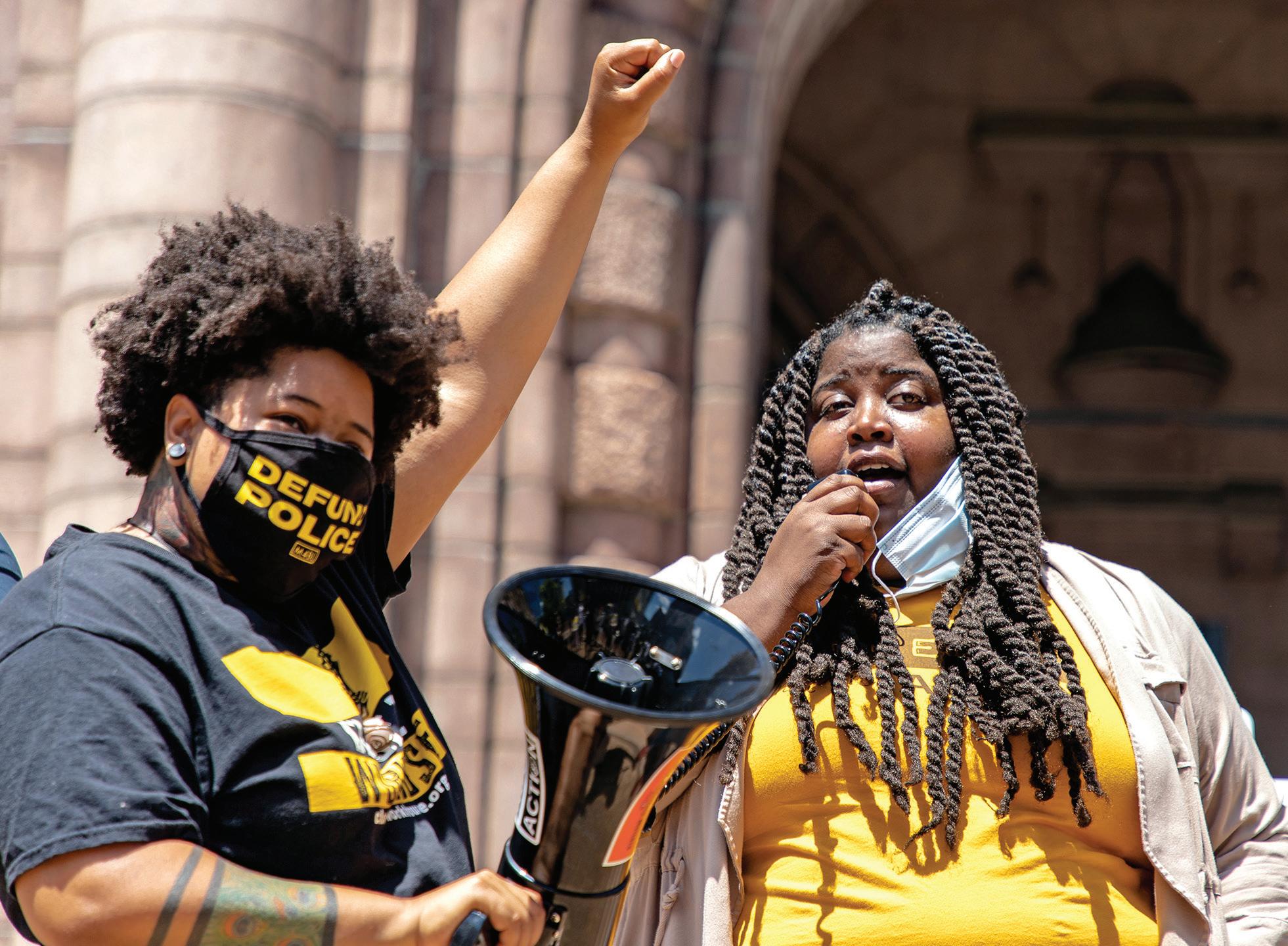
Just as St. Louis’ experience shows how police reform fails, Reed’s journey is inspiring activists across the country as they try to build a new power structure and protect Black communities from state-sanctioned violence.
“Now what we’re seeing is folks are kind of skipping that stage that Ferguson went through,” Reed said. “And they’re like, ‘OK, we saw that that didn’t work. How do we get to where you are quicker?’”
The day everything changed
Reed was working part time at a local furniture outlet store on the muggy afternoon of Saturday, Aug. 9, 2014, when she got a text message from rapper and activist Tef Poe. An unarmed Black 18-year-old named Michael Brown had been shot and killed by a white police officer, Darren Wilson, in the suburb of Ferguson, just a mile from her apartment. Brown’s body lay in the middle of the street for hundreds of Black neighbors in the Canfield Green apartment complex to see – for four hours.
Reed saw the heartbreaking photo on social media of Brown’s stepfather holding a handwritten cardboard sign stating, “Ferguson police just executed my unarmed son!!!” It all compelled her to go to the scene when she got off work.
There, she ran into old friends from high school. She saw friends who lived in the same complex. They were hurt and grieving.
“Growing up in North County with brothers who are the same height as Michael Brown, same complexion as Michael Brown, you just felt like this could have been any incident,” Reed said, “us walking home from school or to the park.”
She remembers the day turning to dusk as police officers got out of their cars with cans full of mace and attack dogs at their sides.
“They were just responding to people mourning out loud, and that just created such a deep frustration within the community,” Reed said.
At first, it was that grief and fury that drove Reed to the protests every night. What kept her going was an urgent need to protect future generations in her community and beyond.
“Folks gravitated toward Ferguson after Mike Brown was killed, in part, because they had interfaced with the systems that produced Darren Wilson,” Reed said, “and in order to ensure more Black children are not gunned down.”
She would get off work from her weekday job as a pharmacy technician at 6 p.m., then run home to change and eat dinner. An hour later, she’d be at the protests in front of the
Ferguson Police Department, staying until 3 a.m. With only a few hours of sleep, she’d be back at work at 9 a.m. This was her schedule for months.
Sometimes she was leading chants, but a lot of times, she was the one telling jokes to lighten the mood. Like at the candlelight vigil for 18-yearold VonDerrit Myers Jr., who was killed by an off-duty officer two months after Brown as he went to get a sandwich. After a woman got candle wax on her forehead, Reed made sure she was OK. Then she told her it was just “free brows.”
“This work is really heavy, and I cope with it with humor,” Reed said. “Laughter connects people in the same way that food does.”
When Reed was old enough to drive, her parents warned her about the dangers of being stopped by police and how to keep your hands where police can see them. But Ferguson made it visceral in a way no talk could.
“You don’t know that you’re breathing bad air until someone tells you because that’s just what you’ve been in,” Reed said. She started working with the Organization for Black Struggle, a group founded by Black activists who had been fighting systemic racism since the 1960s. She learned how the region’s long history of redlin-
ing, separate but unequal education and the mass incarceration of Black people were the fuel that fed the uprising. The Ferguson Commission came to similar conclusions when it issued its report in fall 2015. At the commission meetings, Reed heard discussions about well-documented disparities in policing, like the traffic stop report that the Missouri attorney general’s office released every year. Black drivers were nearly twice as likely to be stopped by St. Louis city police as white drivers, according to the attorney general Around the country, for young Black men and women – like Daunte Wright Sandra Bland and Philando Castile – a simple traffic stop can be deadly. Understanding how pervasive racism is in her region was an epiphany that put Reed on a path to becoming one of the leading voices in St. Louis’ public life and, ultimately, a queenmaker.
“I wasn’t an abolitionist,” she said. “I wasn’t a Black feminist. I didn’t have a critique of capitalism. I was just a person who lived in St. Louis who believed Mike Brown shouldn’t have died that day.”
She quit her pharmacy job in November 2014 and threw herself into organizing full time with the Organization for Black Struggle.
how
as
the
is
activists across the country as they try to build a new political power structure and protect Black communities from state-sanctioned violence.
The fallout from Ferguson
The Ferguson Commission offered a searing critique of structural racism across one of America’s major cities. It grabbed attention and galvanized action, including establishing a Racial Healing and Justice Fund for the region and increasing financial empowerment education to combat poverty.
But on police matters, the report’s been a dud. The commission recommended 16 police reforms, 13 of which were directly relevant to the city of St. Louis, including the creation of a civilian board to independently review police investigations into allegations of misconduct.
Not one of the recommendations has been fully completed, according to a 2019 study by Forward Through Ferguson the nonprofit organization that was created to monitor the implementation of the commission’s calls to action. Take the St. Louis Civilian Oversight Board. The board has not reviewed a single one of the more than 50 cases in which police shot someone since 2015. Forward Through Ferguson classified the creation of the board as a “policy change that meets the letter, but not neces-
sarily the intent of the call to action.”
Five of the report’s recommendations for the St. Louis Metropolitan Police Department received the same assessment. Only one measure, an increase in police training, was considered to even potentially be leading to change.
The Police Department and the officers union have managed to stifle the success of the reforms, whether by testifying against measures at City Hall or undermining the reforms that did pass.
“It is unequivocally true that the police union is the main opposition to any sort of movement toward accountability and reform,” Reed said.
The union says it is not anti-reform, but merely fighting for the due process rights of its members. The Police Department didn’t respond to requests for comment for this series.
As the leader of Forward Through Ferguson, David Dwight has spent the last several years closely monitoring the progress of police reform. He eventually came to the same conclusion as Reed: The transformation of public safety could happen only if there were a transformational shift in political power.
“I think white supremacy eats programmatic change for lunch,” Dwight said.
The activists began to focus on what they called “re-envisioning public safety.” But that phrase didn’t get much traction until 2020, when protestors started chanting, “Defund the police.” The chant was meant to be confrontational in order to get people’s attention, and it worked.
To that end, Forward Through Ferguson and Action St. Louis are among more than 40 organizations that signed onto The People’s Plan this January, which Reed describes as “a holistic vision of what St. Louis needs to do for communities to thrive.” For public safety, the plan envisions reducing potentially aggressive police interactions by decriminalizing drug addiction, mental illness and poverty. The groups want to divest from police overtime, the SWAT team and surveillance. And they want to invest in nonviolent first responders who understand how to address mental illness, and even traffic stops, without using force.
The plan is to realign the city’s budget to reflect this new vision of public safety. The Police Department makes up about a third of the city’s general revenue fund; Jones is already beginning to direct more of those funds to human services.
“That’s so much of what ‘Defund the Police’ is about at its essence,” Dwight said.
“How are we reducing the systems that are actually perpetuating inequity and disproportionately hurting people of color.”
How Reed built political power
As Kayla Reed made her strategic shift, the circuit attorney seat was up for grabs in 2016. This was the person in charge of criminal prosecutions in St. Louis, an elected official with the power to prosecute police.
“We decided to say, ‘Well, how can we put our hands on the scale?’ ” Reed said. “We’re organizers. We talk to people, we mobilize them to action. Can we mobilize them to take an action and vote a particular way?”
This was the moment Reed and a coalition of organizers and protesters decided to take a giant leap into the political realm.
Largely led by Reed and fellow activist the Rev. Michelle Higgins, the group’s goal was to not only build a successful political movement to address inequities, but one that Black millennials could call home. Organizers enticed these young voters by essentially holding events that they themselves would want to go to. They hosted regular #WokeVoterSTL brunches, where attendees could sip mimosas, listen to music and hear about issues on the ballot. Part of their genius was to make politics – which had long

felt alienating to young Black people – totally accessible, said Blake Strode, executive director of the nonprofit law firm ArchCity Defenders.
“It’s just, like, a cool hangout event, where also you learn some political information,” he said.
At one of the group’s first big projects, Strode and Reed moderated a candidate forum for the circuit attorney contest – a debate that had previously been hosted only by local news outlets and the League of Women Voters. In a race that rarely got much attention, they packed a university auditorium with young voters, standing room only.
Their candidate, Kimberly Gardner, ended up winning the race — beating the police union’s choice.
It eventually stopped being a side project and became their calling, giving rise to what is now Action St. Louis.
The first candidate Action St. Louis officially backed was Tishaura Jones; the city treasurer ran for mayor in spring 2017 on a criminal justice reform platform. Again, Strode and Reed led a debate for the mayoral candidates, peppered with comic bantering. And this time, it drew so many young people that hundreds had to sit on the floor
Jones lost by less than 900 votes.
“It was hard because I thought we did everything we could do,” Reed said. “I mean, now I realize we didn’t do much of anything that we could do.”
In that 2017 mayor’s race, Reed estimates that her team knocked on about 1,000 doors, urging residents to vote for the candidate who they believed was going to address the racial inequities that the Ferguson report had outlined.
“That’s when we understood we had a lot of narrative power,” she said. “People looked to us for guidance. But we didn’t have the organizing power yet.”
They didn’t have long to gain that organizing power.
Then-St. Louis County Prosecutor Bob McCulloch had managed the grand jury process after Ferguson, in which jurors chose not to indict Darren Wilson. And McCulloch was up for re-election in 2018
“I said at the time, a glass of water could have ran against Bob McCulloch, and I would’ve campaigned for it,” Reed said.
She knocked on doors after classes, without getting a paycheck. She led teams of canvassers on the weekends.
Activist Brittany Packnett Cunningham, who served as a Ferguson Commission member, remembers arriving at Action’s campaign office one weekend.
“It looks like a film where you’re seeing somebody’s presidential campaign office,” she said. “It is that full in there.”
Reed was in the middle, managing the chaos and putting everyone to work, while still making everyone laugh.
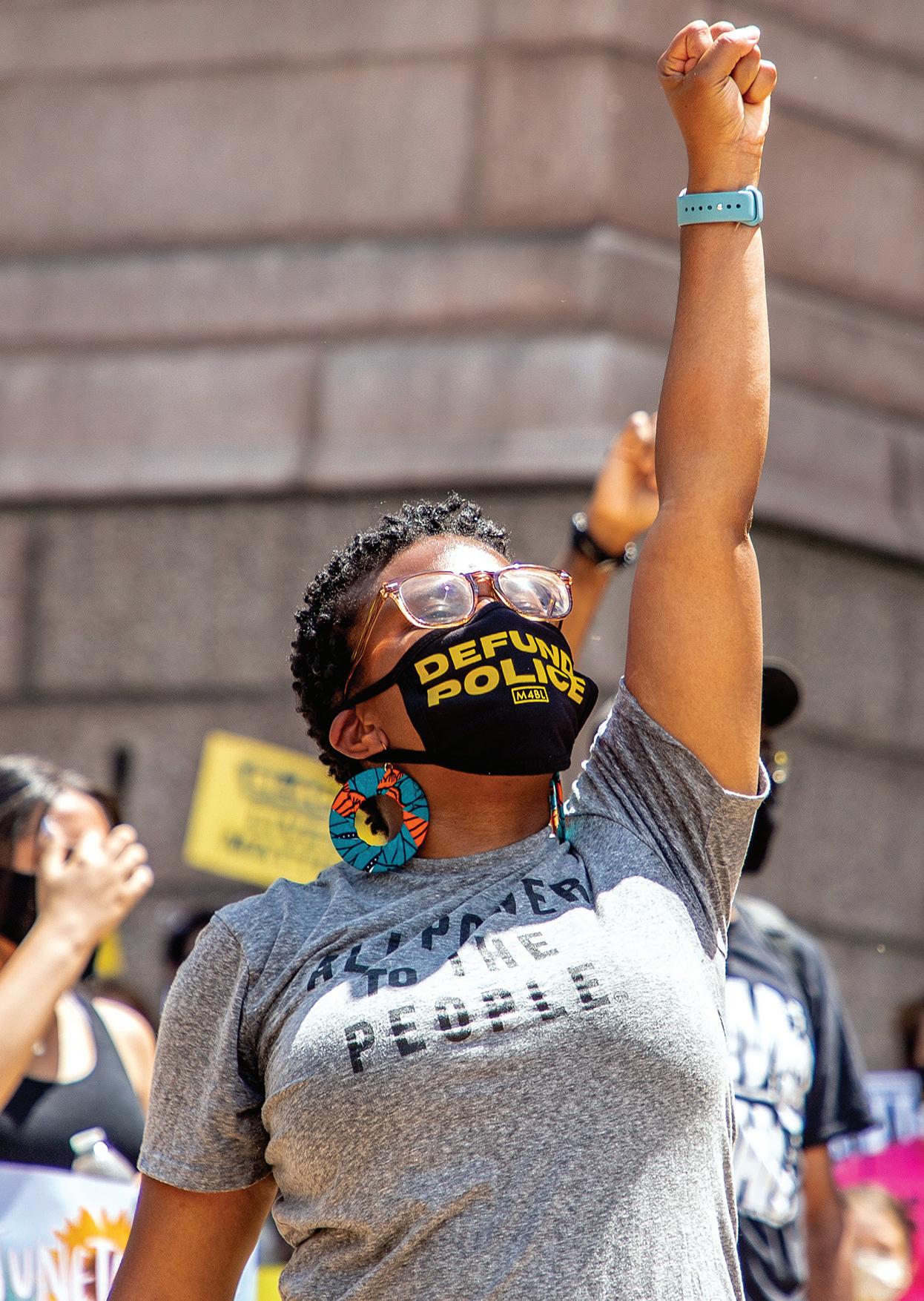
“It just felt like a place that you wanted to be, that you wanted to come commit to,” Cunningham said.
Action St. Louis and the coalition faced an even tougher battle than in the mayor’s race because St. Louis County is more conservative than the city. McCulloch was the status quo Democrat, who had been in office since 1991. So it shocked the region when Reed’s candidate, Wesley Bell, a former Ferguson City Council member, won by 13 percentage points.
The election happened Aug. 7, 2018 — almost four years to the day after Brown was killed — making Bell the first African American to be elected prosecutor for St. Louis County.
Bell’s race taught Reed and her allies a critical lesson.
“People don’t really answer numbers they don’t know,” she said. “They don’t want to stay on the phone for a long time.”
But on a sunny day close to an election, people are more likely to have conversations
with voters like them, the people who knocked on doors for Action St. Louis. Reed needed to hire more staff and expand the coalition to get more door-knocking hands and more feet.
They also had to constantly engage voters in racial justice efforts, prioritizing ending cash bail and closing a local jail, known as the Workhouse, that has long been criticized by advocates for its inhumane conditions. They demanded that any candidate running for office be accountable to their agenda.
And that’s what the coalition has been working on for the last three years. Action St. Louis now employs eight people. This spring, Reed says they knocked on 25,000 doors to get Tishaura Jones elected, made more than 230,000 calls and sent 100,000 text messages. Before the results came in on election night, Reed’s exhausted team gathered around the island in their office kitchen for a drink. Reed gave a speech about how much
Black people in St. Louis have lost — their children, their history, their resources and voices.
But the political movement that they’ve built since Ferguson was “wilder than our ancestors thought possible,” Reed said.
One of the men on her team was 15 when Brown was killed. Others were in their teens as well. They’re now being led by a 31-year-old Black woman, who was working as a pharmacy technician six years ago because nursing school had been too expensive.
For every single one of these young activists, the trajectory of their lives changed the moment Brown was killed.
“If tonight comes in the way I feel in my bones, it is because movement chose her and movement built itself to be able to win — to place her in the seat,” Reed said of Jones. Action St. Louis’ wins didn’t end at Jones. It also flipped the Board of Aldermen, which is now dominated by elected officials committed to re-envisioning public safety.
Mayor’s new agenda takes shape
Jones took her oath as mayor April 20. Her plan for public safety includes redirecting 911 calls related to mental health and drug addiction away from the Police Department. She plans to put more money into affordable housing, job training and better access to health care. And she plans on closing the Workhouse.
“I think the police are terrified of Tishaura Jones’ candidacy because they see her like they see Black protesters,” Reed said.
But the police union is scared of Reed and Action St. Louis too, Jones said. Reed and the coalition have amassed more political power than the police union, a feat unthinkable just six years ago.
“Citywide, no one matches their ground game. No one matches their effort,” Jones said. “So they are becoming the endorsement to have or the backing to have in order to get elected.”
Jay Schroeder, president of the police officers union, said he’s aware of the changing political landscape.
“We have to get more active in the political scene in St. Louis city,” he said. “There’s going to be a bad situation with a policeman. It’s going to happen. But we need to get our message out — that you’re talking about the smallest percentage of things.”
Reed’s movement is built on a different message: The problem isn’t a few bad apples, it’s the entire system. And leaders and activists around the country have been watching Action St. Louis and taking cues on its successes. Reed co-hosted the Black National Convention in August, a virtual event designed to empower organizers in cities across the United States that drew thousands.
When Brittany Packnett Cunningham was leading classes as a fellow at Harvard’s Institute of Politics, she brought Reed in twice to speak. She said Reed was at the top of her students’ list of favorite speakers because of her “political creativity.”
“They’re never just pulling on one lever,” she said. “They are thinking creatively about how we’re building at the base.”
They look at electoral maps, she said, city budgets and creative ways to fund racial justice initiatives and recruit more canvassers.
“You actually have to engage the entire system and make it bend to your will, instead of you bend to it,” Cunningham said. “And that’s why I think Action St. Louis does so well.”
Reveal reporter Trey Bundy contributed to this story. It was edited by Andrew Donohue, Jason Hancock and Nina Martin. Kenya Vaughn was a contributing editor. It was fact checked by Liz Boyd and

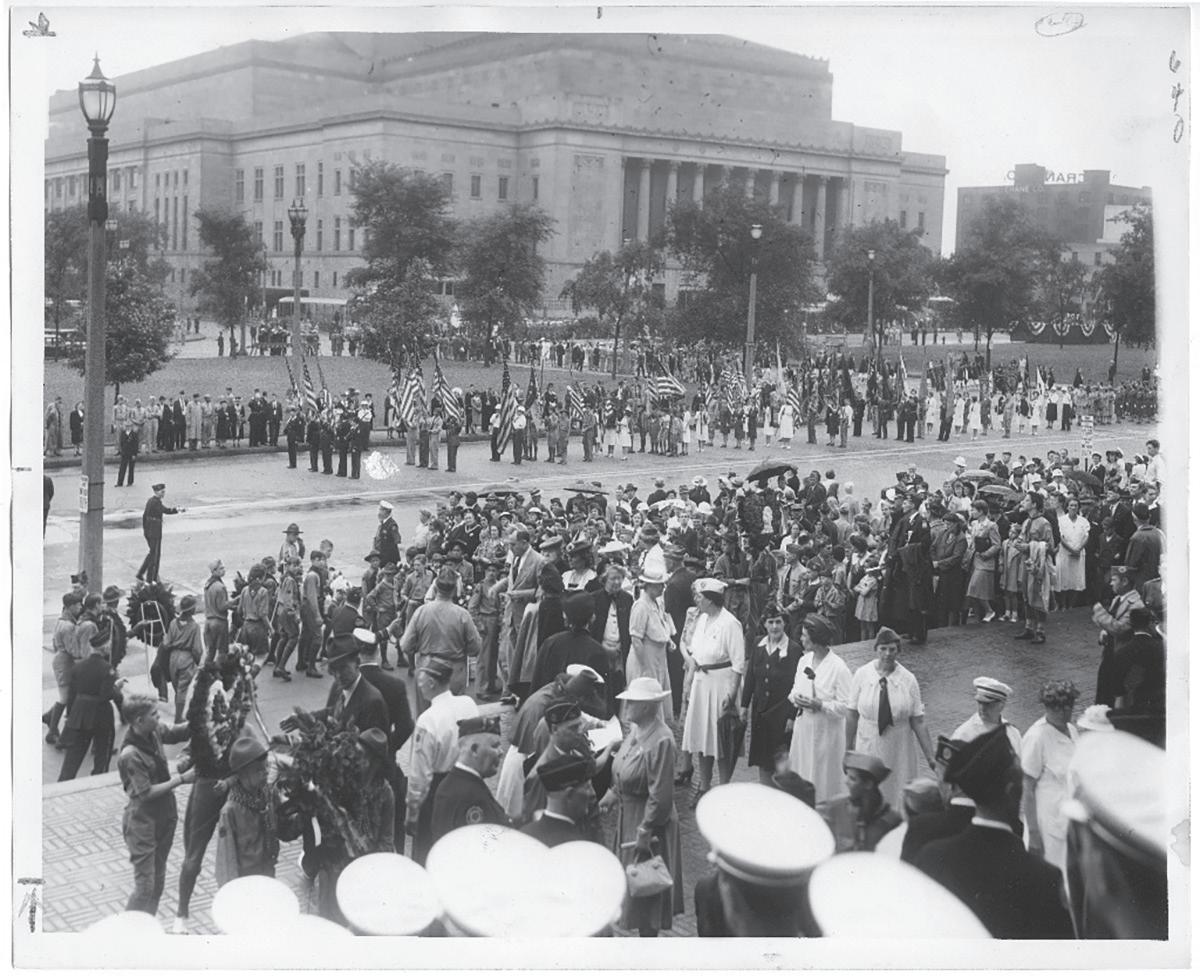
By Jamie Biesanz Soldiers Memorial Military Museum
Memorial Day—originally called Decoration Day—was created to memorialize the hundreds of thousands of Americans who made the ultimate sacrifice in the Civil War. The first official ceremony for Decoration Day was at Arlington National Cemetery in 1868. However, this was not the first or only memorial service related to the Civil War. One early example was obscure until relatively recently. After the Confederates evacuated Charleston, South Carolina, newly free Blacks and several white missionaries reburied the bodies of hundreds of Union prisoners who had been buried in a mass grave at a local Confederate prison camp. A ceremony attended by about 10,000 people included music, Bible verses, and marches performed by US Colored Troops regiments. David Blight, author of Race and Reunion: The Civil War in American Memory, argues that the memory of this event was suppressed because it didn’t fit the war narrative preferred by white Confederate sympathizers after Reconstruction.
Memorial Day was historically observed on May 30 because it wasn’t the anniversary of any Civil War battle and flowers for graves were widely available at this time of year. In 1968, Congress moved Memorial Day from May 30 to the last Monday in May to create a three-day weekend. Hawaii senator and World War II veteran Daniel Inouye (D-Hawaii) introduced legislation to move the date back to May 30 in each congressional session between 1987 and his death in 2012. Some veterans’ groups, like the Veterans of Foreign Wars, continue to advocate for a return to the May 30 date to encourage Americans to see it as a day of remembrance rather than the start of summer. While Memorial Day continues to be a three-day weekend, we can honor the St. Louisans who gave their lives in service at Soldiers Memorial and remember some of their stories.
Robert and Russell Roehr were twin brothers from St. Louis who registered for the military draft on their 18th birthday on June 1, 1943. In the military they went their separate ways, serving in different branches and theaters: Russell with the US Army in Europe, Robert with the US Navy in the Pacific. One month after his 19th
birthday, Corporal Russell Roehr was killed by artillery fragments during the Normandy cam paign. Less than a year later on May 4, 1945, four kamikaze aircraft crashed into Robert’s ship, the USS Morrison. The ship sank so quickly that half the crew were lost. Among them was Seaman 1st Class Robert Roehr. Russell Roehr was laid to rest at Memorial Park Cemetery in Jennings on May 28, 1948. Robert’s remains were never recovered. The twin brothers’ names are inscribed next to each other in the Court of Honor at Soldiers Memorial. Robert’s name is also inscribed in the Courts of the Missing at the National Memorial Cemetery of the Pacific in Honolulu.





Another St. Louisan memorialized at Soldiers Memorial’s Court of Honor is Dierother Brown, who was born in Mississippi in 1944 and later moved to St. Louis. Following his graduation from Vashon High School in 1963, Brown enlist ed in the US Army and was sent to Vietnam. On February 1, 1968, SSgt. Brown was killed by an explosive device near the village of An My. He is interred at Jefferson Barracks National Cemetery.

Terri Sue Fussner attended Parkway South High School, where she was a star athlete and National Honor Society member. She graduated from the US Naval Academy in 1996 and was assigned as a Navy flight instructor. On March 12, 2002, she was killed alongside two other sailors when her SH-60B Seahawk helicopter crashed in the Mediterranean Sea during a routine training flight. She is buried at the US Naval Academy Cemetery, and her name is listed in the Court of Honor at Soldiers Memorial.
On Memorial Day, Monday, May 31, Soldiers Memorial will be open from 10am to 5pm. Wreaths will be placed at each of the memorials, and visitors who wish to participate will be provided with flowers. Free one-hour outdoor tours will be offered on a first-come, firstserved basis at 10:30am, 12:30pm, 2:00pm, and 3:30pm. Videos honoring the three individuals listed above, as well as three videos produced for Memorial Day 2020, will be shared on the Missouri Historical Society’s YouTube channel.
For more information about the Memorial Day event, including COVID-19 restrictions, visit mohistory.org/memorial.









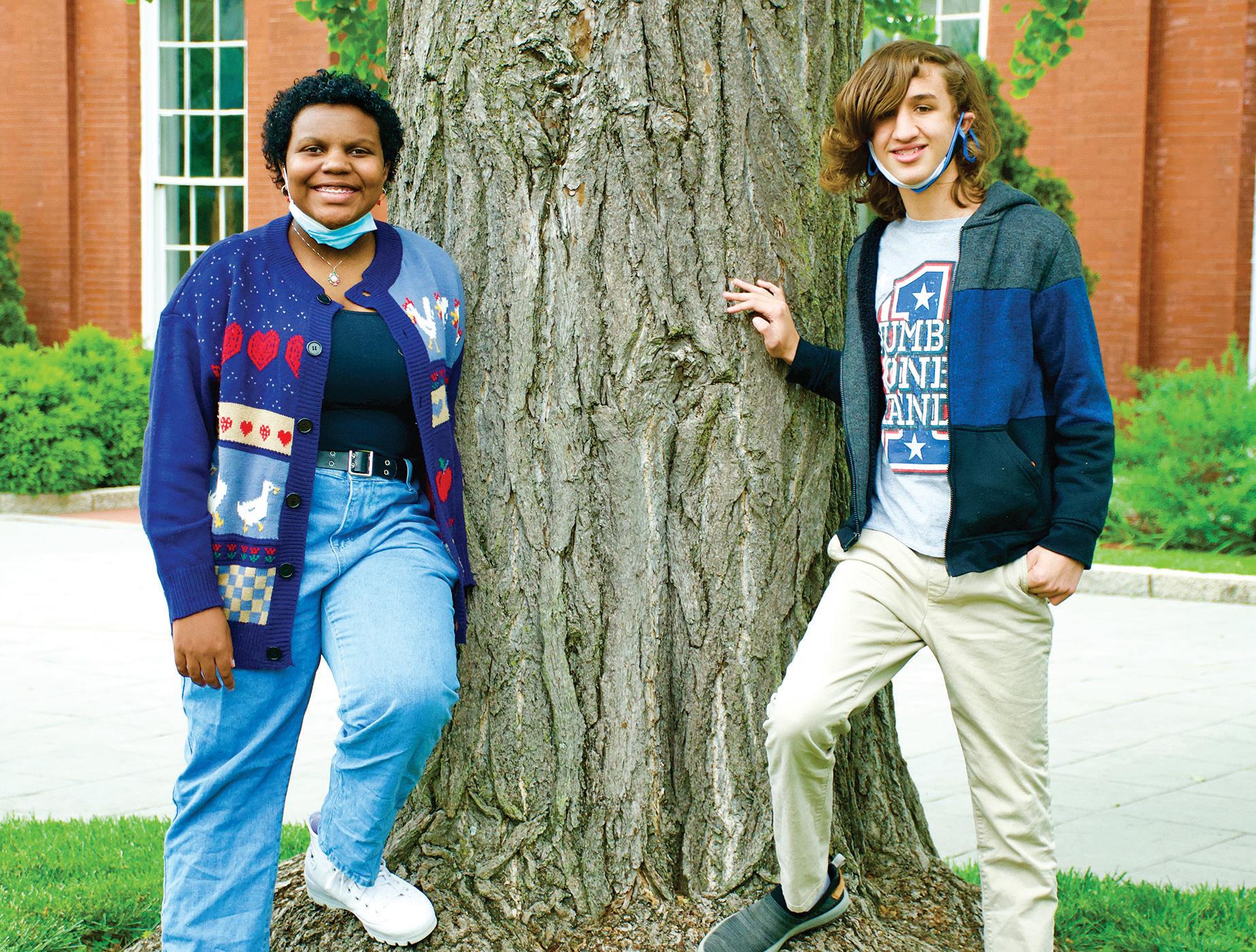
Sylvester Brown, Jr.
Of the St. Louis American
For a 12-year-old, Milo Marston has some very grown-up thoughts about politics and the spread of the coronavirus in the United States.
“It was so ridiculous that (President Donald Trump) politicized the virus in the name of delusional, macho posturing,” he
n “Part of me doesn’t really trust the vaccine. But, on the other hand, I can see how it can help, especially since the country is trying to get back to normal.”
– Jayla Williams, 16
said. Marston had an equally layered answer when asked about adults who refuse to wear masks to ward off infections or will get vaccinated.

“That all seems kinda stupid to me. It seemed to be just another outgrowth of the fake news and political stigma that’s been cropping up over the years,” he explained. It is obvious this 7th grader at Kairos Academies Charter School in the city is the product of engaged parenting. His father, Brian Marston, is the director of web technology at Washington University. His mother, Amanda Doyle, is author of several books. Their passions seem to have impacted their son, who remembers attending rallies and marches on
See YOUTHS, A13
Though we celebrated Mother’s Day on May 9, my focus today is on those special men in our lives.
For men who spent time teaching their children how to ride a bike or drive a car, who provided the midnight feedings so their spouses could sleep, who requested that their daughters change clothes when they were too revealing and for those awesome men who taught their sons how to be a man, we salute you!
It is with that appreciation that I want to focus our attention this week on the health and well-being of one of God’s greatest creations.
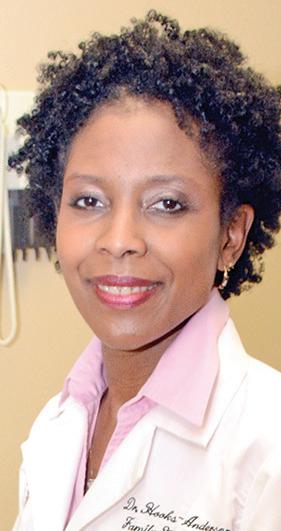
If you scan medical offices across the country, most people sitting there would be women.
The lone exception would be at a veteran’s facility. You would think, since women live longer than men on average by almost five years, that men would frequent the doctor more often so they could improve their odds.
However, as we all know that is not the case. In my practice, most of my male clients who are present for the first time are doing so either because their significant other or a co-worker has harassed them into making an appointment or because they have a specific concern.
n The argument that “I feel fine” is not enough to justify not seeing your doctor regularly.
There are many theories as to why men do not see the doctor on a regular basis, one of which is stoicism. Men may equate seeing their health provider with vulnerability. My counteroffer to this belief is that preventing disease is always easier than trying to treat it. We should remind our male loved ones that independence becomes difficult once a person has multiple illnesses, hospitalizations, etc.
Another reason for lack of participation in the healthcare system by men, and the one probably most cited by my patients, is fear of a
See
A13
By Kayla Drake St. Louis Public Radio
Homeless shelters and service providers in the St. Louis region are leaning on the trust they’ve fostered for years in the homeless community to get COVID-19 vaccines in arms. So far, it’s working. Organizations including St. Patrick Center, Peter and Paul Community Services, St. Vincent de Paul and City Hope have helped vaccinate nearly 400 people since March. Leaders and caseworkers at the nonprofits say personal relationships have been key to that success.
“In working with the unhoused community, trust is a major issue,” City Hope CEO Michael Robinson said. “Our guests have grown to love and trust us because of the way that we treat them and assist them. That helps to bring some of the level of anxiety
n St. Patrick Center hosted its second vaccine clinic, which was open to anyone, on May 5. People who use the center’s services walked into a room of familiar faces, as case managers volunteered to sign people in and hand out coffee.
and scrutiny down because most of them don’t believe that we would do anything that would harm them.”
St. Louis-area providers are vaccinating people on-site at their facilities, so people feel more




Continued from A12
climate change and Black Lives Matter as an infant.
The boy’s thinking provides an interesting glimpse into a demographic that is now eligible for vaccinations to protect against COVID-19. On Monday, the Food and Drug Administration (FDA) approved the Pfizer-BioNTech COVID-19 vaccine for use in children aged 12-15 years of age.
Since the announcement, many parents of young children have expressed opinions ranging from optimistic support to stubborn resistance. Some said vaccinating kids is a quick way to achieve “herd immunity” and get the country back to what many define as “normal.”
Some feel the science does not support the rushed effort to vaccinate children.
Then there are those who wonder if vaccines will be as effective with children as scientists say they are with adults.
Adults have questions and opinions but what do kids in this new targeted age group think? Since they now qualify for vaccinations, isn’t it important to know?
Gabrielle Henderson
a 13-year-old 7th grader at McKinley Classical Leadership Middle School, said she is well
Continued from A12
comfortable. City Hope operates seven shelters in St. Louis, including Little Sisters of the Poor, where it plans to hold a vaccine clinic Friday.
Robinson has also invited
Anderson
Continued from A12
prostate exam. Apparently, men are not too keen about a 1 ½ to 2-inch finger being inserted into their rectum. I try to use analogies to ease my male patient’s trepidation about that aspect of their exams. I show them the size of the speculum used in pelvic exams for women and compare that to the size of my finger. I then ask, “Which would you
informed and ready to get her shot.
“I think it’s good. I mean, the (school) year is almost over but maybe when we return, we’ll be less scared about spreading the virus, especially if you have high-risk people in your family,” she said. Henderson said her parents, Raquita and Jerry Henderson, are avid news watchers.
Because of them, her teachers and social media, she said she has stayed up to date throughout the pandemic’s deadly spread.
“I also use Tiktok, and people were talking about it all the time there,” she said before describing COVID’s impact on her.
“It wasn’t scary…just very weird. Everything went virtual. It was confusing at first but then I got the hang of it and I was fine.
Jayla Williams, 16, has not been vaccinated even though she is eligible. Like some adults, the North Technical High School junior expressed skepticism.
“Part of me doesn’t really trust the vaccine. But, on the other hand, I can see how it can help, especially since the country is trying to get back to normal.”
Defining herself as an “introvert,” she found that staying at home and quarantining from the virus suited her personality.
infectious disease doctors into his shelters to educate people about the vaccine.
Homeless service providers are partnering with the Urban League of Metropolitan St. Louis and Missouri National Guard to administer shots at their clinics.
St. Patrick Center hosted its second vaccine clinic, which
prefer?”
I also believe that many men think that when they go to the doctor, as soon as they walk in the room, the doctor will say hello and immediately ask them to bend over and drop their pants!
My dear beloved brothers, there is more to a wellness exam than your anus. There are many other important health topics that need to be addressed, such as heart disease. Cardiovascular disease is still the number one cause
“I didn’t miss in-person classes. I’m already anti-social, now I’m even more so. Quarantine was boring but it gave me time for a lot of self-reflection and discovering new things about myself and I have to say that was a good thing,” she said.
Although Milo, Gabrielle and Jayla are all sharp, straight “A” students who plan to be vaccinated, their parents will be the ultimate deciders. Health care professionals, like Rachel Orscheln, a Pediatric Infectious Disease physician with Washington University and St. Louis Children’s Hospital, are eager to address their concerns.
“In this pandemic, you will fall into one of three categories eventually: You have either already been vaccinated, you have COVID-19 or you’re going to get COVID19,” Orscheln explained.
“Achieving vaccine specific immunity is the only way we’re going to get through this. It’s the safest way to move forward in this pandemic.”
To have a large percentage of the population that is unvaccinated, like children, Orscheln added, will likely fuel outbreaks. Mostly, it is because children can spread the virus “to other vulnerable populations.”
Clinical trial data for young children, she said, looks promising:
was open to anyone, on May 5. People who use the center’s services walked into a room of familiar faces, as case managers volunteered to sign people in and hand out coffee.
“There is something to be said about having them come to a place that is comfortable,” St. Patrick Center CEO Anthony D’Agostino said.
of death for both men and women. Risk factors for heart disease are hypertension, diabetes, obesity, smoking, family history and simply being male! The goal of yearly checkups with a provider is to try and prevent some of those diseases and to try and modify the factors that are modifiable. For example, regular visits can provide needed cognitive or medicinal support for nicotine cessation. Roughly, 22 percent of men over the age of 18 smoke cigarettes.
Special to the American
Time sensitive HIV medication will reach more Missourians through a recently passed state legislature bill. State Sen. Greg Razer (D-Jackson County) and state Rep. Phil Christofanelli (R-St. Peters) backed the legislation with support from Empower Missouri and the Missouri HIV Justice Coalition.
“The studies are designed to look at rates of infection among those who were unvaccinated compared to those who were vaccinated. In the Pfizer trial, there were no cases of infections among the vaccinated and 18 in the unvaccinated group which led them to believe it’s 100 percent effective. That remains to be seen but I can tell you that with about 40 percent of adults (in the United States) who have received at least one dose we’re not seeing any new signals of concern.”
Orscheln said she has already scheduled appointments for her two kids in the designated age group. Vaccinations, she said, are just another layer in getting kids back in school and getting America back to “normal.”
Henderson expressed similar sentiments.
“We’ll probably still have to wear masks for a while but getting back to school is the main thing, being able to go more places without being worried all the time…that’s ‘normal’ to me.”
Marston’s definition was less specific.
“Normal? Um, I’m not sure. People not dying or getting sick anymore is one thing,” he said.
Sylvester Brown Jr. is The St. Louis American’s inaugural Deaconess Fellow.
The center has helped vaccinate more than 200 people alone since March.
St. Patrick Center also sends people to get vaccinated at the Dome at America’s Center The National Guard site based at the convention center is a 10-minute walk from the center’s building and does not require an ID for someone to
Furthermore, a 2011 national survey showed that about 12 percent of men over the age of 18 are in fair or poor health. In males under the age of 65, a little more than 18 percent of them did not have health insurance. In men above 20, approximately 31 percent had high blood pressure, which is blood pressure 140/90 or higher.
We consider high blood pressure the silent killer. Most people have no symptoms when their pressure is high. Therefore men, the argu-
Pharmacists can now dispense post-exposure prophylaxis (often referred to as PEP) without a doctor’s prescription to anyone who fears that they might have been exposed to HIV. If taken within 72 hours after exposure, PEP reduces the risk of contracting HIV by more than 80 percent. By law, pharmacists must be authorized by a licensed doctor who determines the protocol to dispense the medication. This is a similar protocol that is in place for pharmacists who are authorized to administer vaccines.
n Last year, African Americans represented about 13 percent of the U.S. population but 43 percent of new HIV cases.
“One of the goals of the Missouri HIV Justice Coalition is to ensure that all Missourians will have unfettered access to HIV testing and treatment,” said Mallory Rusch, Empower Missouri executive director.
“The passage of this legislation is a huge step towards this goal and will have a measurable impact in reducing the spread of HIV in our communities. We’re proud that Missouri is now a national leader in the movement to expand access to PEP.”
Empower Missouri works to secure basic human needs and equal justice for every person in our state through coalition-building and advocacy, according to Rusch. HIV still a state health problem
The Centers for Disease Control and Prevention identified 13 rural counties in Missouri as being vulnerable to an outbreak of HIV infection among people who inject drugs.
Missouri is one of seven states that the federal government is prioritizing in their effort to cut HIV transmission rates by 75 percent by 2025.
Last year, African Americans represented about 13 percent of the U.S. population but 43 percent of new HIV cases. In the South, they accounted for 52 percent of HIV diagnoses.
“While science has not yet found a way to cure HIV, we certainly have the tools at our disposal to end HIV [transmission] if we take the correct actions,” Christofanelli said.
The bill now heads to Governor Mike Parson’s desk where he is expected to sign it.
The bill would make Missouri the third state to allow pharmacists to dispense PEP over the counter at pharmacies. California became the first state to pass similar legislation in September 2020 and Oregon followed last week.
receive a vaccine.
D’Agostino said his goal is to get as many people vaccinated as possible.
People without housing are three times as likely to have a chronic illness, so providers are urgently trying to get their clients vaccinated to avoid any possible health complications due to COVID-19.
ment that “I feel fine” is not enough to justify not seeing your doctor regularly.
Everyone needs annual wellness exams. For men, this exam entails: vital signs (blood pressure, weight, body mass index), a full physical which may or may not include a prostate exam and some lab tests, depending on the patient. Most patients need a lipid panel, electrolytes with kidney function and a diabetes screen.
These visits are also utilized to update immunizations
Both D’Agostino and Robinson said despite their clients being transient, few have contracted COVID-19. Still, 54-year-old Dwayne Furlow, who got his vaccine at St. Patrick Center on Tuesday, said he would rather be safe than sorry.
“I’m just trying to protect myself,” he said.
such as Tdap and influenza and to ensure that preventative tests such as colonoscopies are scheduled at the appropriate age of 50 and every 10 years thereafter. Men, our society needs you to continue to be the strong, fearless leaders you have always been. But you can only achieve that by being proactive about your health. If you love us, we implore you to take care of yourself. Make an appointment to see your doctor today!




PRESENT:
Nutrition Challenge:


When we’re lucky enough to have a chance to go out for dinner, there are a few ways to stay healthy with our food

















See if the restaurant will let you “share” a meal. Many meals are two, three or more times an actual serving size.
Drink at least eight glasses of water every day. This helps prevent overeating, it improves digestion and it’s even good for your skin!
We each need at least 3 servings per day of whole grains. But what does that mean? How can we know what foods contain whole grains?
In our “Super-Size” world, we can easily lose track of what an actual serving size means. When reading labels on a food or drink product, you can determine the nutrients, sodium, fiber, sugar and calories of a serving size. But be careful; just because it looks like one small bottle
Look at the ingredients list of a package of food you are about to eat. If the word “whole” is used, then there is most likely a whole grain ingredient. A few items that don’t use the word whole

As soon as you’ve divided your plate into the right size servings, ask your server for a to-go box. Go ahead and box up what you don’t need to eat right away. You can enjoy

Let’s make a game out of exercise!

Ice can be dangerous for several different reasons. Slip Sliding Away...
First, locate either a deck of cards or two dice.

As spring approaches, warmer weather allows us all to get more outdoor exercise. Here are some ways to become a more active person.
It’s important that before you embark on any kind of exercise to remember two things: warm up and cool down. Start with some slow stretches and movement (like walking) to increase your heart rate a little. Warm up for a good five minutes before increasing your heart rate.
Try this
those leftovers for lunch the next day!
are popcorn, wheatberries, brown rice and wild rice.
> Ask the server how the different menu items are prepared. Fried, sautéed, and
Get in the habit of filling a glass full of water every time you feel thirsty. Don’t drink anything else until you’ve finished the water! This will greatly increase the amount of
lifestyle. You can do this by forming new habits. For example, if you decide to eliminate sugary drinks completely, it only takes a few weeks until this becomes what you’re used to. Here are the steps to making a healthy permanent change. We‘ll use the sugary drink change as an example.
Getting plenty of whole grains in your diet can improve your health and reduce your chance for some chronic illnesses such as stroke, diabetes, heart disease and high blood pressure. Visit wholegrainscouncil.com for more information.

> Decide you’re going to switch from soda to water.
> Start by substituting one drink per day to water.
> Avoid gravies, cheese sauces and other kinds of toppings that often just add fat and calories.
water you drink and reduce the amount of sugary drinks you consume throughout the day.
Learning Standards: HPE 1, HPE 2, HPE 5, NH 1, NH 5
Latoya Woods, DNP, APRN, FNP-C
Crystal Brown, BSN
Melissa Douglass, MSW
Deborah Edwards, School Nurse
> After 3-4 weeks, this change will become a habit.
of soda — it may not be considered one serving size. For example, a 20-oz bottle contains 2.5 servings. So if the bottle states “110 calories per serving,” that means the entire bottle contains a total of 275 calories! Remember to watch those serving sizes and you’ll have better control over what you’re eating and drinking.
> Every few days increase the amount of water and decrease your soda intake.
> Stick with water to drink. Not only will you save money, but you won’t be adding in extra calories from a sugarfilled drink.
Learning Standards: HPE 2, HPE 5, NH 1, NH 3, NH 5
even simmered can all mean, “cooked in oil.” Instead, choose baked or grilled options.
March 20, 2021, is the first day of spring. With spring comes warmer weather and longer days (later sunset). Make it a habit to spend as much time playing outside as the weather allows.

Learning Standards: HPE 2,
Secondly, when you are finished with any kind of strenuous (very active) exercise, take some time to cool down. You can slowly stretch your arms and
Instead of playing video games — play baseball, football, badminton, or some other active game.
This time of year there are many different charity walks and fundraisers. Find out how you and your family can get involved. Perhaps you can take “pledges” to raise money for an organization like the American Heart Association or the Juvenile Diabetes Research Foundation.
Next you’ll need to make a list of different types of exercise: jumping jacks, sit-ups, lunges, etc. Write each exercise item on a small piece of paper or index
> NEVER walk on a “frozen” pond, lake, river or any other body of water. Just because it looks frozen does not mean it is safe.
Some fun outdoor games to play include tag, kickball, basketball, Frisbee, and bicycling. Choose activities that increase your heart rate
Instead of surfing the ‘Net — go for a brisk walk around the neighborhood.
Break into small groups and define what it means to be a bully. Share your ideas with the class. Did you have the same things listed (as the other groups) that you would consider as bullying behavior? Now back in your groups, create a newspaper ad that includes at least two of the following:
Many of these are 5K which stands for 5 kilometers;
How much time do you spend each day looking down at a phone, laptop or video game?
A BMI (Body Mass Index) is a generic way to calculate where your weight falls into categories (thin, average, overweight, obese). However, it’s a good idea to remember that a BMI may not take into consideration many things such as athleticism (how athletic you are), your bone density and other factors. Discuss your BMI with your
> If you are with someone that falls through the ice, first run (or call) for help. Do not try to go out onto the ice to help your friend. You can fall through the ice too.
> How bullying hurts others.
> What to do if you are bullied.
> When walking on icecovered roadways or sidewalks, take baby steps. Walk carefully and slowly.
Chiropractors around the country see young patients every day suffering from back, neck and head-aches resulting from the extra strain you put on your body when you look down for long periods of time. A couple of quick tips that will reduce that strain on your neck are:

this is just a little over 3 miles. You should always start slowly and build up your strength, speed and endurance. You could begin by walking a mile every day, then try walking three blocks and running one.
> What are other ways to stay healthy while dining out?
Learning Standards: HPE 1, HPE 2, HPE 5, NH 1, NH 5


When you automatically reach for water instead of soda, it has now become a lifestyle change!
Learning Standards: HPE 1, HPE 2, HPE 5, NH 1, NH 5
card and fold into a small square. Put these squares into a bowl. Take turns rolling the dice (or drawing a card) and selecting an exercise from the bowl. The total number on the dice or card tells you how many of the exercise you must do. Face cards (king,
Instead of watching TV — ride your bike with friends.
legs again, and continue with reduced speed movements until your heart rate begins to slow down.
and breathing. You want to have fun, but it’s also a great way to help keep your heart, lungs and body healthy.
Make a list of your favorite 10 activities to do outdoors. Compare your list with your classmates and create a chart to see what are the most popular.
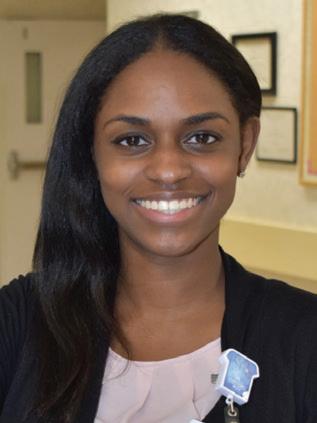


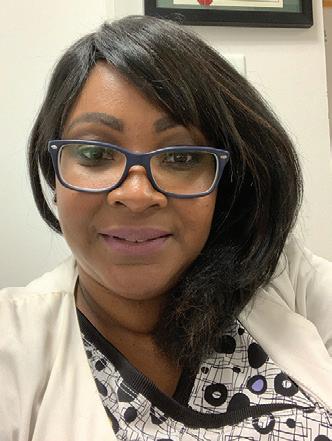
Where do you work? I am a family nurse practitioner for BJC Medical Group.
This warm-up and recovery period is important for your heart health. It also helps to reduce the amount of muscle pulls and strains.
Learning Standards:
HPE1, HPE 2, HPE 5, NH 1, NH 5
Can you think of other ways to be more active? Going outside and staying active not only increases your heart rate and burns calories, but it also helps you build friendships!
queen or jack) should all count as the number 10. Aces are “wild” and you can do as many as you want! To really challenge yourself, have one person roll the dice and the second can select the exercise. See who can complete the exercise challenge first!
Learning Standards:
> What to do if you see someone else bullied.
> What to do if YOU are the bully.
If someone is hurt, sick, or in danger, calling 911 can get help on its way. 911 is designed to bring aid from emergency services personnel (firefighters, police officers and paramedics). As a class, discuss when you should (and should not) call 911.
doctor if you have any questions. The formula to calculate your BMI is 703 X weight (lbs) ÷ height (in inches/squared) or search “BMI Calculator” to find an easy fill-in chart online. If your number is high, what are some ways to lower your BMI?
Look through the newspaper for examples of ad layouts and design. Discuss the words “compassion,” “empathy” and “sympathy.” How do they each play into your response to bullying at your school?
Keep this up until you can switch that to running three and walking one block. Eventually you’ll be able to run the full mile. But of course, if running’s not your thing, you can always walk the 5K instead. Just make sure you walk briskly (quickly) to increase your heart rate while raising money for charity.
Learning Standards: HPE 2, HPE 5, NH 1
Learning Standards: HPE 2, HPE 4, HPE 5, NH 1
Learning Standards: HPE 1, HPE 2, HPE 5, HPE 6, NH 1, NH 3, NH 5
Ingredients:
> Also — remember to look up! Icicles injure numerous people every year. If you see large icicles forming over your front steps, ask your parents to use a broom handle to knock them off to the side before they break loose from your gutters.
1. Most importantly — take breaks! Have a goal of a 3 minute break every 15-20 minutes. Move around, stretch your neck and relax, without looking down!
2. Set your tech device in a holder to keep it at eye level, reducing the need to look down.
Learning Standards: HPE 2, HPE 3, NH 1, NH 7
1 14-oz Package Wonton Wrappers
> What other ice hazards are there?
1 lb Shredded Chicken
Ingredients: 1 cup blueberries 1 cup non-fat Greek Yogurt
Learning Standards: HPE 1, HPE 2, NH 5
Learning Standards: HPE 2, HPE 5, NH 4
Learning Standards: HPE 2, HPE 5, HPE 7, NH 5, NH 7
“Questions or comments? Contact Cathy Sewell csewell@stlamerican.com or 314-289-5422
Learning Standards: HPE 1, HPE 2, NH 1, NH 5
Directions: Preheat oven to 350 degrees. Place one Tbsp of chicken along the wonton wrapper and roll up. Seal the wrapper by dabbing a little water along the edge with your finger. Place in a greased 9x13 baking dish and bake for about 15-20 minutes, until the wontons are crisp.
Directions: Blend all ingredients until Smooth. Makes 2 yummy smoothies!
Directions: Drop each blueberry into the yogurt. Using a spoon, swirl around to coat and place each blueberry on a cookie sheet topped with parchment paper. Freeze for at least an hour.
Directions: Spread peanut butter on four of the crackers and top with sliced strawberries. Drizzle with honey and top with the other crackers to make four cracker-wiches.
Where do you work? I am a patient care manager for Christian Hospital – Northeast.
Where do you work? I am a school nurse at Monroe Elementary School.
Where did you go to school? I graduated from McCluer High School. I then earned a Bachelor of Nursing and a Master of Nursing Practice from the University of Missouri – St. Louis. And finally, I earned a Doctorate of Nursing Practice from Maryville University.
Where do you work? I am a school nurse with St. Louis Public Schools.
Where did you go to school? I graduated from Sumner High School. I then earned Associate Degree in Nursing from Forest Park College and a BS in Business Administration from Columbia College.
Where did you go to school? I graduated from McCluer North High School. I earned an Associate of Applied Science in Nursing from Meramec College in Kirkwood and completing my bachelor’s degree at Webster University in Webster Groves.
Where did you go to school? I graduated from McCluer North High School. I then earned a Bachelor of Science in Nursing from Saint Louis University, and I am currently pursuing a Master of Science in Nursing – Family Nurse Practitioner from Walden University, Minneapolis, Minnesota.
Where do you work? I am the founder and distance counselor for Goal Driven Counseling, LLC. Where did you go to school? I graduated from Whitney Young Magnet High School in Chicago, IL: same as former first lady Mrs. Michelle Obama. I then earned a Bachelor of Science in Social Work, and a Master of Social Work from the University of Missouri – St. Louis. I also completed two more years of supervision and exams to become a Licensed Clinical Social Worker in the state of Missouri.
What does a family nurse practitioner do? Each day I have office visits with patients to help treat new health conditions and/or manage established health conditions. I perform physical examinations on patients, order labs, read x-rays results, and more.
What does a school nurse do? I assess the concerns of students who are ill, injured or experiencing alterations in their normal health. Nurses screen daily staff, students and visitors for safety. Monroe School is a pilot school for Covid-19 test sites in partnership with the city.
What does a school nurse do? I love giving students medications, so they’re able to focus on learning. I clean and bandage wounds. I use medical equipment like a stethoscope, for example, to evaluate whether or not my asthmatics are breathing well. Moreover, I teach and promote healthy habits to my students.
What does a Licensed Clinical Social Worker do? I use technology to help teens and young adults explore their emotions, better understand their feelings, work through relationships, and address common challenges completely online through a computer, tablet, or smart phone. Similar to a Facetime call, I support and guide my clients from the comfort of their home or private location where they are comfortable
What does a patient care manager do? I interview and hire nurses and patient care technicians who aspire to work in the nursing field. I sit and talk with my patients to assess how well my team is taking care of them and to address any concerns. I attend a lot of meetings with staff from different departments to discuss how we can all work better together to ensure our patients here at CHNE receive excellent care.
Why did you choose this career? I chose this career to help improve the health of my community.
Why did you choose this career? I love nursing because there are many opportunities in hospitals, schools, clinics and offices, insurance, legal and research. My passion is working in the schools with students, parents, staff and community partners.
Why did you choose this career? I am a St. Louis native, and was an asthmatic child who experienced frequent hospitalizations. Besides having the influence of nurses in my family, the local nurses who helped take care of me were my “angels” and always managed to nurse me back to health, thus sparking my interest.
Why did you choose this career? I chose nursing because I have always received joy from caring and loving on other people. To be able to show someone that I care about them and make a difference in someone’s life is fulfilling. I have a passion for people.
Why did you choose this career? I chose this career because I enjoy being a support to teens and young adults in a very challenging phase of life that can be overwhelming. I enjoy teaching them how to best take care of themselves so they can live healthy and fulfilling lives.
What is your favorite part of the job you have?
What is your favorite part of the job you have? Many chronic health conditions (diabetes, high cholesterol, high blood pressure) are preventable, and early detection is key. Thus my favorite part of the job is partnering with patients to establish and manage a plan to help them each live a long and healthy life.
What is your favorite part of the job you have? I enjoy when a child tells you, “I want to be a nurse.” And best of all, I love the smiles, hugs and “thank-yous”.
Learning Standards: HPE6, NH3
What is your favorite part of the job you have? My favorite part of my job is seeing the impact that I have had on patients, nurses, and patient care techs, and how this has trickled down to my patients. Knowing that my patients left better than they came, and received compassionate care, gives me joy.
Learning Standards: HPE6, NH3
What is your favorite part of the job you have? I love that my job makes talking about mental health not as scary and even makes it kind of cool. I love that I get to build valuable relationships with so many people that trust me to be there for them. I love that no matter where my clients are, we can simply connect with a video call and I can not only support them through hard times, but lots of good times as well.
My childhood health challenges have given me sensitivity to children suffering with illness. After being given a new lease on life, I consider it an honor to be in a position to promote health to the children of my community, in whatever capacity I serve – in turn, being their “angel.”
Learning Standards: HPE6, NH3
Learning Standards: HPE 6, NH 3
Learning Standards: HPE6, NH3
“Questions or comments? Contact Cathy Sewell csewell@stlamerican.com or 314-289-5422
“Questions or comments? Contact Cathy Sewell csewell@stlamerican.com or 314-289-5422
“Questions or comments? Contact Cathy Sewell csewell@stlamerican.com or 314-289-5422
“Questions or comments? Contact Cathy Sewell csewell@stlamerican.com or 314-289-5422










Neurobiology is the study of the brain and nervous system of humans and animals. This study allows scientists to understand how the brain functions when it is healthy and how to cope when there are different disorders or injuries that affect brain function. MRI machines allow doctors to see the brain in action and to learn more about it.

Scientists believe that the brain is not fully developed until age 25. Different areas of the brain develop at their own pace. For young teens, the frontal lobe of the brain that impacts decision making and impulse control

Background Information:
In this experiment, you will see how smell affects your taste buds.
Materials Needed:
• Small Cups • Cotton Swabs or Q-tips • Different Foods With Similar Textures (ex: ketchup, mustard, barbecue sauce, sweet and sour sauce, and maple syrup)
• Pen and Paper for Charting
• Partner for the Experiment • Blindfold
Procedure:
is slowly developing. That’s why many adults exclaim, “What were you thinking?” when they are frustrated with teens. Because the brain develops until the age of 25, it is especially important for young people to avoid drugs and alcohol because it is easier for this age group to get addicted and substance abuse will have a very severe and devastating impact on permanent brain development.
Learning Standards: I can read nonfiction text for main idea and supporting detail. I can make text-to-self and textto-world connections.

Erich Jarvis

Erich Jarvis was born on May 6, 1965, in Harlem. Both of his parents were musicians.
At an early age, Jarvis was interested in music, dance, and the arts. He attended the High School of Performing Arts. After graduation in 1983, he attended Hunter College. While working on his degree, Jarvis worked as a Minority Access to Research Careers (MARC) Fellow and studied bacteria while he earned his bachelor’s degree in mathematics and biology. From 1988-1995, he attended the Rockefeller University where he earned his PhD in molecular neurobiology and animal behavior. He specialized his research in the study of songbird vocalizations.
q Draw a chart for your results. Write the name of each food you are testing in separate rows along the left side. Draw two columns for each taster. Label each column with the taster’s name and “unplugged” and “plugged.”
w Make some predictions about which foods will be easier and harder to identify by smell. Will it be easier or harder to taste the foods with your nose plugged or unplugged?

Did you know that you can find math in music? Time signatures tell how many beats per measure. Each note has a different numerical value. Many songs involve patterns in the music or lyrics. In honor of Jarvis’ songbird research, today’s math review is musical.
z A whole note is worth 4 beats, a half note is worth 2 beats, a quarter note is worth one beat. If a measure has 4 beats, how many different combinations can you create with these notes? ________
x Janice practiced her clarinet for 20 minutes on Monday, 35 minutes Tuesday, 10 minutes Wednesday, and 60 minutes Thursday. What is the average number of minutes she practiced each night? ________

e Blindfold the taster as the tester puts a little bit of one food on the taster’s tongue with a cotton swab.
r The taster tries to identify which food they are tasting as well as whether it is salty, bitter, sweet or sour.
t The tester records the taster’s answers on the chart for each food they taste.
y When the taster has tried all the foods blindfolded, they will taste them each again but with their nose plugged as well. (Make sure you have them taste the foods in a different order.)
u Once the taster has tried each food with his/her nose plugged, switch who tastes and who tests and go through it all again. When you’ve both had a chance to taste, compare your results.
Learning Standards: I can follow directions to complete an experiment. I can analyze the conclusions of the experiment and make deductions.
c In the fifth grade classroom, each student plays an instrument. 6 students play the saxophone, 8 students play the trumpet, 3 students play the drums, and 5 students play guitar. How many students are there total? ________ Write a fraction that represents the number of guitar players. ________
v A popular R&B song is 3 minutes and 50 seconds long. If the chorus is 20 seconds and is played 3 times in the song, how many total minutes of the song are devoted to the chorus? ________ Write a fraction that represents the portion of the song that is the chorus? ________
Learning Standards: I can use addition, subtraction, multiplication, and division to solve a problem.

Once Jarvis earned his PhD, he stayed at Rockefeller University as a professor, and he lead the Science Outreach Program of New York, going to inner-city schools to teach the students lab skills. His goal was to inspire students to pursue education, develop critical thinking and problem solving skills, and to seek a STEM-related career. In 1998, Jarvis left Rockefeller and became a professor for the Department of Neurobiology at Duke University. He also worked for the Department of Cognitive Neuroscience and the Center for Bioinformatics and Computational Biology. In 2005, Jarvis led a team of 28 neuroscientists who proposed a new classification system for the bird brain as they researched the similarities between the brain of a bird and the brain of a mammal. Three years later, he received the honor of becoming an Investigator for the Howard Hughes Medical Institute. He has published more than 50 journal articles and has been a contributor to numerous books.
Jarvis’ success in his field as a pioneer in the study of songbird neurobiology has won him many awards, including the National Science Foundation Alan T. Waterman Award, the Dominion Award, Strong Men and Women of Excellence, African American Leaders and the National Institute for the Humanities’ Director’s Pioneer Award. Also, Jarvis has served as the director of the Neuroscience Scholars Program for The Society of Neuroscience, he is a member of Duke University’s Council on Black Affairs and a founding member of the Black Collective at Duke University. Jarvis followed his passion for music and learning and it has led him to a successful career. Learning Standards: I can read a biography about a person who has made contributions in the fields of science, technology, engineering, and mathematics.

Enjoy these activities that help you get to know your St. Louis American newspaper.
Activity One —
Plural Words: Find 10 plural words in the newspaper and cut them out. Glue them to a piece of paper and write the root word next to each (or circle the word in the newspaper and then write it on a piece of paper).

Activity Two —
Sports Team Travels: Keep track of a sports team’s travels. Find distances between cities on a map. Measure the distance between each city they visit. How many total miles did they travel?
Learning Standards: I can use the newspaper to locate information. I can identify root words. I can read a map and use addition, subtraction, multiplication, and division to solve a problem.
About to graduate with a degree at age 52
Special to The American
When Annsara Watson graduates from St. Louis Community College this month with an associate degree in general transfer studies, she will be one step closer to keeping a promise.
“It feels amazing to know that I am at the first completion step in my goals,” said the 52-year-old nontraditional student. “It only pushes me to work harder to fulfill the rest of the promise.”
Although she has tried to earn her associate degree since the late 1980s, Watson always came up short until recently. In fall 2019, Watson made a promise to her mother, Karen Jones, 74, a colon-cancer survivor, that before she draws her last breath, she will have her daughter’s associate and bachelor’s degrees.
Working to keep this promise has driven Watson to achieve academically and shine as a leader at St. Louis Community College at Florissant Valley. A retired licensed practical nurse, Watson has been on the dean’s list since she enrolled in spring 2020. She boasts a 3.6 GPA, is a member of Phi Theta Kappa Honor Society and a representative for the Student Government Association. She also owns a multimedia business, Dominating Productionz, LLC.
What is even more impressive is the fact that Watson has achieved such success despite being diagnosed with cervical cancer in February 2008. “Nursing is my passion.
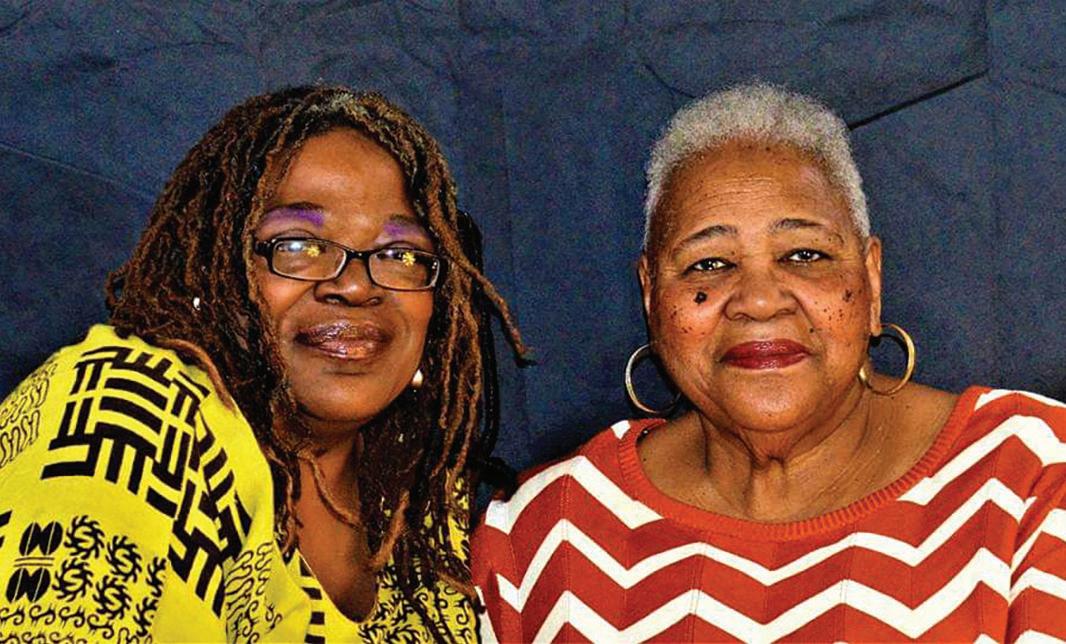
shares a moment with her mother,
graduate from St. Louis
an associate degree in general
I had originally gone to college to become a doctor, but I’m so happy that I chose this field instead,” Watson said. “I believe that everyone has a calling and mine was nursing.”
When Watson became ill with her first blood clot to the lungs, she was unable to do the job that she loved so much.
“My mind was still willing, but my body could no longer handle the stressors of the field,” Watson said. Earning an associate degree is a steppingstone to Watson obtaining her bachelor’s degree in business administration and making good on her promise. Jones is glad her daughter is working to better herself. “She did promise me that, but I am not holding her to that. I’m just going along with the flow. What she does, she does for herself, and it won’t be for me ... it will be for her,” Jones said.
“She adheres to that because it makes her push herself more, but I’m not holding her to that with a yardstick. I’m not pushing her, because I may take
my last breath in the next five minutes.”
Jones said that if she takes her last breath before Watson reaches her goal, she doesn’t want her daughter to think she has failed.
“If I do, I want her to continue to do the things she wants to do before she leaves this Earth,” Jones said. “I’m proud of her. She has been through a lot of things that have set her back. She has been very ill, but she has been determined to go back to school.”
When Watson graduated from high school, Jones did not think her daughter really applied herself.
“She met this boy and had a son. She got her LPN, but now she wants to get her degree,” Jones said. “She doesn’t have to impress me and get a degree for me to love her more, but I am proud she is doing so well. I’m just amazed at the things she has accomplished and how good her grades are. I am in awe at how well she is doing.”
Special to The American
The St Louis Association of Organizations’ (SLACO) campaign to attract 100 new homeowners to North St. Louis keeps building with launch of the Gateway Neighborhood Fund.
The GNF will focus on returning a functional mortgage market to sections of North St. Louis that currently lack one. It will initially target eight neighborhoods - Academy, Baden, Hamilton Heights, North Pointe, Walnut Park West, Walnut Park East, West End and Visitation Park.
“SLACO is always looking to support innovative programs and is extremely happy to support the Gateway Neighborhood Fund Collaboration as they work to increase investment into neighborhoods that currently face the negative impacts of the ‘appraisal gap.’ Our goal is to attract 100 new homeowners to North St. Louis” said SLACO Executive Director Kevin B. McKinney.
The GNF is a partnership between lenders and nonprofits designed to address a recommendation of the Segregation in St. Louis: Dismantling the Divide, released in 2018.
The lack of a functional mortgage market in many of the region’s minority neighborhoods is driving Black homeownership rates lower and increasing the “wealth gap” between white and African American households.
GNF will also help current homeowners retain and regain home values in these neighborhoods. Based on a successful program in Detroit, the GNF program has now come to St. Louis.
With SLACO serving as
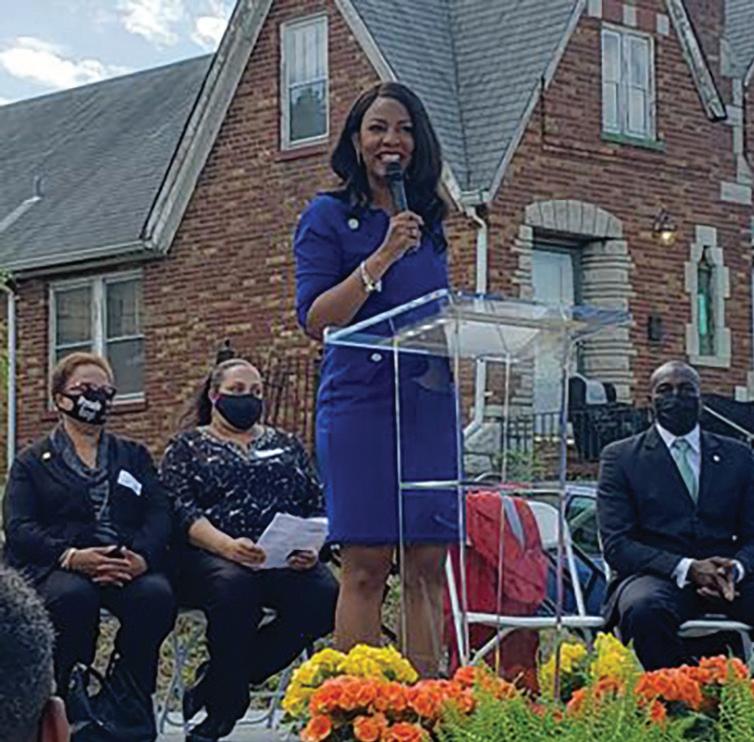
Community/Media partner, the GNF is now ready to offer this innovative financing model in the initial target areas.
“The Metropolitan St. Louis Community Reinvestment Act Association (MSLCRA) is proud to be one of the original members of the dedicated team that created the Gateway Neighborhood Fund (GNF),” said Nikki Woelfel, MSLCRA chair.
The MSLCRA is a professional organization of member banks that work together on ini-
tiatives related to the CR) and Community Development.
“We wanted to be at the table with other members of the community to address housing challenges and make mortgage credit more available in underserved sectors of our community. GNF looks to be a gamechanger for neighborhoods and homeowners who want to see real change and growth in their backyards. Today is an exciting day for GNF, the City of St. Louis and MSLCRA,” Woelfel said.
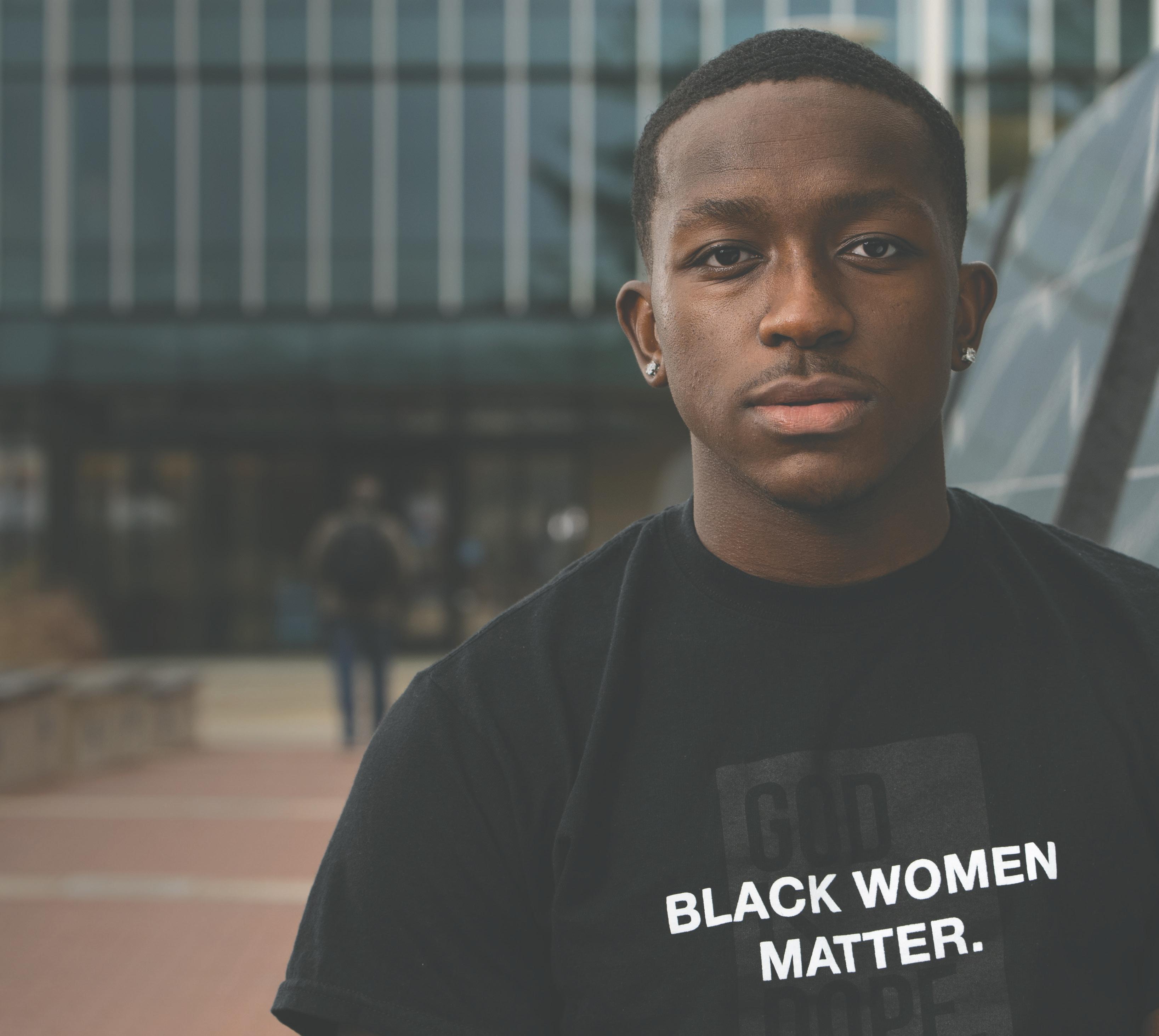
Bryce Pettiford understands the importance of being a change agent in his community. That’s why he champions several racial equity initiatives and programs at Maryville University. Most recently, Pettiford helped lead the “Be the Change” rally on Maryville’s campus. The rally brought awareness to the Black Lives Matter movement as well as systemic oppression plaguing black communities.
Pettiford is also involved in clubs like the Black Male Initiative, the Association of Black Collegians and Inclusion at Maryville. As part of Maryville’s Multicultural Scholars Program, he serves as a peer tutor, educator and mentor.
Pettiford uses his bold voice and ideas to ensure inclusion on campus, and Maryville stands with him. Learn more at maryville.edu/bold
By Dana Rieck Of The St. Louis American
Morale is low.
That’s one of the biggest takeaways from a St. Louis County Police Association (SLCPA) survey distributed to the organization’s members to determine what issues were on police employee’s minds.
The findings were presented to Chief May Barton and the Board of Police Commissioners last week, and SLCPA Executive Director Joe Patterson said the union urged both Barton and the commissioners to respond in due time.
Patterson noted that while there were a group of members calling for a vote of no confidence in Barton, they did not constitute a majority — thus a vote was not taken.
“There’s no general time frame,” he said, “I think what we would do is give the leadership of the police department and the Board of Police Commissioners an opportunity to address these issues. And then, if an appropriate amount of time passes and we don’t feel the issues were addressed, we would explore [a vote] as a next possible step.”
Both the Ethical Society of Police board and the St. Louis County Council voted in April and declared no confidence in Barton.
ship can’t formally discipline an employee for an action, they’ll give them what we call a geography lesson — meaning that they’ll be transferred from the precinct they work in currently to another area that might be far from their home,” Patterson said, noting SLCPA leaders believe it happens to officers of all races and identities Patterson said the most recent high-profile incident of this was the transfer of Officer Shanette Hall, although Patterson said he did not know enough to comment on that specific situation.
Hall, who is Black, was reassigned from her human resources role recruiting officers — including minority officers — to a patrol position in a different precinct with a predominately white staff. This happened one day after a Vice video was released featuring her and other female officers discussing police culture.
n Only 22 percent of the SLCPA survey respondents agreed that their morale is high.
Just more than 500 SLCPA members completed the survey, which presented eight statements and solicited a Likert scale response (five options ranging from strongly disagree to strongly agree). The St. Louis County Police Department employs approximately 1,015 officers and 328 staff members — all are eligible to join the SLCPA, which currently has 915 members.
Only 22 percent of respondents agreed that their morale is high, and 90 percent of respondents believe that transfers are used within the department as a type of informal discipline.
In addition, approximately 66 percent of respondents do not believe that discipline is administered in a fair and equal manner.
“There is an overall feeling that if the department leader-
In a recent interview with The American prior to the release of these survey results, Barton said officers are only transferred to best fit the needs of the department and never for retaliatory reasons. She noted that she’s been transferred 12 times in her career. But that doesn’t hold up for Patterson.
“I would say that Chief Barton has served over 40 years and that the vast majority of her transfers she received were for promotions or transfers she requested — as opposed to involuntary transfers,” he said.
Other survey findings indicated that officers do not believe the department is headed in the right direction — particularly when it comes to the communication from the command staff to the officers on the street.
On the positive side, officers said they felt they had the training, equipment and support to properly do their job and that they believe the department is concerned with their mental health and wellness.
“I would say that we expected these results to be what they were,” Patterson said. “It’s pretty well known that these are issues inside the police department. We were glad to see that

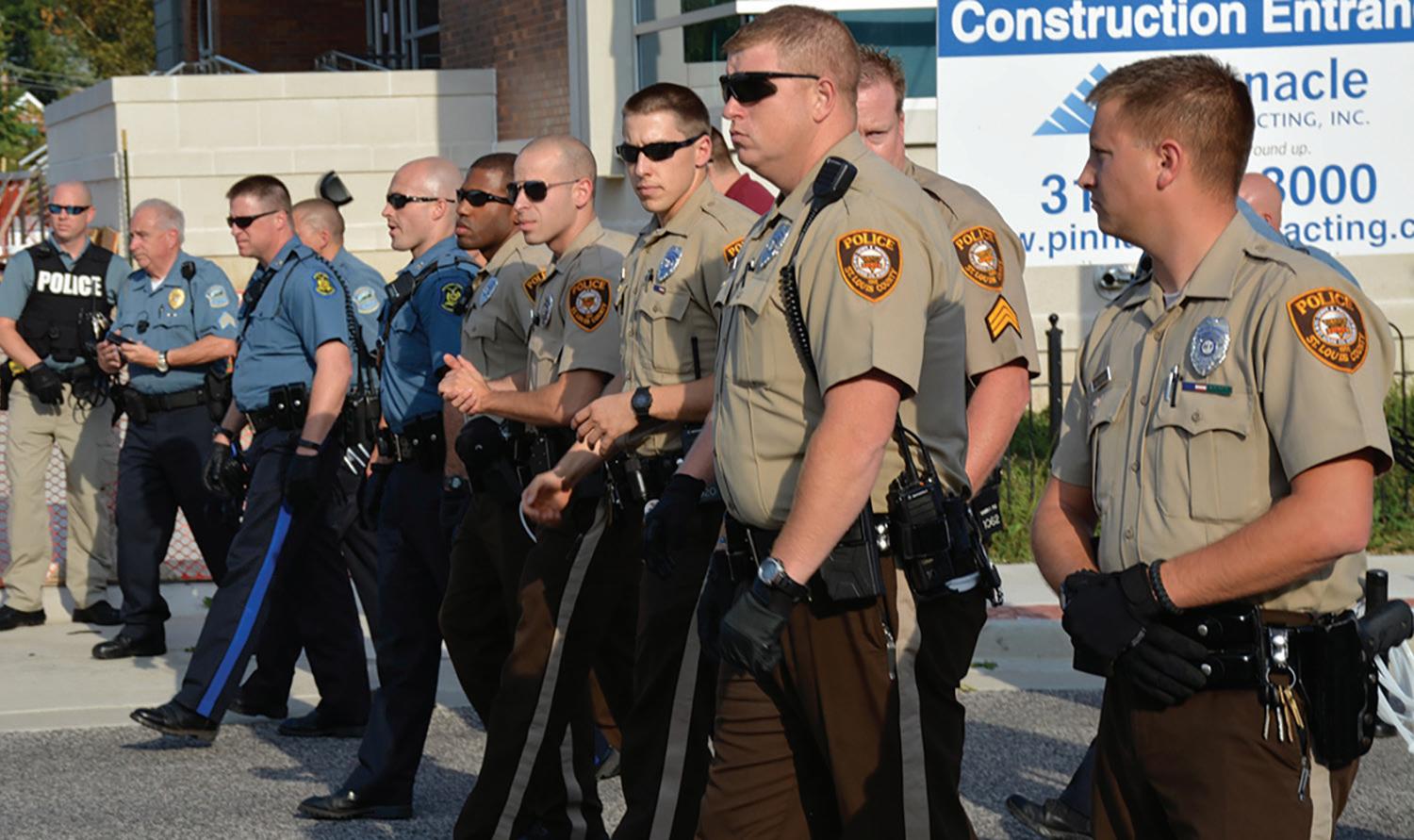
A survey of more than 500 members of the St. Louis County Police Association found that 90 percent of respondents believe that transfers are used within the department as a type of informal discipline and approximately 66 percent do not believe that discipline is administered in a fair and equal manner.
we learned a couple of positive things especially when it comes to mental health and wellness.”
Patterson said the department has recently formed a wellness unit that’s commanded by a
lieutenant. Barton did not comment on the survey results but released a written statement through her spokesperson that she would embrace the information and evaluate how to improve the
things that may be within her span of control.
“I mean overall I think that the main thing is we just hope that there is a response and there is some willingness from the department to work together
to solve these issues,” Patterson said. “And we understand that many of these issues may be perceptual — but perception is reality, and we should work together to try to make some positive changes.”
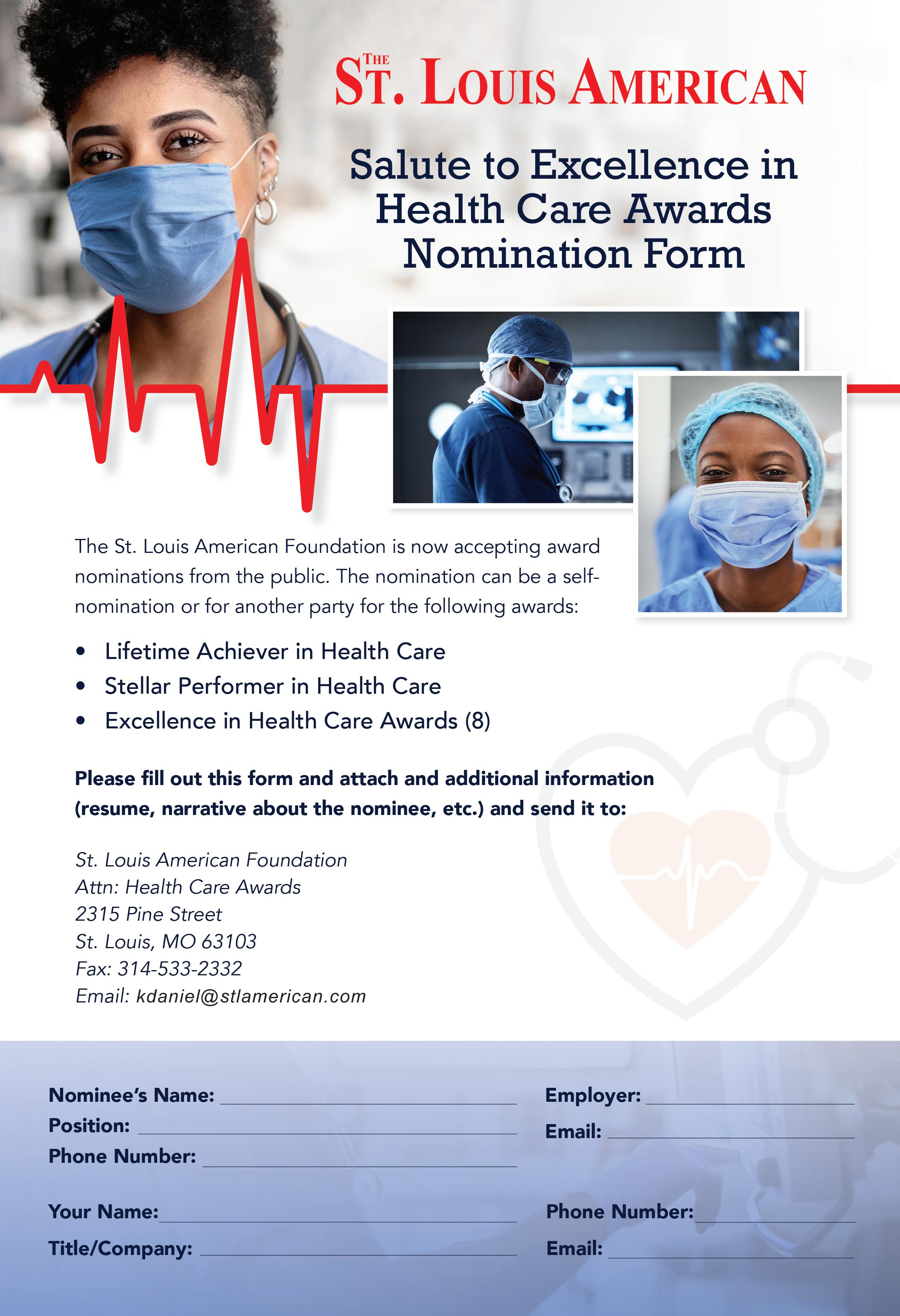






By Jamala Rogers
Tennessee state Rep. Justin Lafferty recently extolled the goodness of the so-called “Three-Fifths Compromise” on the House floor, saying it was an honest effort to end slavery.
Like other pages from the Republican racist playbook, you hear pretty much the same talking points from GOP talking heads around the country. Sadly, because many Americans do not know their nation’s history, it has taken too long to begin correcting this barrage of intentional disinformation. The timing for re-interpreting slave history has made a suspect merger with right-wing attacks on voting rights.
Meanwhile last week, St. Louis and nearly 100 other cities hosted National John Lewis Voting Rights Advancement Action events.
This and similar activities are part of a counter-offensive to protect the right to vote. Since the record-breaking voter turnout last November, GOP dominated legislatures in many states have unleashed an assault on voting rights with a reported 370 proposed bills designed to disenfranchise and suppress the vote of communities of color, the elderly and the young – groups that tend to vote Democratic. The remnants of the Voting Rights Act of 1965 are in the crosshairs of the GOP.
These treacherous acts have inspired Defenders of Democracy to make good trouble and to actively support U.S. Senate Bill 1, the For the People Act, and U.S. House
Bill 4, the John Lewis Voting Rights Advancement Act.
If passed, a pathway to securing voting rights and protections against current laws intended to suppress the vote in targeted communities, particularly Black and Brown communities, would be cleared.
As for Lafferty’s laughable – and evil - comment, I prefer to use the numeric version of three-fifths to emphasize the fact that enslaved people were considered a fraction of a human under this law.
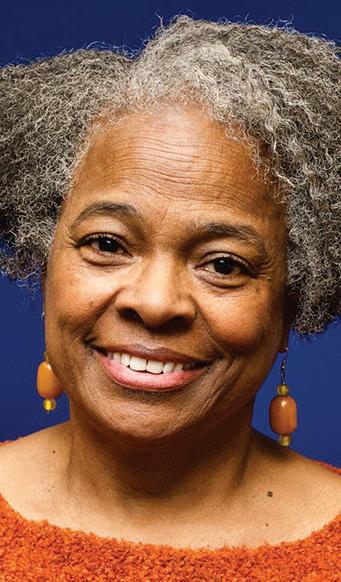
The 3/5 Compromise was reached by delegates from pro-slavery states during the 1787 Constitutional Convention in Philadelphia as they grappled with the issues of taxation and representation. It was a slick move to act like they were acknowledging some humanity of Black folks, an overture to Northern abolitionists. The real deal was that with the threefifth count, southern states would get greater representation, but be spared full taxation because the enslaved human beings would not be counted as full citizens.
The Compromise gave proslavery states the edge needed to consolidate power. The decision had a major impact on U.S. politics for decades, especially on how the nation would look forever at Black bodies as merely political fodder.
The white south has been flexing its muscles ever
sense—even after the 14th Amendment led to repeal of the 3/5 Compromise.
Here we are in 2021, embroiled in a campaign that seeks to take the sacred vote from Black people by revising history. History is repeating itself.
The truth is that white supremacists believed then, as they believe now, that Black folks will never be equal to whites. All laws, policies and practices must affirm that superiority.
We heard that in the Dred Scott decision in 1856 when Supreme Court Chief Justice Roger Taney, who was the first Catholic Supreme Court Justice, proclaimed that Blacks—enslaved and free— were not and would never be citizens. Further, Black people had no rights that whites were bound to respect.
The Compromise concept was at the heart of voter suppression. Black folks cannot be given the right to vote because it would be a potential gateway to our full participation as citizens. If we are sub-humans, threefifths of a person, Black people can never be equal to whites. Voting is one validation of our citizenship.
We who believe in democracy must be vigilant about attempts to drag us back in time. A time when African Americans were treated as private property with no rights and no voice. In the spirit of the Sankofa bird, which implored Africans to reach back into history for traditions and customs that have been left behind, we must go forward with the clear understanding of the past.
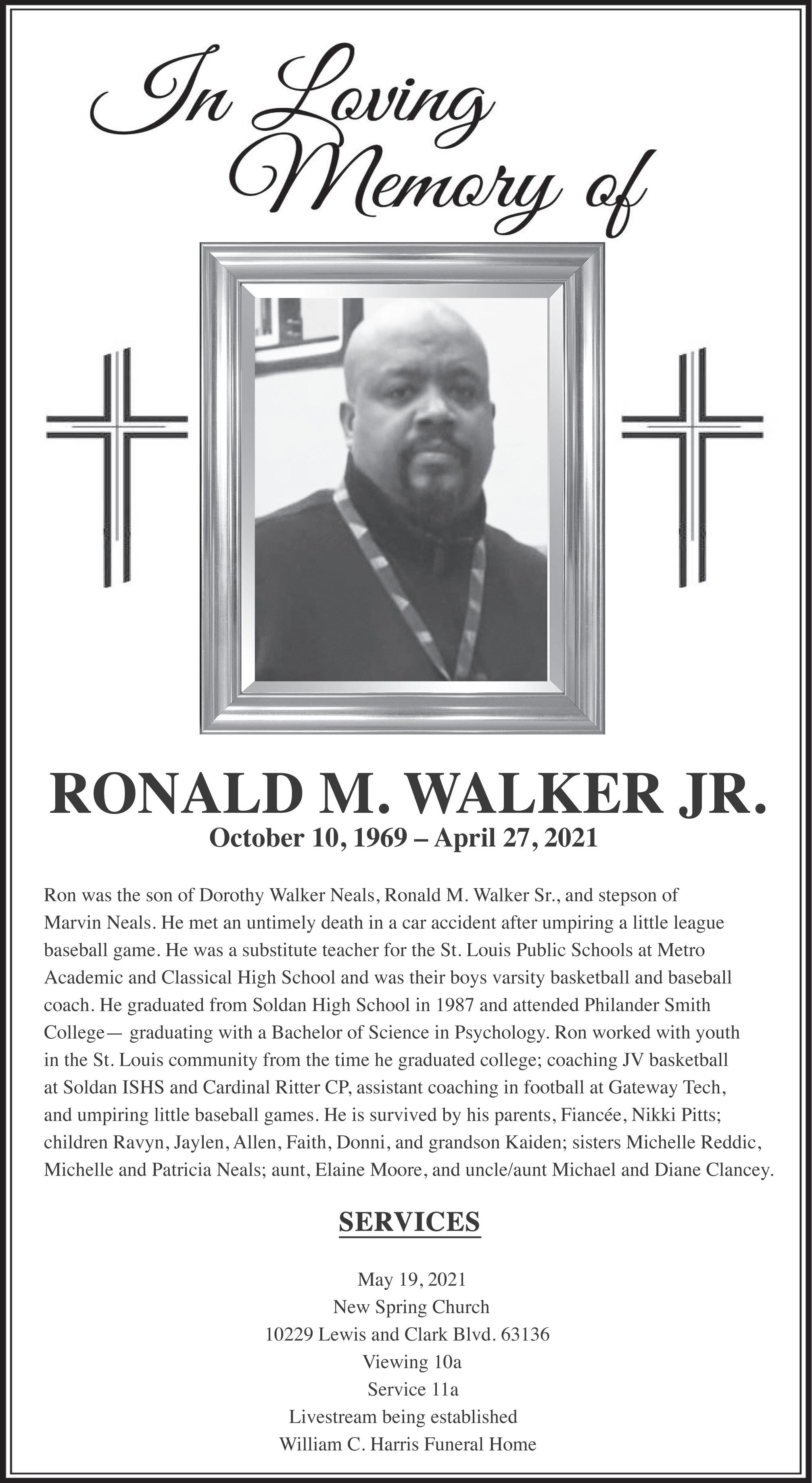
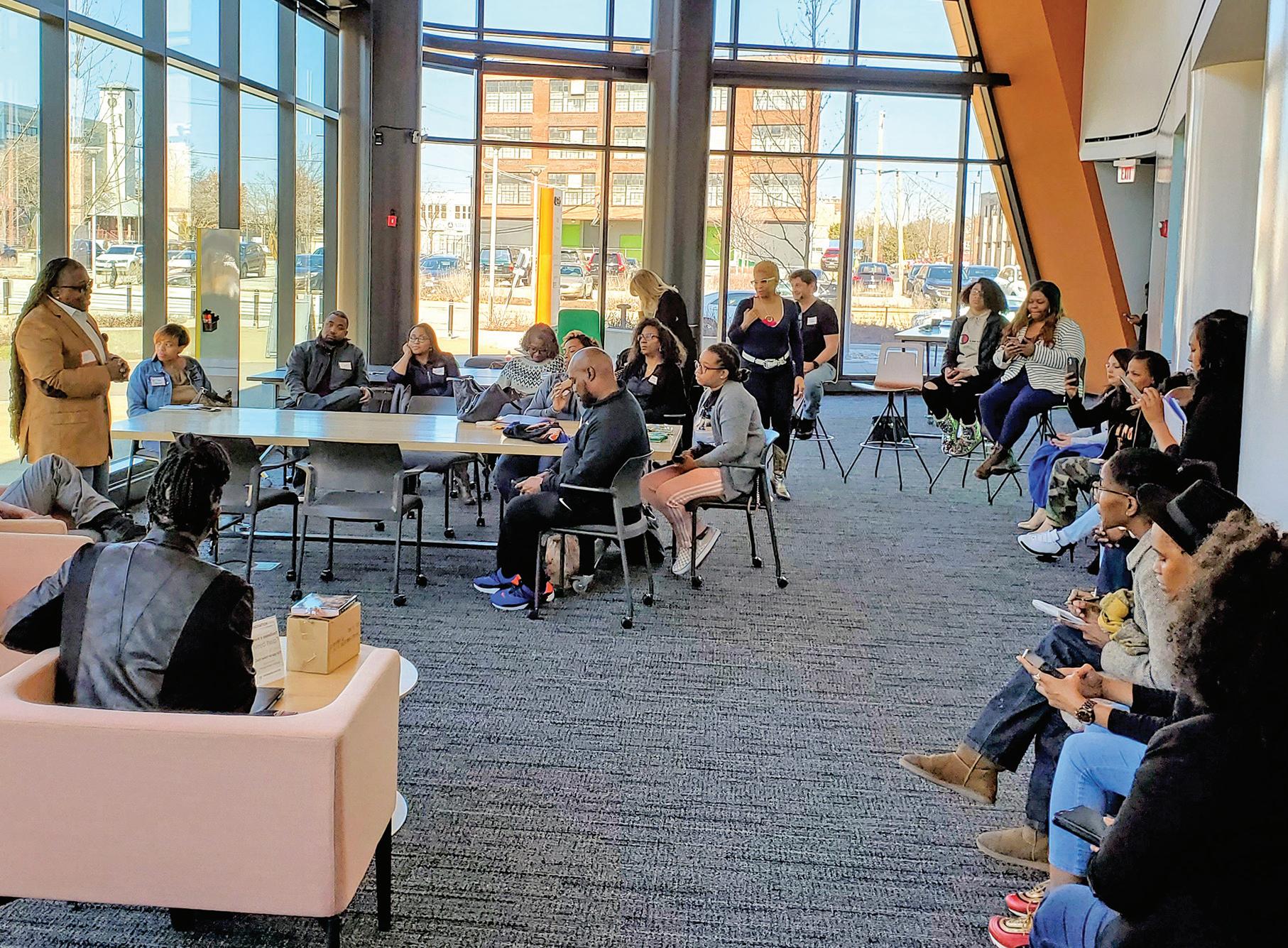
The Global Center for Cybersecurity @ Cortex (GCC) officially launched its inaugural virtual conference — Net Measure. At the event, leading security experts addressed how the cybersecurity industry can remove the boundaries and barriers that exist between individuals, organizations and countries — with the goal of solving far-reaching challenges in cybersecurity together.
Special to The American
On the heels of a historic global pandemic that has resulted in an increase in cybercrime and revealed deep inequities in talent within the cybersecurity industry, The Global Center for Cybersecurity @ Cortex (GCC) officially launched by hosting its inaugural virtual conference — Net Measure. At the event, leading security experts addressed how the cybersecurity industry can remove the boundaries and barriers that exist between individuals, organizations and countries with the goal of solving far-reaching challenges in cybersecurity together.
n The GCC also announced a global initiative to address one of the biggest issues facing the cybersecurity workforce and combating cybercrime: a critical lack of professional development opportunities and barriers surrounding diversity.
The GCC also announced a global initiative to address one of the biggest issues facing the cybersecurity workforce and combating cybercrime: a critical lack of professional development opportunities and barriers
surrounding diversity. With this announcement, the GCC will be taking steps to build, train and promote talent in underrepresented communities. GCC operations are headquartered at the Cortex Innovation Community, a vibrant, 200-acre hub of business, innovation and technology integrated into St. Louis’ historic Central West End.
“Cybersecurity is people security. It is one of the fastest growing industries of our time and one of the largest potential threats to our global society,” said Josh Jaffe, president of The Global Center for Cybersecurity @ Cortex (GCC) and vice president Cyber Security & Business Unit Security Officer, Dell Technologies. “How we act upon the challenges and opportunities we see today will shape the future of what the industry looks like and how
By Sylvester Brown, Jr. of The St. Louis American
“I was watching my leg die.”
COVID-19 and cancelled concerts can’t stop him
In November of 2019, Orlando Watson, 44, concert promoter and co-owner of Prime 55 Restaurant in the U. City Loop had to make a tough decision.
n “The lower part of my leg went numb. I couldn’t feel it anymore. It started to turn black, tumors were protruding out of my skin.”
– Orlando Watson
A sarcoma cancer had formed in his left leg, below the knee. It wasn’t the first time. In 2006, lymphatic cancer had manifested in the same knee. He initially refused traditional chemo and radiation therapy. He opted to travel to Mexico to work with Dr. Hulda Regehr Clark, a naturopath practitioner of alternative medicine and author of “The Cure for All Diseases.” With Clark and additional help from the Alvin J. Siteman Cancer Center, Watson was pronounced “cancer free.”
But the cancer came back in the same spot.
“The lower part of my leg went numb. I couldn’t feel it anymore. It started to turn black, tumors were protruding out of my skin,” Watson recalled.
“The pain got so bad, I called the surgeon and said, ‘Alright, man, go ahead, take it.’”
See WATSON, B2
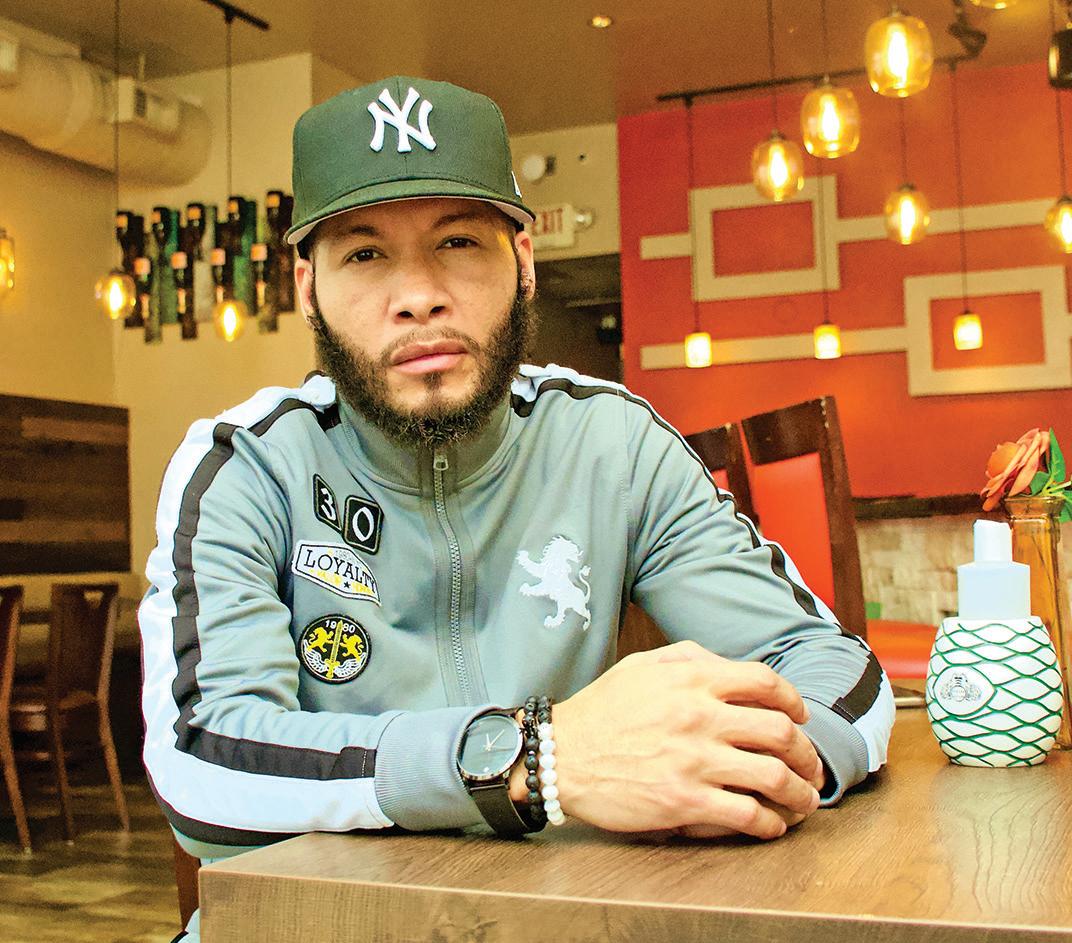

William Tate, IV has been named as the next president of Louisiana State University (LSU). Tate is expected to begin his term as president in July. Tate has served as executive vice president for Academic Affairs and Provost at the University of South Carolina since July 2020. Prior to that, he served as dean of the Graduate School & Vice Provost for Graduate Education at Washington University in St. Louis from 2002 to 2020. Tate also spent time at Texas Christian University and University of Wisconsin-Madison.
Yattassaye joins Cambia Health Solutions

Amadou Yattassaye has joined Cambia Health Solutions (Portland, Oregon) as executive vice president of market growth, leading branding, sales and marketing efforts. Yattassaye comes to Cambia from Anthem, where he was most recently president of the Missouri market and leader of the company’s multi-state third-party administrator, HealthLink. Before Anthem, he spent 10 years with Deloitte and Ernst & Young. Yattassaye will accelerate the delivery of Cambia’s innovations and personalized experiences to health plan customers in Idaho, Oregon, Utah and Washington. William Tate, IV named president of LSU
FleishmanHillard hires Adrianne C. Smith

Adrianne C. Smith
FleishmanHillard recently announced the appointment of Adrianne C. Smith to chief diversity and inclusion officer, from WPP where she previously served as its first global director of inclusion and diversity. In her new role, she will advance FleishmanHillard’s global Diversity, Equity and Inclusion (DE&I) strategy and continue its ambition to become the most inclusive agency in the world. Smith was the first executive director of the Howard University Center for Excellence in Advertising.
Brown to continue as Deaconess COVID fellow
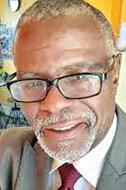
Veteran journalist Sylvester Brown Jr.’s St. Louis American COVID fellowship has been extended by the Deaconess Foundation for an additional year. The funds are awarded from Deaconess Foundation’s Responsive Grant program to continue support for The St. Louis American’s COVID-19 Fellow narrative advocacy coverage. The COVID-19 Equitable Relief and Recovery Fund (ERRF) grants were designed to support Black-led organizational capacity to respond to community needs during the pandemic. Brown is a former columnist for the St. Louis PostDispatch, and among the most respected writers and journalists in the St. Louis region.
Promotion, board appointment, new hire, award…please submit your People on the Move item (including photo) to kjones@stlamerican.com


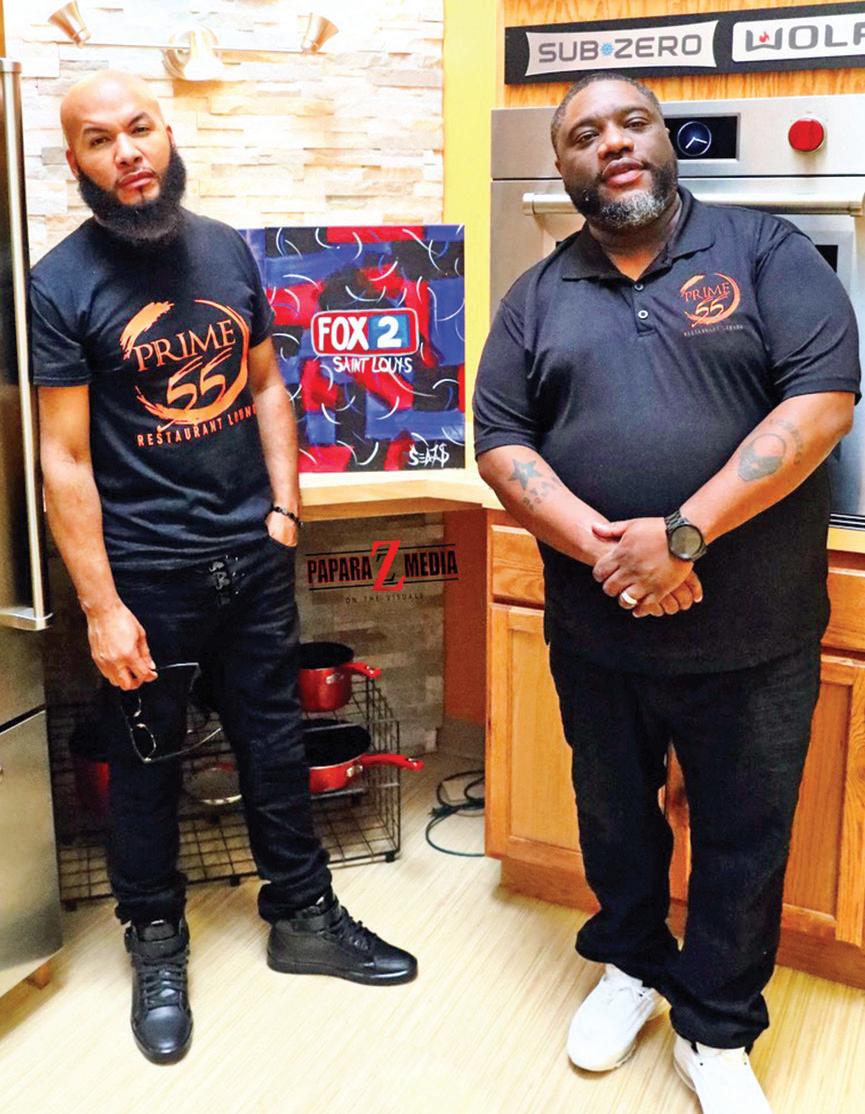
Continued from B1
Doctors said the returning melanoma was “post-radiation cancer,” which Watson said was caused by the radiation treatment he received 14 years earlier. He was told there was no cure.
Watson’s leg was amputated above the knee, almost to the hip. As he was recovering from that, another calamity rocked his business world: COVID-19.
“The pandemic hurt the concert side of our business the most. Venues were basically shut down. In fact, the entire industry shut down,” Watson recalled.
“I thought for sure we’d have to close the restaurant, too, but God had other plans.”
Unlike many other businesses, Prime 55, an upscale restaurant that opened seven months after Watson’s second cancer diagnosis, survived. Business has been steady since the fall of 2020, but now that the city and county have jointly announced new, relaxed guidelines, Prime 55’s economic forecast seems even brighter.
In 2011, Watson threw a party in Forest Park called “I’m a Survivor” to celebrate five years being cancer-free. It was supposed to be a one-time event, but his mother succumbed to lung cancer in 2012.
That tragic event, plus the attendance and testimonials from cancer survivors, urged him to form the nonprofit “I’m A Survivor Cancer Foundation” which hosts the parties annually.
Watson said the nonprofit’s name has special relevance.
“I gave it that name because it’s my motto: I am a survivor,” he said.
Indeed. Watson’s incredi-
ble life story underscores the power of creativity, ingenuity and stubborn resiliency. It is the formula that fortified him to battle cancer twice and ride out the rocky waves of COVID.
This formula, Watson said, was seeded in him at birth.
His maternal grandfather, Herman Dennis, fled the south at the age of 13 after witnessing a lynching. Soon after, he relocated to St. Louis and founded his own construction company, Dennis Construction, in the 1930s. His father owned a cleaning company, and his uncle was also an entrepreneur.
“I liked how entrepreneurism looked on them,” Watson reminisced. “So, at an early age, I knew I wanted to work for myself.”
Watson, a University City native, did just that. In the 1980s, he became friends with a University High School mate, who later became known as “DJ Charlie Chan Soprano” (best known as turn-tableist and DJ for Run-DMC). Watson started making marketable music tracks and beats. After graduating from high school, he moved to Atlanta and continued making music. By the 1990s, his production company, “Ol School,” was signed to R&B singer Keith Sweat’s record label.
A bad contract with Warner Brothers Records, Watson said, forced him to learn more about ownership and being paid fairly for his work. He soon moved from just making music to producing albums. His company “PrettyBoy Productions” (which later became Prettyboy Records) was part of the production team that created the Bone, Thugs-N-Harmony album, “Strength & Loyalty.” The album was certified “gold” by the Recording Industry Association of America (RIAA).

Watson and the collaborators on the album, which included Akon, Jermaine Dupree, Mally Mall and Swizz Beatz, became fast friends. Those relationships proved valuable when Watson formed Rockhouse Entertainment in 2005 with his partner Bradd Young.
The independent recording, concert, management and promotion company has produced hundreds of concerts locally and nationwide featuring artists including Kelly Roland, Chris Rock, Mike Epps, Jodeci, Megan The Stallion, Kodak Black, Toni Braxton and the late DMX.
Joining with his old University City High School classmate, Tony “T-Luv” Davis (rapper, Nelly’s former manager) the two decided to get into the restaurant business. They wanted to fill “a void,” Davis told the St. Louis American in 2019:
“I’ve been to places in other cities where you go to dinner, you socialize for a few hours and then you go home,” Davis said. “Me and Orlando felt like St. Louis didn’t have that type of go-to for our community. When you say ‘prime,’ people know that means topnotch.
The two-level restaurant may have been a superlative experience for customers, but the partners had a rough go of it in the first few months, Watson said.
“We knew the bar side of the business from being in the entertainment game. But we didn’t have any experience as far as food was concerned. We just jumped out there,” he explained.
Just as the partners had gotten into a groove, turning a profit with the restaurant, cancer and COVID-19 reared their respective heads.
But Watson had battled cancer during the production of the Bone, Thugs-N-harmony album. He weathered through it again in 2020.
Next week, Watson will start working with his $70,000 prosthetic “Smart Leg.” In addition, doctors at the Siteman Center have put him on a medicine that seems to be shrinking tumors that had spread to his lungs. He’s hopeful that the ban on concerts will soon be lifted. When it is, his concerts will resume, but cautiously, Watson stressed.
Watson said that neither COVID nor cancer could quelch his entrepreneurial spirit.
“I come from some tough people. I was born to be a survivor,” he said.
Sylvester Brown Jr. is The St. Louis American’s inaugural Deaconess Fellow.
With Earl Austin Jr.
The lanes to the state championships opened for Missouri small school prep track and field athletes at district meets last weekend.
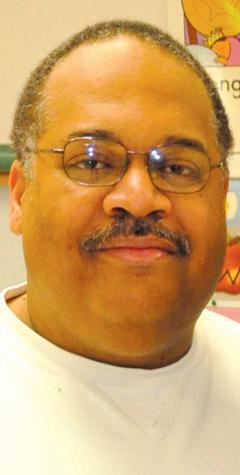
Most St. Louis area athletes were at Lutheran North to compete in the Class 2, District 3 meet. The top four finishers in each event qualified for Saturday’s (May 15) Sectional in Monroe City. It was a productive day for the girls of STEAM Academy at McCluer SouthBerkeley. It had nine district champions while qualifying for sectionals in six individual events and three relays.
Junior Leah Thames was a district champion in the 100and 200-meter dashes, while senior Cheyenne Melvin won the 400-meter dash and 800meter run, respectively.
Senior Chelby Melvin swept the 100-meter high hurdles and 300-meter low hurdles.
STEAM also swept the sprint relays, winning the 4x100, 4x200 and 4x400-meter relays. The winning time in the 4x200 was an impressive 1 minute 41.9 seconds.
Also qualifying for sectionals were junior Safiyah Reed in the 100, junior Myah Coleman in the 200 and senior Arnezsia Kimbrough in the 400.
On the boys’ side, the Lutheran North Crusaders also enjoyed a huge day as they

The Class 2 District 3 track meet was held Saturday, May 8, at Lutheran North High School. In the Girls 4x100 relay McCluer South-Berkeley (second from right) took first in the event with a time of 50.59. Luthran North (center) was second at 53.57 and O’Fallon Christian (left) was fourth at 59.47. Principia (far right) finished third at 54.66.
qualified athletes for sectionals in nine individual events and four relays, while winning five district championships. North’s top individual performer was senior Bryce Oliver, who dominated field events with victories in the long jump and triple jump.
Junior Nicholas Bellinger also won a district title in the 300-meter intermediate hurdles.
The Crusaders also came up big in the sprint relays, as
they won the 4x100, 4x200 and 4x400 races.
The Crusaders’ other sectional qualifiers include junior Ali Wells in the 100, senior Jordynn Parker and sophomore Jonathan Van Hook in the 200, Parker in the 400, junior Brian Brown in the 800, Oliver in the 110-meter high hurdles and senior Jerrell Carter in the 300meter intermediate hurdles.
The top individual performer at the district meet was sophomore Issam Asingna
of Principia, who swept the sprints with victories in the 100, 200 and 400.
Large school meets looming
District track meets at the Class 3, 4 and 5 levels are Saturday (May 15) with St. Louis area teams competing throughout the metropolitan area. Area athletes will be at Class 5 meets at Poplar Bluff, Francis Howell Central,
end, competing at the USA Golden Games in Walnut, Calif. His hope was to gain a spot at the U.S. Olympic Trials.
Competing in a 100-meter dash heat, Metcalf finished ninth in a time of 10.36 seconds. Although many may scoff at his finish,
Wentzville Liberty and Columbia Battle. Festus, Hillsboro, St. Dominic and Mexico will host Class 4 meets, while area Class 3 schools will compete at Lutheran St. Charles and Wright City.
Football players on track
Star second-year wide receiver DK Metcalf of the Seattle Seahawks tried his hand at track and field last week-
way
Albert Pujols was, and probably still is, quite arrogant when it comes to his baseball ability.
His arrogance helped him go from late-round St. Louis Cardinals draft pick to future first ballot Hall of Famer. It fueled three National League Most Valuable Player awards, two World Series titles and nine All-Star Game appearances. When he felt the Cardinals were not dealing out enough respect or dollars, Pujols’ pride led him to sign a 10-year, $254-million freeagent contract with the Angels in late 2011. His arrogance also blinded him to his .198 batting average over 24 games, and his .214 mark in 2020. In fairness, Pujols did have five home runs and 12 RBI this year. Last week, arrogance could have cost him his final season with the Angels. Pujols’ trip to unemployment began on Wednesday, May 5 when he arrived at Anaheim Stadium and learned he was not in the starting defensive lineup nor was he designated hitter.

USA TODAY reported that Pujols allegedly screamed at manager Joe Maddon and ridiculed his managerial skills. Following the game, GM Perry Minasian and John Carpino, team president, gave Pujols the news he was being released.
Maddon refuted reports that Pujols berated him or any other team official.
“I’ve heard this stuff, but it was not what I actually witnessed.”
Pitcher/DH Shohei Ohtani is becoming MLB’s premier player because of his All-Star statistics on the mound and in the batter’s box. The Angels want Ohtani as DH in most games he does not pitch. That meant a declining role for Pujols –which became no role.
“He understood where we stood on the whole situation, and things did not end bad,” said Minasian, the team’s firstyear general manager. I boldly predicted last Thursday that Pujols would reunite with manager Tony La Russa and the Chicago White Sox.

I am still not ruling that out, even though La Russa said, “There’s not a fit here, unfortunately.”
The Cardinals situation speaks for itself. Paul Goldschmidt has first base locked down, and the NL is not using the DH in 2021.
Former Cardinal and MLB Network analyst Eduardo Perez says Pujols could be headed back to the Midwest – but not St. Louis.
“I see the (Cleveland) Indians probably being the best fit…because Albert Pujols can probably be an upgrade to (Indians first basemen Jake Bauers (.180) and Yu Cheng (.140),” he said.
Bad break for Beal
Washington Wizards guard
Bradley Beal scored 50 points in regulation last Saturday in his team’s overtime win against the Indiana Pacers. But he suffered a left hamstring strain that left him sidelined in back-to-back games against the Atlanta Hawks.
He was set to be re-examined on Friday (May 14), and the team is hoping (probably praying) that he can return to the lineup soon.
On a team level, the Wizards are currently eighth in
Former Cardinal and MLB Network analyst Eduardo Perez says Albert Pujols could be headed back to the Midwest –but not St. Louis.
The Reid Roundup The Cardinals Jack Flaherty (6-0, 2.83
the Eastern Conference which puts them in the postseason. Beal will be needed to secure that position. On a personal level, Beal and Golden State Warrior guard Steph Curry are locked in a fierce battle for the scoring title. After Beal posted 50, Curry tossed in 49 points later that evening. After 60 games, Curry had tallied 31.9 points per game. Beal had played in 59 and was averaging 31.4.
50-point game, teammate Russell Westbrook scored 33 and tied Oscar Robertson’s NBA record of 181 triple-doubles. He broke the record two nights later… After securing his record 100th pole position, Lewis Hamilton’s driving and his team’s brilliant pit stop/tire change strategy led to a win at the Spanish Grand Prix last Sunday. Hamilton has won three of the four Formula 1 races this season…After no HBCU players were selected in the NFL Draft, Washington Football Team senior adviser and Grambling alum Doug Williams said, “that’s a travesty. Hopefully, we can fix it.”

There is money in your home. Not physical money, like a savings jar or piggy bank. We’re talking about equity.
The ability to build equity in your home is one of the best reasons to own a home. In fact, your home may be your greatest financial asset.
Why not use it to fund other expenses? With a Home Equity Line of Credit, also known as a HELOC, you can tap into your home’s equity to cover other costs.
What is a Home Equity Line of Credit (HELOC)?
A HELOC is way to borrow against the equity in your home, so you can use the money however you need. It functions like a credit card, but with significantly lower interest rates on average, with a limit based on the amount of equity in your home. You pay back, with interest, the amount of money that you spend in monthly payments.
What can I use a HELOC for?

With a HELOC, you can pay expenses as needed, because funds are available on an ongoing basis.
HELOCS can fund a variety of projects and dreams, such as:
• Large home improvements, like home additions or renovations
• Your child’s college education
• Consolidating high interest rate debt, like credit card bills
• Covering an emergency expenditure
• And more.
HELOCs can be a great decision for those who anticipate ongoing costs to pop up, such as an extensive home renovation project.
How do I qualify for a HELOC?
A home appraiser will estimate your home’s equity. Similar to applying for a mortgage, lenders will look at your credit score, income, debt, and your home’s estimated equity to determine if you qualify.
Why should I consider a HELOC now?
Interest rates are at historic lows. Getting a HELOC now means you could lock in a lower interest rate, helping you to save money with lower monthly payments.
How do I get a HELOC?
At Midwest BankCentre, our team of home loan specialists is proud to have a customer service rating of 4.85 out of 5 stars from over 1,200 reviews. We make it easy, with no closing costs, no appraisal fees, and a 20-year term. Our knowledgeable team can walk you through each step of the process, or you can work on the application at your own pace using our online application portal at MidwestBankCentre.com/HELOC
Your home is where our heart is.
Midwest BankCentre is one of St. Louis’s largest and oldest community banks. A values-led bank, we invest in people and their potential – not just credit scores. An investment in you and your home is an investment in the entire community.
If you’re considering a Home Equity Line of Credit, let us earn your business.
When you BANK YOUR VALUES, we all RISE TOGETHER. Call us for more information 314-631-5500, or learn more at midwestbankcentre.com/HELOC
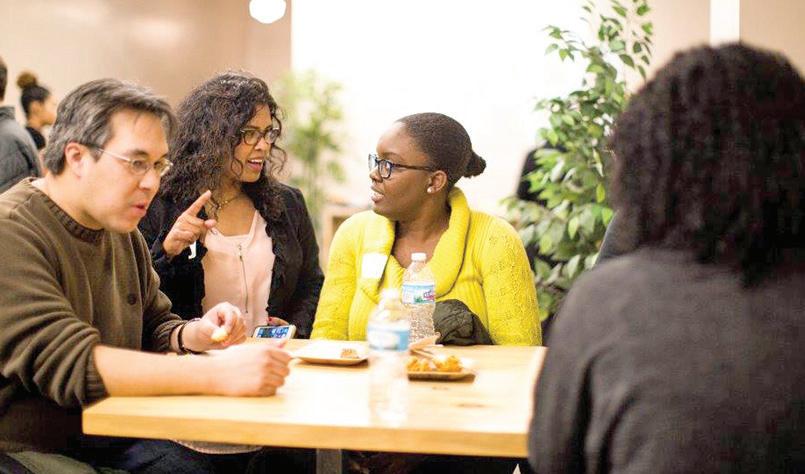
GCC is founded on the realization that true cybersecurity relies on an ecosystem of matrixed organizations and the understanding that each organization is incentivized to only manage within its own boundaries. Between those boundaries, natural gaps exist in a variety of forms — disparities in knowledge, talent, standards, sector practices, infrastructure and scale.
Continued from B1
it operates for generations to come. This year’s event is a first step in addressing the challenges in cultivating diverse talent and combating cybercrime. We are excited to work with the Cortex CEO Sam Fiorello and the rest of his leadership team to launch these efforts from this important hub of innovation and collaboration in St. Louis.”
Cyber threats are rising exponentially. In fact, cybercrime increased 600 percent in 2020 and is expected to continue to increase through rapid 5G transformation. Concurrently, the industry is currently not meeting job demand and as the threats become more diverse, so too must the teams put in place to defend against them.
“The currency for hightech jobs is talent. We need to broaden our efforts to develop a well-prepared workforce to tackle the fast-changing world of cybersecurity,” said Sam Fiorello, president & CEO,
Cortex Innovation Community.
“With the launch of the Global Center for Cybersecurity @ Cortex, we will be able to transform our approach to pairing a well-skilled, diverse, workforce with the critical challenges facing the cybersecurity world.” GCC is founded on the realization that true cybersecurity relies on an ecosystem of matrixed organizations and the understanding that each organization is incentivized to only manage within its own boundaries. Between those boundaries, natural gaps exist in a variety of forms — disparities in knowledge, talent, standards, sector practices, infrastructure and scale. Each poses a common threat to the whole community. At the event speakers and panelists discussed how to holistically address and reverse these threats.
Industry leaders who participated in the event included:
• Masha Sedova, Co-founder and President of Elevate Security
• Lamont Orange, CISO of
Netskope
• Gen. Jim Clapper, Former U.S. Director of National Intelligence
• Steve Hill, Deputy Director in the UK National Security Secretariat of the Cabinet Office
• Chris Inglis, Nominee for National Cyber Director in the Executive Office of the President
“Much of our talent lies in diversity and now more than ever we need to give our communities the encouragement and tools to participate in the greatest challenge facing our Allies since the last war,” said Greg Sim, founder of 2020Partners. With a vision of “A World More Equal and Secure” GCC will host an annual Net Measure event to provide data and insights that address issues relevant to CISOs and their teams, regardless of organization size or location.

By Danielle Brown
Of the St. Louis American
Upon exiting the lower level escalators at the Saks Fifth Avenue store in the Plaza Frontenac Mall, you’ll immediately become fascinated by the works in Shevaré Perry’s “She Is Her, I Am She,” art exhibition. The collection includes mixed media collages, digital portraits and poetry that explore Black womanhood, beauty and fashion.
n “I think art is a good starting point for a lot of people who may not know about different topics but want to learn about them and understand current events, I feel like it’s important to share my process and use my art to spark conversation and dialogue surrounding topics that are hard.
The display is a cohesive compilation from pieces in her collections, “Adventures of Wynk,” “Moments of Freedom” and a new project titled “She Is Her, I Am She.” “I was thinking about myself and how a lot of times, because I have so much going on, it’s like there are different versions of Shevaré in different places,” Perry said. Perry’s first body of work, “Adventures of Wynk,” a combination of 3D mixed media collages, and poetry explores the history of musical icons Lena Horne, Erykah Badu, Diana Ross and Josephine Baker. It centers on how they overcame adversity.
- Shevaré Perry
After researching the four women, Perry began creating poems which then inspired her to create the story of Wynk, a fictional character from the future that travels back to the past on a journey of self-discovery and connects with them through poetic dialogue.
“When I researched Josephine Baker’s background about being a dancer at the cotton club, I thought it would be interesting to tie the cotton club to freedom and emancipation,” Perry said. “In the poem she says this is nothing, but a modern plantation life we’ve seen dance and entertained using the state of our domain. This is nothing but a modern plantation.”
Her work from “Adventures of Wynk” was featured in The Charles H. Wright Museum of African American History in Detroit and that inspired her to create art showcasing AfricanAmerican hair - but not in chronological order. “I created a story and I think for me storytelling is where I start a lot of times with inspiration in poetry and words,” Perry said.

Photo by Jennifer Sarti / St. Louis American
Artist Shevaré Perry’s show opened Thursday, May 6, 2021 at Plaza Frontenac Saks Fifth Avenue. She uses a combination of written word and mixed media to create her art.
“I think about how I feel about certain words or what those words actually mean and if they have other meanings or how I can turn the words into different analogies.”
For Perry, an artist and educator, art allows her to feel free through her creativity, which is where “Moments of Freedom” comes from. She took everything she learned along the way with different concepts and techniques, which resulted in its development.
“The work that I create is a constant reminder that this moment exists but it’s literally just a moment.” Perry said. In her newest collection, “She Is Her, I Am
She,” Perry places her hand in collage work, digital text portraits of women including Beverly Johnson, and a poem with the following message “She is her, I am she’ full of joy and grief. She laughs, her cries, she wipes her eyes.”
It also includes an homage to her younger self, her parents, and grandparents with the poem: “She is her, I am she.” Full of DDG and MAP, dashes of Luci and Annie. I am them, they are me.”
I started thinking about how my joy has to be

By Danielle Brown Of the St. Louis American
The 111th Annie Malone May Day Parade’s theme of resilience and perseverance comes at a perfect time, as the world is working toward recovering and getting back to some form of normal in the wake of the 2020 coronavirus pandemic. COVID-19 left the Annie Malone Children and Family Service Center uncertain about its annual arade. Over the years it has become a major fundraiser that combines entertainment and support for local children and families in crisis.
“When the city shut down, we had to shut down,” Sara Lahman, CEO of Annie Malone, said. “We initially thought we would still have it, but then two weeks, before we decided it wasn’t going to work.”
Thanks to Koran Bolden, national motivational speaker, and his friend Vanessa Townsend, who now works for the center, the pair was able to help organize a virtual parade last year. In total, the organization raised more than $80,000 for children and families in need of their services
While this year’s annual event will yet again be in a virtual format, the center was able to prepare
By Danielle Brown
Of the St. Louis American
The Repertory Theatre of St. Louis’ Andrew W. Mellon Playwright-in-Resident Regina Taylor, recently premiered The Black Album.Mixtape Dinner. The event was presented via the organization’s YouTube and Facebook pages with a discussion about the intersectionality of race for African Americans in St. Louis. Rebeccah Bennett, founder of Emerging Leaders, moderated the conversation featuring a crosssection of the community. Speakers included Jamilah Nasheed, former Missouri state senator; Shay Gillepsie, diversity business development manager for World Wide Technology and founder of Color Coded Kids; Kayla Reed, co-founder and executive director of Action St. Louis; Tef Poe, rapper and activist; and Hana Sharif, artistic director at The Repertory Theatre of St. Louis. Chef David Kirkland of Turn Restaurant — who prepared a four course meal — joined the panel on being part of St. Louis and the Black experience. Nasheed, who grew up in the Darst-Webbe projects, experienced substantial loss while living in her southside neighborhood. When her father returned from the Vietnam War, he was killed in a drive-by shooting. Two years later, her mother committed suicide. Nasheed grew up with her

grandmother. “If you can’t make it in St. Louis, you can’t make it anywhere,” Nasheed said. “It’s very traumatizing for a child to grow up without
Chef David Kirkland of Turn Restaurant — who prepared a four course meal — joined the panel on being part of St. Louis and the Black experience.
doesn’t
I
because
is the
Bennett expressed that the places of greatest pain also have the greatest medicine. She posed the question, “what is the potent medicine that helps to advance liberation within these spaces?’ Reed responded, noting that liberation starts with knowing how to properly define it and a willingness to dismantle white supremacy.
Most practicing Christians believe the church can enhance race relations in this country by welcoming people of all races and ethnicities, new research finds.
But 29 percent of Black practicing Christians say they have experienced racial prejudice in multiracial congregations, compared to about 10 percent who report such an experience in monoracial Black churches. And a third of Black Christians say it is hard to gain leadership positions in a multiracial congregation.
The Barna Group and Racial Justice and Unity Center survey included 2,889 U.S. adults, with 1,364 of them meeting the definition of “practicing Christians – people who say they have a strong faith belief and have attended church within a month.
“Racial injustice is like a disease,” writes Michael Emerson,
co-principal investigator.
“Our research has found that the disease has not gone away even as the supposed antibodies of multiracial churches have multiplied. Racial injustice has mutated into new forms.”
The report defines multiracial churches as congregations where no one ethnic or racial group comprises more than 60 percent of the congregation.
“For attendees of color, joining diverse worship environments might mean ceding traditions, influence or preferences,” Emerson, who is white, explains.
Black practicing Christians (68 percent) are more than twice as likely as their white counterparts (32 percent) to link racial inequalities in housing, income and jobs to ongoing discrimination.
White practicing Christians are almost three times as likely as their Black counterparts to say such inequality occurs, “be-
Be humble, be forgiving, be what the Lord asks
By James A. Washington
They say no one can ever lead a perfect life. Flaws, faults and mistakes are unavoidable consequences of being human. God lets us know through the sacrifice of Jesus Christ that handling our imperfections is as important as acknowledging that we do indeed have them. Allow me to call upon spiritual insight for a moment and declare that humility is an essential ingredient of any Christian’s makeup - or at least it should be, given our understanding as the byproduct of personal imperfection. A truly humble person would never look down upon someone else, nor rationalize the thought that he or she is better. The reason, I imagine, must be their personal recognition of that old saying, “there but for the grace of God, go I.”
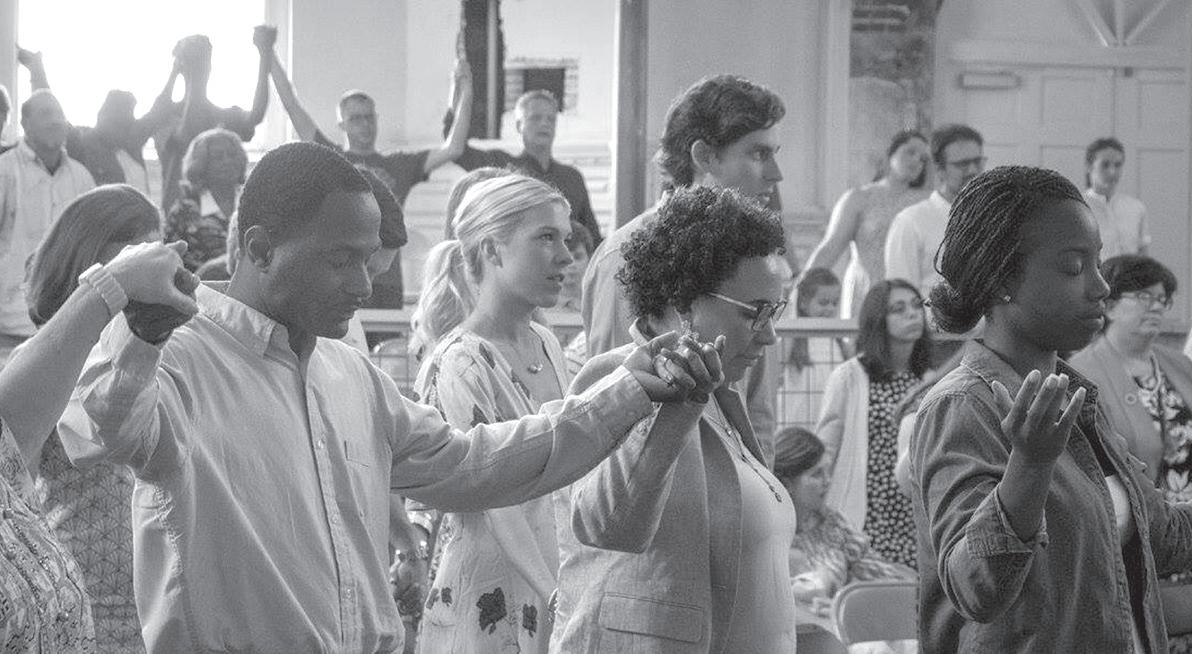
cause many Black fathers leave their families.”
Glenn Bracey, a Black man and the other co-principal investigator for the research, said in the report’s introduction that the new study aims “to uplift the Church — not to shame it.”
Even in multiracial churches there can be “a pattern in which the powerful and advantaged deny or minimize the social structures that sustain their dominance.”
Throughout the Bible there are countless references to living a life devoid of ego and pride. As a matter of fact, according to Paul, humility is a prerequisite for the presence of the Holy Spirit.
Bracey, assistant professor of sociology and criminology at Villanova University, added: “It appears that racial divisions and stereotypes in society are not only present, but often more concentrated, in the church.”
The research also showed white practicing Christians in multiracial churches appeared to have a greater sense of awareness about past and present racial injustice and have more of a desire to deal with it.
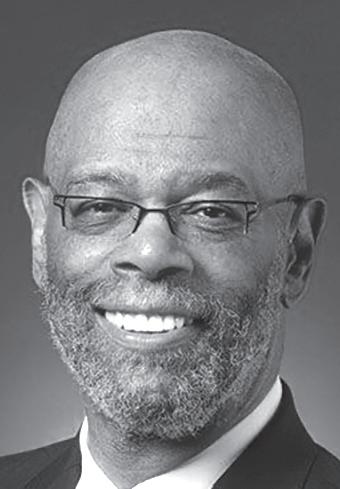
“But the fruit of the Spirit is love, joy, peace, patience, kindness, goodness, faithfulness, gentleness and self control…Since we live by the Spirit, let us keep in step with the Spirit. Let us not become conceited, provoking and envying each other.” Galatians 5:22-26.
Now, I don’t know about you, but conditioning yourself to live humbly is pretty difficult, particularly nowadays. As I have so often said, we live in a world that measures the sub-
St. Louis County Circuit Court is hiring an Accountant II to perform professional accounting work of moderate difficulty. Work involves maintaining established accounting systems, participation in specialized accounting functions, and preparation of specialized accounting reports and statements. Work is reviewed through periodic supervisory conferences, reports submitted, and achievement of stated goals.
MINIMUM QUALIFICATIONS:
Graduation from an accredited college or university with a Bachelor’s Degree in Accounting and 2 years professional experience in accounting; preferably including 1 year of public sector accounting experience; or any equivalent combination of training and experience. The salary range is $36,192.36 - $57,907.56. This position is eligible for 10% addition to pay. TO APPLY: Complete an online application and submit a resume and cover letter by the end of the day on May 25, 2021: http://agency. governmentjobs.com/stlouis/default. cfm EOE. Please contact the Human Resources Department at 615-4471 (voice) or RelayMo 711 or 800-735-2966 if you need any accommodations in the application process, or if you would like this posting in an alternative form.
THE CITY OF JENNINGS JOB OPPORTUNITIES
The City of Jennings is accepting applications for Code Enforcement Inspectors, Deputy Building Commissioner, Correctional Officers, Public Works Street/Park Laborers, Court Clerk, Accounting Clerk, Finance Director, P/T Clerks, Recreation Center Administrative Assistant, P/T Bus Driver, P/T Concession Stand Workers, P/T Umpires, & P/T Scorekeeper. Please see the full job descriptions on our website at www.cityofjennings. org. Applications are available at the Jennings City Hall or on the website. The City of Jennings is an equal opportunity employer. All applicants will be considered for employment without attention to race, color, religion, sex, sexual orientation, gender identity, national origin, veteran or disability status.
In-Home Child Care located in Ferguson is looking for a Part-time Child Care Assistant for more information call 314-736-0105
Christian congregations at multiracial churches deal with different opinions on social justice, equality issues just as America does. Almost two times as many Black Christians link racial inequalities in housing, income and jobs to ongoing discrimination than their white counterparts.
Photo courtesy of ChristianNewsPost
The report said white churchgoers who attend multiracial congregations are more likely than those in monoracial congregations to agree that “historically, the United States has been oppressive to minorities.” Almost half — 48 percent — of white practicing Christians in multiracial congregations agreed, compared with 38 percent of those who attend primarily white congregations.
stance of a person by the accumulation of money, possessions, position and status. Even if we think it’s unwarranted.
To obtain a humble state of mind as a matter of course can seem impossible, but in order to live according to the word of God, it is mandatory.
“For whoever exalted himself will be humbled and whoever humbles himself will be exalted.” Matthew 23:12.
I believe this is serious stuff and can only be comprehended, let alone adhered to, if one can look deep inside oneself and see the personal character flaws that each of us has. You see I think this is the reason Christ said, “He who is without sin cast the
first stone.”
The real meaning behind this is once you do it, then real forgiveness must follow. Who would dare be arrogant enough not to humble himself in the eyes of God and forgive his fellow man’s transgressions?
That brings me to the role of the church in this regard. If there was ever a place where the concept of forgiveness is guaranteed, it’s supposedly the church. But you must remember that the church is not a perfect place either. The key to all of this is what happens after you fall, after you sin, after you back slide.
Falling and failing are inevitable. Getting up is not. If you ask the Holy Spirit for a helping hand, I’m told you’ll get one.
You see I’ve got to believe God is a God of another chance
About half (51 percent) of white practicing Christians attending multiracial churches say they are motivated or very motivated to address racial injustice, compared with 28 percent of those who attend primarily white congregations. The report, which suggests resources for churches seeking racial progress, includes comments from other experts, including one who noted that just reading a report or attending a conference is not sufficient.
Barna Group, a Californiabased research firm, described itself in the report’s preface as having a “predominantly white team” that has sought out leaders and churchgoers of color as “a step in our own repentance toward segments of the Church we haven’t fully represented and served in our work.”
The overall sample of 2,889 respondents had a margin of error of plus or minus 1.8 percentage points.
because I’ve blown so many chances myself. I’ve ruined so many opportunities and yet so many blessings still have come my way.
Hell, I woke up this morning! Or should I say Heaven, I woke up this morning?
The least I can do is to show up in church on Sunday to let others know this is a place to come and bring an imperfect life in search of the perfect truth. Flaws and all, God loves me and every now and then that’s something I need to be reminded of. Church is probably the best and only place where that can happen. The challenge is to remember you can never feel comfortable about casting that first stone. May God bless and keep you always.
AUCTION
St. Cecilia accepting Food Service bids for 21-22. Breakfast, lunch, snack. Cost + fee contract. Submit by 6/15/21. 353-2455 or eroth@stc-stl.org for info.
Responsible for the manage- ment and direction of system application development for the Guidewire suite of products. In particular, release planning, soft- ware coding, standards enforce- ment and supervisory duties. Ensures user satisfaction across all owners of Guidewire applications in the organization. Ensures on-time delivery of Policy Center, Claim Center and Billing Center as well as other systems assigned to teams led.
To apply, please visit: https://www.safetynational.com/ careers-page/
An organization in the Central West-End area is looking for an Executive Assistant to the CEO join our team. The candidate should be well-organized detail-oriented, ability to multitask with great follow-up skills, strong written and verbal communication skills; and comfortable providing administrative support for the CEO and other executives (as needed). Send resume to: exec-asstjob@mail.com EOE COORDINATOR
Responsible for providing client/ customer support for the department’s
The City of Crestwood is seeking bids for the Joseph Sappington Log Cabin Transportation and Relocation Project. Qualified contractors may obtain a Project Manual online at www.cityofcrestwood.org For questions, contact Charlie Henke at chenke@ caseengineeringinc.com Bids are due by 3:00 p.m. on Thursday, May 27, 2021.
The following people are in debt to Gateway Storage Mall. The contents of their storage unit(s) will be sold at auction to compensate all or part of that debt. Auction at the Dupo location will be held online with www.storageauctions.com on May 18, 2021 at 10:00 AM. A cash deposit will be REQUIRED for all winning bids. 202 – Jim White, 414 – Kim Anderson, 48 – Branden Whelchel, 105 – Gregory Brumit, 123 – Calvin Humphries Auction at the Royal Heights location will be held online with www.storageauctions.com on May 18, 2021 at 10:00 AM. A cash deposit will be REQUIRED for all winning bids. Bel. B03 – David Harris, Bel E06 – Kayla Dale For all rules, regulations and bidding process, please contact www.storageauctions.com . All other questions, please call 618-233-8995 or mail 17 Royal Heights Center, Belleville, IL 62220.


& GROWN STL OUTREACH COORDINATOR
Job Description:
Implements the day to day operation of the residential service program within the particular department including supervision, transportation, medication administration, skill building, group outings, etc.
Minimum Skills / Qualifications:
· 21 years of age or older
· High School Diploma or Equivalent
· Psychology or related field or equivalent in experience
· Valid Driver’s License
· Experience with S.E.D. children preferred EOE/M/F/H/V Apply online at marygrovechildren.org or fax resume to 314-584-6105.
HIRING PROFESSIONAL CLEANER POSITIONS
The Clean-Tech Company continues to have a Weekly Job Event every Thursday, 1PM-4PM, at the Clean-Tech Office- located at #211 South Jefferson Avenue, St. Louis, MO, 63013!
Known & Grown STL Outreach Coordinator-Build a resilient, equitable food community by promoting farmers within 100 miles of STL. 32 hours/week; $29,600-$32,800; paid health insurance. Email resume & 3 references to jobs@moenviron.org by 5/17/21. See moenvironment.org/careers for full listing.
EXECUTIVE ASSISTANT –DE SMET JESUIT
Visit https://www.desmet.org/ about/careers
EOE M/F/D/V, Committed to DEI HEAD BASEBALL COACH/TEACHER –DE SMET JESUIT
Visit https://www.desmet.org/ about/careers.
EOE M/F/D/V, Committed to DEI

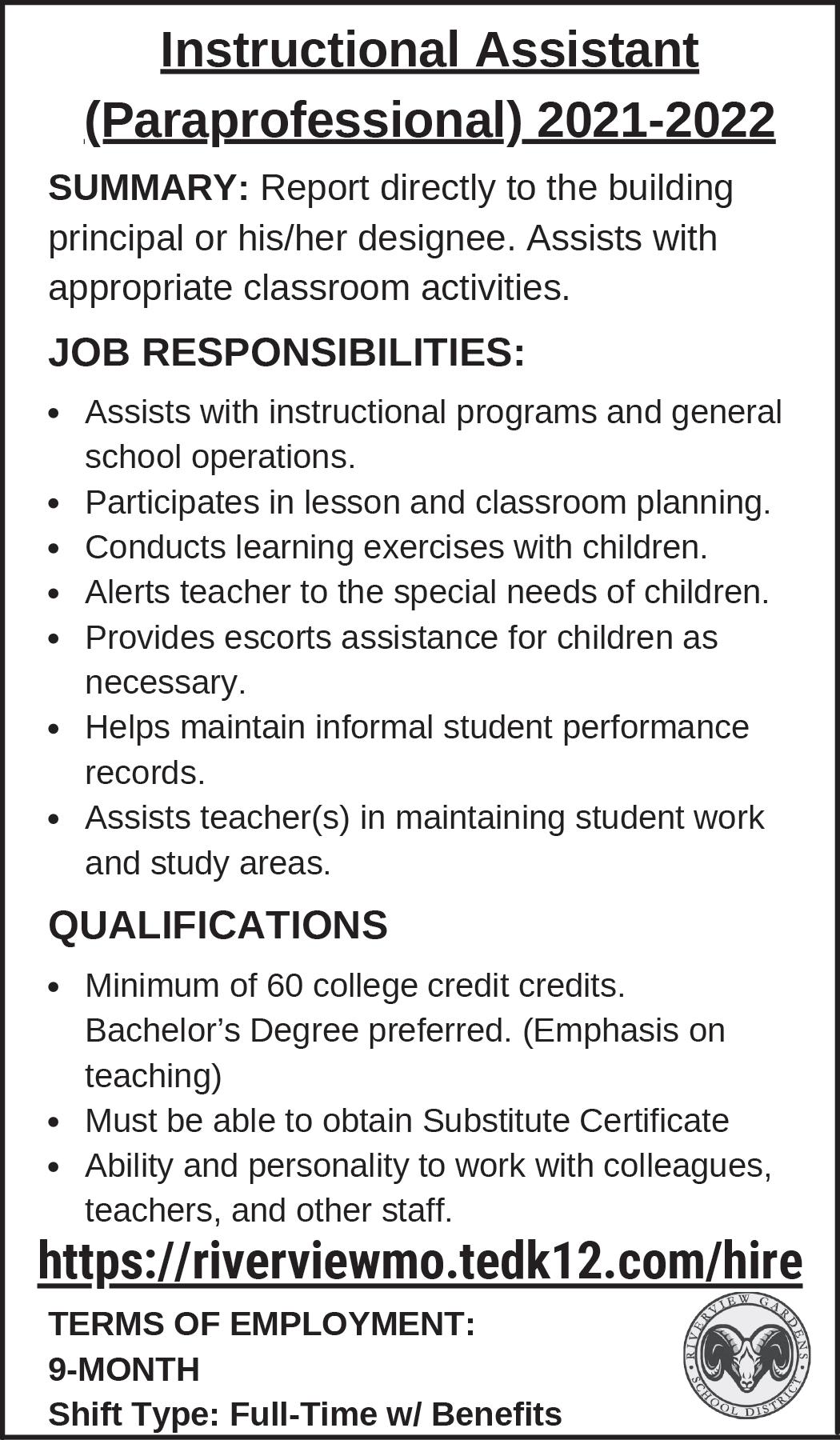
Energy Engineer - Building Services – 51580: This position is responsible for managing the day-to-day energy efficiency of a medical school campus, 6.5 million square feet, focused on education, research, clinical service delivery at Washington University School of Medicine (WUSM). This position supports the utility information system as it relates to cost recovery, energy conservation, degradation recovery and benchmarking of energy use on campus. To be considered for this full-time 40 hour per week career opportunity. The successful candidate would meet the following required qualifications: Bachelor’s degree in engineering with 5-plus years of experience in HVAC design.
Retail Manager/Buyer - Bear Necessities – 51368: The Bear Necessities Retail Manager/Buyer (BNRM/B) oversees the annual stock plan and daily operations of the Bear Necessities store on the South 40 residential campus. The retail manager ensures smooth running of operations to maximize sales and minimize costs. To be considered for this full-time 37.5 hour per week career opportunity. The successful candidate would meet the following required qualifications: Bachelor ’s degree in business administration or a related field with a minimum of three years of experience as a retail store manager/buyer with emphasis on retail, to include apparel and health & beauty supplies, institutional or related setting or an equivalent education and experience to equal seven years. Experience in Open to Buy and retail store budgeting. Project Coordinator (Temporary / Part-time) - EVC for Civic Affairs & Strategic Planning – 51550: The Executive Vice Chancellor for Civic Affairs and Strategic Planning (EVC CASP) is charged with overseeing the university’s efforts to be “in St. Louis for St. Louis.” The hallmark of these efforts will be the St. Louis Commitment. A coordinated set of programs and initiatives that will advance the St. Louis region while strengthening the university in its missions of teaching, research, and patient care. The Project Coordinator will support the planning process to create the St. Louis Commitment. In partnership with other staff in the office, the Project Coordinator will provide staff support to the SLIWG and its co-chairs and the sub-working groups that each focus on a specific area of the plan for the Commitment. To be considered for this part-time 15 hours per week career opportunity. This is a temporary position not to exceed six months. The successful candidate would meet the following required qualifications: Bachelor’s degree, 2+ years of related professional experience with a particular focus on any or all of the following: community relations, community-based work, and/or community partnerships; group or project strategy, implementation, and management; strategic communications; corporate responsibility. Washington University School of Medicine is currently recruiting the following open positions for the Human Research Protection Office (HRPO): Expedited Review Specialist - Human Research Protection Office – 50607: This position is an IRB committee member designated to conduct and approve expedited review of biomedical and behavioral research involving human participants. Like review by the convened IRB, expedited review must fulfill all the requirements of review according to applicable HHS and FDA regulations. Required Qualifications: Bachelor’s degree, Must have working knowledge of the federal regulations governing research, including the new HIPAA regulations.
IRB Review Analyst - Human Research Protection Office – 51101: This position plays in integral role in the review of human subject research. Each research study requiring review by a fully convened committee will be thoroughly screened by the IRB Review Analyst to ensure information is accurate, complete and sufficient for the committee to determine if the study is approvable under the guiding regulatory criteria and institutional policies. The IRB Review Analyst will attend committee meetings to document the committee’s meeting actions, deliberations on regulatory and ethical issues and changes to the research plan determined by the committee to be necessary to secure approval. Required Qualifications: Bachelor’s degree, REQUIRED LICENSURE/CERTIFICATION/REGISTRATION:
(ICP) status preferred (successful applicant will be expected to obtain CIP upon meeting eligibility requirements).
Position: Manager of Corporate and Foundation Giving Reports To: Director of Major Gifts and Planned Giving Summary: This position will provide oversight for corporate and foundation annual giving as well as manage a portfolio of prospects. This role is also responsible for securing philanthropic gifts and sponsorships and developing prospect strategies, cultivation, solicitation, and follow-up activities with corporate and foundation major gift prospects and donors.
Interested applicants should visit the following URL for full details and to apply online: https://www.cbizems.com/extranet/ recruiting.aspx?id=2A2725CB7BD6-40E1-9E124BEC3B92A10E&src= stlamerican&rqid=9804494A-961C4D7A-903A-ACB96A5E3513

We are looking for an individual who takes pride in their work and works with excellence. Must be reliable, flexible (hours rotate) work nights and weekends, travel between two campuses and lift 50lbs. You must pass a background check and drug screening. Salary commensurate with experience. Apply at 4675 Page Blvd. between 9am - 5pm Monday-Thursday.
CIVIC ENGAGEMENT MANAGER
Great Rivers Greenway is seeking a Civic Engagement Manager. Go to www.greatriversgreenway. org/jobs-bids and submit by June 9, 2021.

LETTING NO. 8729
SBC Contracting, Inc. is seeking qualified African American, Hispanic American, Asian American and Women Owned Business Proposals for the St. Louis BPS Citywide Sidewalk Project, Letting 8729. Scope of work includes concrete flatwork excavations, sawcut, backfill & seeding, asphalt and concrete speed humps and other misc. site work items.
Proposals are due via email by close of business on May 28, 2021 Attn: Annie Stika. Email: ajstika@aol.com
Plans and specs can be viewed at no charge on the St. Louis BPS website Stlouismo.gov and clicking on BPS online plan room.
SBC Contracting is committed to obtaining maximum DBE utilization on this contract and welcomes any questions by contacting Mike Woodling, Project Mgr., at (314) 503-4437.
Paric Corporation is seeking proposals for the following project: MU Middlebush Farm - NextGen Center of Excellence for Influenza Research. Proposals are due no later than June 2, 2021 02:00 PM
The project includes ground up pre-engineered 8300SF metal building on 3.55 Acres, development of land, new building, and build out. Drawings, specifications, and other related contract information may be obtained at http://operationswebapps.missouri.edu/pdc/adsite/ad.html. Electronic bid sets are available at no cost and may be printed as desired by the plan holders.
A prebid meeting will be held at 1:00 p.m., C.T., May 17, 2021 via web conference. A site walkthrough will be held at 1:00 p.m., C.T., May 18, 2021. Additional instructions regarding where to meet will be provided at the conclusion of the Zoom meeting portion of the prebid meeting. Those on site must follow the University’s Show-Me Renewal Guidelines. https://renewal.missouri.edu/safety-expectations/ Join Zoom Meeting: https://umsystem.zoom.us/j/92683524766?pwd= SHFMcnByRzVHeGhBcWlqOVpRMzRwZz09
Meeting ID: 926 8352 4766
Passcode: CP191901
Call In #: (312) 626-6799
Your proposals are due no later than June 2, 2021 02:00 PM PARIC CORPORATION IS AN EQUAL OPPORTUNITY


INVITATION FOR BIDS FOR VARIOUS PUBLIC HOUSING RENOVATIONS & REPAIRS ISSUE DATE: MAY 13, 2021
The St. Louis Housing Authority (SLHA) is seeking bids from qualified general contractors to perform the following projects:
Pre-Bid Meetings: May 27, 2021
9:00 AM – RD 21-01
Clinton Peabody Water Damage/ Mold Unit Repairs, 20 Units
9:30 AM – RD 21-02 Clinton Peabody Fire Damage Unit Repairs, 3 Units
1:00 PM – RD 21-11 Euclid Plaza Roof Replacement & Building Exterior Repairs
Pre-Bid Meetings: May 28, 2021
9:00 AM – RD 21-03
Parkview Elevator Replacement 9:30 AM – RD 21-12
Parkview Building Exterior Repairs
Bid documents and pre-bid meeting information will be available May 13, 2021, at https://www.slha.org/for-partners/vendors/
SLHA will receive sealed proposals for IFBs until 3:00 p.m. (CST), June 14, 2021
Krista S. Peyton Contracting Officer
Notice is hereby given that The
Metropolitan St. Louis Sewer District (District) will receive sealed bids for Maplewood – Blendon Combined Sewer Relief Phase I under Letting No. 10030015.2, at this office, 2350 Market Street, St. Louis, Missouri 63103, until 02:00 PM on Tuesday, June 15, 2021
There is no pre-qualified category for this project
Plans and Specifications are available for free electronic download. Please go to MSD’s website and look for a link to “ELECTRONIC PLANROOM.” Plans and Specifications are also available for viewing or purchase at Cross Rhodes Reprographics located at 2731 S. Jefferson Avenue, St. Louis, MO 63118 or at www. stlmsdplanroom.com. All bidders must obtain a set of plans and specifications in order to submit a bid in the name of the entity submitting the bid.
The Metropolitan St. Louis Sewer District is an Equal Opportunity Employer.
The St. Louis Community College invites Separate sealed bids for Housekeeping Maintenance Agreements No. M-344-Corporate College. There will be a non-mandatory walkthrough scheduled for the the Corporate College at 9am on May 18, 2021. Bids will be received by the Board of Trustees of the St. Louis Community College until 2:00pm Local time, May 27, 2021, and publicly Opened at the office of the Supervisor of Maintenance, 3221 McKelvey Rd., Bridgeton MO 63044 and read Aloud. Specifications and bid forms may be obtained from the supervisor’s office.
An Equal Opportunity and Affirmation Action Employer
Professional
Issued May 14, 2021 by St. Louis Development Corp. Responses Due: June 8, 2021
This RFQ is available at https://www.stlouis-mo.gov/ government/procurement.cfm
St. Louis Development Corp. is seeking
Statements of Qualifications from qualified firms to provide professional engineering & design services for the 20th Street Multimodal Improvements Project, from Market St. to St. Louis Ave. The project includes design, engineering and ROW for a CMAQ Grant.
Respondents must take affirmative action to ensure that employees & applicants for employment are not discriminated against because of their race, color, national origin, ancestry, disability, sex, religion, creed, age, familial status, marital status, sexual orientation, gender identity or expression. Goals of 25% MBE participation and 5% WBE participation will be sought for all work proposed on the project.
Contact: Lori Goerlich, Major Project Manager GoerlichL@stlouis-mo.gov
FY 2022 & 2023 CITYWIDE SIDEWALK CONTRACT
Sealed proposals will be received by the Board of Public Service in Room 301 City Hall, 1200 Market Street, St. Louis, Mo. Until 1:45 PM, CT, on JUNE 1, 2021, then publicly opened and read. Plans and Specifications may be examined on the Board of Public Service website http://www.stl-bps.org/ planroom.aspx (BPS On Line Plan Room) and may be purchased directly through the BPS website from INDOX Services at cost plus shipping. No refunds will be made.
Bidders shall comply with all applicable City, State and Federal laws (including MBE/WBE policies).
All bidders must regard Federal Executive Order 11246, “Notice of Requirement for Affirmative Action to Ensure Equal Employment Opportunity”, the “Equal Opportunity Clause” and the “Standard Federal Equal Employment Specifications” set forth within and referenced at www.stl-bps.org (Announcements).
SEALED PROPOSALS will be received by the Board of Public Service in Room 301 City Hall, 1200 Market Street, St. Louis, Mo. Until 1:45 PM, CT, on June 8th, 2021, then publicly opened and read. Plans and Specifications may be examined on the Board of Public Service website http://www.stl-bps.org (BPS On Line Plan Room) and may be purchased directly through the BPS website from INDOX Services at cost plus shipping. No refunds will be made.
A pre-bid conference for all contractors bidding on this project will be held on May 19th, 2021 at 10:00 am at the C9 Garage, 915 North 9th Street.
Bidders shall comply with all applicable City, State, and Federal laws (including MBE/WBE policies.)
All bidders must regard Federal Executive Order 11246, “Notice of Requirement for Affirmative Action to Ensure Equal Employment Opportunity”, the “Equal Opportunity Clause” and the “Standard Federal Equal Employment Specifications” set forth within and referenced at www.stl-bps.org (Announcements).
METROPOLITAN ST. LOUIS SEWER DISTRICT ST. LOUIS, MISSOURI GRAND GLAIZE WWTF TRANSFORMER AND GATE REPLACEMENT (IR) CONTRACT LETTING NO. 13564-015.1
ADVERTISEMENT FOR BIDS
Notice is hereby given that The Metropolitan St. Louis Sewer District (District) will receive sealed bids for Grand Glaize WWTF Transformer and Gate Replacement (IR) under Letting No. 13564-015.1, at this office, 2350 Market Street, St. Louis, Missouri 63103, until 02:00 PM on Wednesday, June 30, 2021. All bids are to be deposited in the bid box located on the First Floor of the District’s Headquarters located at 2350 Market Street, St. Louis, MO 63103, prior to the 2:00 p.m. bid deadline. Bids may also be submitted electronically at stlmsdplanroom.com. Refer to the Contractor’s notice page within the Bid Form for additional information on electronic submission of bids.
A general description of the work to be done under these contract documents is described as follows.
• Removal of one (1) existing sluice gate and replacement of one (1) sluice gate with a new manual sluice gate at the Primary Effluent and RAS Splitter Structure.
• Removal of two (2) existing sluice gates and replacement of two (2) sluice gates with new electrically actuated sluice gates at the Chlorination Mixing Chamber Structure.
• Demolition of four (4) existing sluice gates at the Final Clarifier Splitter Box.
• Demolition of two (2) existing sluice gates at the RAS Splitter Box.
• Demolition of two (2) existing electrical transformers and replacement with two (2) new transformers.
• Associated demolition work.
The Engineer’s Opinion of Probable Cost for this project is $699,000.
Bids will be received only from companies that are pre-qualified by the OWNER’S Engineering Department for: Mechanical/Electrical/Plumbing or Building Construction. Plans and Specifications are available for free electronic download. Please go to MSD’S website and look for a link to “ELECTRONIC PLANROOM.” Plans and Specifications are also available for viewing or purchase at Cross Rhodes Reprographics located at 2731 S. Jefferson. St. Louis MO 63118. All bidders must obtain a set of plans and specifications in order to submit a bid in the name of the entity submitting the bid. The Metropolitan St. Louis Sewer District is an Equal Opportunity Employer.
A non-mandatory Pre-Bid conference will be held in accordance with Article 6 of the instructions to Bidders.
The City of St. Louis Department of Human Services is soliciting proposals for the Continuum of Care (CoC) Planning Projects, funded with FY2019 CoC Planning Grant funds.
5 Projects will be funded: 1) CoC Administration, 2) Housing Program Excellence, 3) Data, Needs & Gaps Analysis, 4) Coordinated Entry Change Implementation, and 5) CoC Application Support. Approximately $301,800 available.
Beginning April 30, 2021, RFP packets will be available via pick-up at the: Department of Human Services Homeless Services Division 1520 Market, Room 4065 St. Louis, MO 63103
Or at the following website: https://www.stlouis-mo. gov/government/procurement/
To participate in the Zoom Webinar email Amy Bickford at bickforda@stlouis-mo.gov to receive the Webinar link.
Questions may be referred by email only and must be submitted on or before May 25, 2021, to Amy Bickford, Chief Program Manager, Homeless Services Division, at BickfordA@stlouis-mo.gov
The RFPs closing date is 4:00 p.m., June 1, 2021.
Sealed bids will be received by the Webster Groves School District at the District Service Center Building, 3232 South Brentwood Blvd., Webster Groves, MO 63119, until TUESDAY, JUNE 1, 2021 BY 10:00 A.M. CDT for the Design Package No. 2B District Safety, Security and Accessibility Improvements to Multiple Schools. Bids will be opened publicly at that time.
Drawings and specifications for this project are on file at the office of the Architect, Hoener Associates, Inc., 6707 Plainview Avenue, St. Louis, MO 63109, (314) 781-9855, FAX (314) 781-0163.
Information as to bidding instructions and requirements for procuring bidding documents may be obtained from the Architect.
Not less than the prevailing hourly wage rates, as determined by the State of Missouri, Division of Labor Standards, shall be paid all workers employed on this project.
The Board of Education reserves the right to waive technicalities, to select any contractor filing a proposal, and to reject any or all bids.
A PRE-BID SUMMARY PRESENTATION MEETING WILL BE CONDUCTED ON WEDNESDAY, MAY 19, 2021 FROM 8:00 A.M. UNTIL 9:00 A.M. AND WILL BE HELD AT THE DISTRICT SERVICE CENTER LOCATED AT 3232 SOUTH BRENTWOOD BLVD. WEBSTER GROVES MO. 63119.
PROJECT SITE VISITS FOR CONTRACTORS WILL FOLLOW ON WEDNESDAY, MAY 19, 2021 FROM 9:00 A.M. UNTIL 2:00 P.M. AND ON THURSDAY, MAY 20, 2021 FROM 8:00 A.M. UNTIL 2:00 P.M. FOR ALL EIGHT SCHOOLS. LOCATIONS AND ADDRESS WILL BE SUPPLIED AT THE PRESENTATION MEETING. CONTRACTORS WILL BE REQUIRED TO SIGN IN AT EACH SCHOOL BEFORE COMPLETING THEIR SITE VISIT.
ATTENDANCE AT THE PRE-BID SUMMARY PRESENTATION MEETING ON MAY 19, 2021 IS MANDATORY
By: Mr. Rob Steuber Construction Project Manager
Paric Corporation is seeking proposals for the following project: 1717 Olive Street, St. Louis.
The project consists of renovating the Historic recognized Butler Building located on 1717 Olive Street. St Louis, MO into 384 units including amenity spaces such as a pool, walking track, fitness room and community areas. The project also includes an enclosed parking garage and retail spaces. We are currently soliciting design build bids only for the Fire Sprinkler System, Plumbing, HVAC, Electrical and Elevators. Bids will be due on June 08, 2021 at 2:00pm. A walk thru will be scheduled for May 20, 2021 at 9:00am. The remaining packages will be bid in early fall (September).
A VIRTUAL Meet and Greet for the project will be held on May 11, 2021 at 1:30pm. Please join the session by clicking the link below.
For any specific questions or if would like to find out more detailed information on this opportunity, please contact Ruben Guzman at 636-561-9563 or RMGuzman@paric.com.
All bids should be delivered to Paric via e-mail (bids@paric.com) or fax (636-561-9501).
PARIC CORPORATION IS AN EQUAL OPPORTUNITY EMPLOYER
Millstone Weber, LLC is soliciting proposals for the removal and replacement of airfield concrete pavement, including demo, excavation, pavement markings, underdrains, electrical, and miscellaneous other work as indicated on the plans and specifications for the STL Lambert Reconstruction of Rnwy 12R-30L from Txwy R to Txwy G project. Please phone 636-688-8794, fax 636-949-3129 or email bob.stubbs@millstoneweber.com or ryan.taylor@millstoneweber.com, quotes to Bids@millstoneweber.com by 12:00 PM CDT on 05/17/2020. For Access to Plans and Specifications, please email bids@millstoneweber.com
Responses for St. Louis Community College on RFP B0004077 for Management and Operation of the Mobile Enrollment Unit will be received until 3:00 PM (CST) on June 4, 2021. Go to https://stlcc.bonfirehub.com for bid document and submission.
The Assessment Books or Records, containing the assessments of taxable property in the City of St. Louis for the year 2021, are open for inspection in the Assessor’s Office, Real Estate Records Section, Room 114, City Hall. The 2021 values can also be viewed at https://www.stlouis-mo. gov/data/address-search/
The Board of Equalization will meet beginning on July 6, 2021, during regular business hours, and will remain in session pursuant to State Law. Any person may appeal the assessment of their property by emailing appeal@stlouis-mo.gov or writing to the Board of Equalization, 1200 Market St., Room 120, St. Louis, MO 63103.
Any appeal to the Board of Equalization is required to be filed in the Office of the Assessor on or before July 12, 2021.
Michael R. Dauphin
City of St. Louis Assessor https://www.stlouis-mo.gov/government/departments/assessor/index.cfm
Sealed bids for the 2020 CRS Pavement Rehabilitation, Area B project, St. Louis County Project No. CR-1813, will be received electronically thru the County’s Vendor Self Service portal at https://stlouisco. munisselfservice.com/Vendors/ default.aspx, until 11:00 a.m. on June 9, 2021
Plans and specifications will be available on May 10, 2021 from the St. Louis County Web Site (www.stlouiscountymo. gov) or by contacting Cross Rhodes Print & Technologies, 2731 South Jefferson Avenue, St. Louis, Missouri 63118 (314) 678-0087.
St. Louis Community College will receive separate sealed bids for CONTRACT NO. F 21 505, Renovation for Respiratory Care at St. Louis Community College at Florissant Valley Campus, until 2:00 p.m. local time Thursday June 3, 2021 Bids will be publicly opened and read aloud at the office of the Manager of Engineering and Design, 5464 Highland Park, St. Louis, MO 631101314. Specifications and bid forms may be obtained from the Manager’s office, at the above address or by calling (314) 644-9770.
An Equal Opportunity and Affirmative Action Employer
PREBID: Friday, May 21, 2021 at 9:00 am at the Southeast Entrance of Emerson Center at Florissant Valley
Wachter, inc. is soliciting, subcontractor bids for the St. Louis County Police Precinct #3 project, due on June 11, 2021, at 2:00 pm. Plans and specs are available at Cross Rhodes Reprographics (314-678-0087) or can be accessed electronically at https://drive.google.com/drive/folders/13mEE7JfF8_ RbxfYoAxixRHBgi_dQrqu?usp=sharing.
This project requires a good faith effort be made to include MBE and WBE firms on the construction team and we encourage these firms to submit bids to achieve these goals. This project is subject to the Missouri Prevailing Wage Laws and is sales tax exempt.
Please send your bids to bids@wachterinc.com or call our office at (636) 464-3555 with any questions.
EOE/AA
RFP 2021
The Saint Louis Zoo seeks bids from qualified contractors to submit proposals for Bond, Disclosure and Tax Counsel RFP 2021. Bid documents are available as of 5/12/2021 on the Saint Louis Zoo website: stlzoo.org/vendor
Allete, Inc.
Project No. 2360-272
NOTICE OF APPLICATION ACCEPTED FOR FILING AND SOLICITING COMMENTS, MOTIONS TO INTERVENE, AND PROTESTS (April 29, 2021)
Take notice that the following hydroelectric application has been filed with the Commission and is available for public inspection:
a. Application Type: Amendment of Project Boundary
b. Project No: 2360-272
c. Date Filed: December 22, 2020, and supplemented on April 27, 2021
d. Applicant: Allete, Inc.
e. Name of Project: St. Louis River Hydroelectric Project
f. Location: Island Lake Reservoir, Fish Lake Reservoir, and Whiteface Reservoir in St. Louis County, Minnesota
g. Filed Pursuant to: Federal Power Act, 16 USC 791a - 825r
h. Applicant Contact: Greg Prom, Minnesota Power, 30 West Superior Street, Duluth, Minnesota, 55802-2093, (218) 355-3191
i. FERC Contact: Mark Carter, (678) 245-3083, mark.carter@ferc.gov
j. Deadline for filing comments, motions to intervene, and protests: May 31, 2021. The Commission strongly encourages electronic filing. Please file comments, motions to intervene, and protests using the Commission’s eFiling system at http://www. ferc.gov/docs-filing/efiling.asp. Commenters can submit brief comments up to 6,000 characters, without prior registration, using the eComment system at http://www.ferc. gov/docs-filing/ecomment.asp. You must include your name and contact information at the end of your comments. For assistance, please contact FERC Online Support at FERCOnlineSupport@ferc.gov, (866) 208-3676 (toll free), or (202) 502-8659 (TTY). In lieu of electronic filing, you may submit a paper copy. Submissions sent via the U.S. Postal Service must be addressed to: Kimberly D. Bose, Secretary, Federal Energy Regulatory Commission, 888 First Street NE, Room 1A, Washington, DC 20426. Submissions sent via any other carrier must be addressed to: Kimberly D. Bose, Secretary, Federal Energy Regulatory Commission, 12225 Wilkins Avenue, Rockville, Maryland 20852. The first page of any filing should include docket number P-2360-272. Comments emailed to Commission staff are not considered part of the Commission record.
k. Description of Request: Allete, Inc (licensee) is proposing to amend its project boundary at three of the project’s reservoirs (i.e., Island Lake Reservoir, Fish Lake Reservoir, and Whiteface Reservoir) to more accurately reflect the lands needed for project purposes. The licensee would remove approximately 191 acres of land around the reservoirs that are currently leased to individuals for private, residential use, while preserving an upland buffer area around the reservoirs. Additionally, the licensee would add 469 acres of land around the three reservoirs to be managed as Natural Character Areas for scenic and environmental protection uses. The proposed project boundary adjustment would result in a net increase of 423 acres of project lands including the removal of residential lands, addition of environmental protection lands, as well as other additions to reflect actual acreages of islands and recreation areas inside the project boundary.
l. Locations of the Application: In addition to publishing the full text of this document in the Federal Register, the Commission provides all interested persons an opportunity to view and/or print the contents of this document via the Internet through the Commission’s Home Page (http://www.ferc.gov) using the “elibrary” link. Enter the docket number excluding the last three digits in the document field to access the document. At this time, the Commission has suspended access to the Commission’s Public Reference Room, due to the proclamation declaring a National Emergency concerning the Novel Coronavirus Disease (COVID-19), issued by the President on March 13, 2020. For assistance, contact FERC at FERCOnlineSupport@ferc.gov or call toll-free, (886) 208-3673 or TYY, (202) 502-8659. Agencies may obtain copies of the application directly from the applicant.
m. Individuals desiring to be included on the Commission’s mailing list should so indicate by writing to the Secretary of the Commission.
n. Comments, Protests, or Motions to Intervene: Anyone may submit comments, a protest, or a motion to intervene in accordance with the requirements of Rules of Practice and Procedure, 18 CFR 385.210, .211, .214, respectively. In determining the appropriate action to take, the Commission will consider all protests or other comments filed, but only those who file a motion to intervene in accordance with the Commission’s Rules may become a party to the proceeding. Any comments, protests, or motions to intervene must be received on or before the specified comment date for the particular application.
o. Filing and Service of Documents: Any filing must (1) bear in all capital letters the title “COMMENTS”, “PROTEST”, or “MOTION TO INTERVENE” as applicable; (2) set forth in the heading the name of the applicant and the project number of the application to which the filing responds; (3) furnish the name, address, and telephone number of the person commenting, protesting or intervening; and (4) otherwise comply with the requirements of 18 CFR 385.2001 through 385.2005. All comments, motions to intervene, or protests must set forth their evidentiary basis. Any filing made by an intervenor must be accompanied by proof of service on all persons listed in the service list prepared by the Commission in this proceeding, in accordance with 18 CFR 385.2010.
Kimberly D. Bose, Secretary.

by Jennifer Sarti /
Perry sits in front of one of her installations at Plaza Frontenac Saks Fifth Avenue on Thursday, May 6, 2021. This piece has special meaning for her since it is created from old photographs of her and her mother.
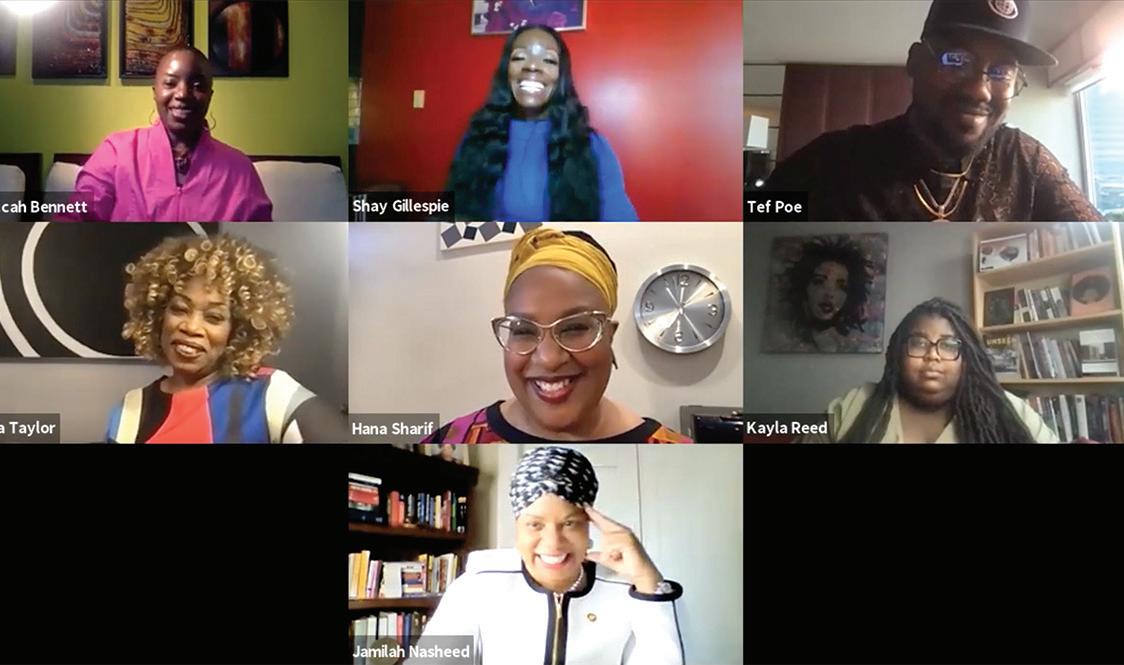
“I choose this city because I’m an artist who doesn’t believe in arts for art’s sake alone,” Sharif said. “I chose this work because I believe fundamentally that art is a method for transformation and liberation.”
“Liberation is about dismantling systems of oppression,” Reed said. “In a country like the United States, I don’t think that’s possible just within one locality, but I think we should try anyway to build power and practice liberation as we seek to dismantle these systems. “ Sharif, who divided her upbringing between Atlanta, Georgia and Houston, Texas; and Taylor, who grew up in Dallas, Texas, both agreed they came to St. Louis because of its roots, rich in Black history.
Taylor designed The Black Album.Mixtape to be thoughtprovoking. It serves in a way for everyone to hear and reckon with each other accordingly. The project’s first event in the series was a collaboration with Southern Methodist University, where participants submitted original works of multimedia art, video, audio, written work and discussion pieces describing Black experiences and impressions. The project is an ongoing piece that brings at-
tention to the impact of 2020, COVID-19, and recent socioeconomics protests and tasks. Taylor, a Golden Globe award-winning actress, has entertainment credits in television, film and Broadway theatre. The Rep is the St. Louis region’s most distinguished professional theatre company. Since its founding in 1966, The Repertory Theatre of St. Louis has operated as a fully professional theatrical company which belongs to the League of Resident Theatres, The League of St. Louis Theatres, and is a constituent member of Theatre Communications Group, Inc. Visit www.repstl.org for more information.
stronger than my grief and so my ‘she’ has to be stronger than her because she is where the joy is,” Perry said With much of her creations, Perry always makes it her mission to have a message in relation to the construct of race including her 30+2 poem about systematic racism, police brutality and coronavirus.
may not know about different topics but want to learn about them and understand current events,” Perry said. “I feel like it’s important to share my process and use my art to spark conversation and dialogue surrounding topics that are hard.”
Perry is overjoyed to have her current art exhibit on display at Saks Fifth Avenue and strongly encourages everyone to visit it.
“I think art is a good starting point for a lot of people who
noon-6 p.m. daily at Saks Fifth Avenue, 1 Plaza Frontenac Drive. Guests can book a tour with Perry to learn about the specifics of her exhibition by visiting www.gallery7347.com. Perry has an extensive background in fashion with a bachelor’s degree in fashion and apparel design from Philadelphia University and an MBA in International Business and Management from American Intercontinental University London. She is a graduate of Parkway North High School. Learn more about Perry, here: https://www.shevareperry. com/ Art Continued from C1
“Come out to Saks to see the exhibition, it’s amazing,” Perry said. “I’m really excited about how it turned out visually, especially within that space.” Tours are available from
Presents its 52nd Annual Debutante Ball Cotillion “ ”
East St. Louis Alumnae Chapter of Delta Sigma Theta Sorority, Inc. presents its 2021, 52nd Annual Debutante Ball Cotillion, Rise of the Phoenix: Renewal, Grace & Beauty, to be held virtually on Sunday, May 23, 2021, 5:30 p.m. To attend, please register at www.dsteslac.org. As one of the East St. Louis Alumnae Chapter's signature programs, the Debutante Ball has been celebrated for over 51 years with this year’s ball introducing three (3) beautiful, empowered and elegant young women as they make their debut to society. The challenges of 2020 make this ball exceptionally special as this will be East St. Louis Alumnae’s first ever Virtual Debutante Ball. It promises to be an evening of extravagance, glamour and magnificence.
Adriann Adams-Gulley serves as this year’s Chairperson with Twyla Winters-Jenkins and Dahlia Phillips as the Co-Chairpersons and Riquita Bonner-Henry and Kayla Creek as the choreographers. Pamela M. Weston is president of East St. Louis Alumnae Chapter of Delta Sigma Theta Sorority, Inc.

Debutante Brittany McDonald is the daughter of Ryan McDonald and Keywana McDonald. Debutante Brittany is a graduating senior at Althoff Catholic High School in Belleville, Illinois.

Debutante Ernice Kelly Thrash, is the daughter of Kelly Thrash Jr. and Marquitta Murry Debutante Ernice is a graduating senior at East Saint Louis Sr. High School in East Saint Louis, Illinois.

Nariah and her mom, Jo Anne

Debutante Ernice and her mom, Marquitta
Debutante Nariah Izola Parks is the daughter of Alvin Parks Jr. and Jo Anne Hamilton Parks. Debutante Nariah is a graduating senior at Althoff Catholic High School in Belleville, Illinois.
for an even better celebration.
U.S. Rep. Cori Bush, D-St. Louis, will serve as the parade’s grand marshal; Tammie Holland, media professional, will be the emcee; DJ Charlie Chan Soprano, legendary global DJ will be master of the mix. There will also be performances by the Saint Boogie Brass Band and the Best Dance and Talent Center.
“The goal is always to give back to the streets just because of the history of the Annie Malone Parade,” said Townsend, director of community relations. “This is something for the community to showcase their talents and gifts.”
Jarel Loveless, chief development officer, a native of East Saint Louis, Illinios, has been working with the agency since November and can recall as a kid coming across the river with his family after church to watch the parade.
“The moment you mention
the parade everybody has their own unique story about it and I think that’s the coolest thing to be on staff on here and continue to hear those stories about the agency,” Loveless said.
Like Loveless, Townsend too has childhood memories of the parade. Until her senior year of high school, she marched at the event and her children have since continued the tradition.
“It’s generational for me and then to be able to now work for the organization in which you marched in and be part of the planning for it, is a surreal moment for me,” Townsend said. Lahman said next year the organization is coming back outside with a vengeance so be prepared for an even bigger event in 2022.
“We’re already working on lining up more bands for next year, we’ve got some great partnerships we’re not ready to announce yet,” Lahman said. “2022 is gonna be very exciting, we’re putting together an event the community will remember.”
On Sunday, May 16, a twohour virtual experience will be filmed at the center, 2612 Annie Malone Drive from 2- 4 p.m.
Watch online at www.anniemalone.com or on the Annie Malone center’s Facebook page. Midwest BankCentre is the Title Sponsor and will match $25,000 in donations. Other sponsors include Bayer; St. Louis Community College; Brown & Crouppen; HW Kia of West County; Parkside Bank & Trust, Mercy, Emerson; and SteadyRain.
Founded in 1888, The Annie Malone Children & Family Service Center first began as the St. Louis Colored Orphan’s Home. A trailblazer of the cosmetics industry, Malone established Poro College which housed her business’s office, a manufacturing facility, and a training center. In addition, she was President of the Board of Directors of the St. Louis Colored Orphans’ Home from 1919 to 1943. In honoring her legacy, the home was renamed Annie Malone Children’s Home in 1946. Today, the organization operates as a multi-service center in the community that meets the social and educational needs of inner-city youth and families throughout the St. Louis region.


The Regional Council’s Career Connections program brings cutting-edge technical education to schools across St. Louis, helping local employers fill a skills gap in the vocational trades and offering a pathway to a middle-class career for young people in the region.

Carpenters Union’s Career Connections program ramps up to meet local demand
Special to the American
The St. Louis-Kansas City Carpenters Regional Council (CRC) is working to fill a skills gap in St. Louis, and a unique program is helping. The Regional Council’s Career Connections program brings cutting-edge technical education to schools across St. Louis, helping local employers fill a skills gap in the vocational trades and offering a pathway to a middle-class career for young people in the region.
“Students and their families sometimes become so focused on earning a four-year degree that they overlook or are unaware of vocational options,” said Dr. Art McCoy, former Jennings School District Superintendent of Schools. “Career Connections provides students an opportunity to learn about skilled trades in a way that prepares them for a successful career. It has been a wonderful addition to our schools.”
n “Career Connections provides students an opportunity to learn about skilled trades in a way that prepares them for a successful career. It has been a wonderful addition to our schools.”
– Dr. Art McCoy, former Jennings School District Superintendent of Schools
The Career Connections Program works in partnership with educators to provide students with a practical CTE education taught by skilled instructors. With more than 1,700 students in 35 programs across our region, graduates have gone on to earn six-figure salaries as union carpenters. Local high schools include Roosevelt, Beaumont, Jennings, South
Tech, North Tech and many others.
“Career Connections helps ensure St. Louis has the next generation of skilled workers it needs to continue growing,” said Al Bond, Executive Secretary-Treasurer of the CRC. “The program provides a leg up to students, who start their career with knowledge and skills that other apprentices don’t have, and it helps ensure a pipeline of talented workers to the local employers who hire them.”
Along with vocational training, the program also includes preparation in the skills that research shows employers value most, including goal setting, positive attitude, punctuality, teamwork and taking initiatives. The various skills Career Connections graduates learn help make them employable, while local companies remain competitive and ensure St. Louis can build high-quali-
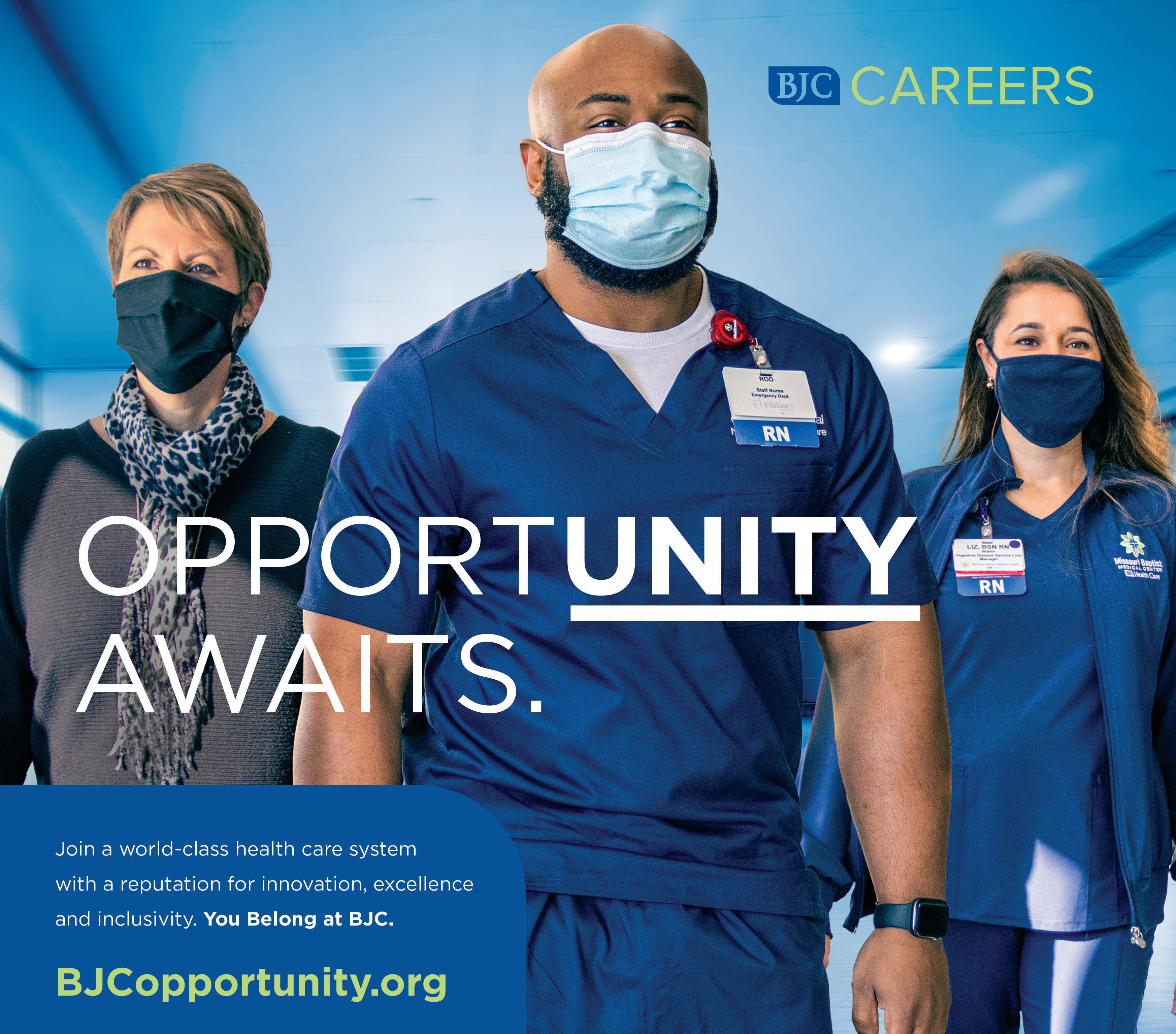
Southwestern Illinois College (SWIC) has received a $7.5 million grant for a new manufacturing education hub in Belleville.
The Advanced Manufacturing Center will break ground this year and will welcome students into its new facilities by fall 2022. The project will be completed in two phases: with the first creating a new precision machining pathway; and the second aiming to expand career training for roles in industrial electricity and welding manufacturing.
The program will also address equity gaps in the region – with SWIC creating a new diverse recruitment program to help ensure more minority and women students can participate in newly created training.
“One of Southwestern Illinois College’s primary goals is to train students for well-paying, highly skilled, in-demand career fields, and the construction of a manufacturing training academy will bolster these efforts,” said SWIC President Nick Mance.
“In light of the unemployment rate and economic distress in the area, it is more crucial than ever that students embark on a viable career pathway that leads directly to steady employment paying a living wage or better.”
“Manufacturing remains an important and growing industry for our state, and we are poised, with the right investments, to ensure more Illinoisans get the opportunities they need to train for these 21st century jobs,” said Brian Durham,

Executive Director of the Illinois Community College Board (ICCB).
“These training academies will address a skills shortage in the manufacturing industry and adopt
new technologies in manufacturing production while meeting the needs of many regional employers, located in these downstate communities.”
Illinois Governor JB Pritzker said in a release
the grant is part of the Rebuild Illinois capital program.
“It builds on the funding that Rebuild already devotes to upgrading and expanding facilities at Illinois community
colleges, cementing their key role in continuing to train our young workforce, and lifelong learners keeping their skills fresh,” Pritzker said.
“Today is just one indicator of the job and
skills growth our state is seeing. Workforce investments like those we’re announcing here foreshadow even more good jobs we can fill in the future.”

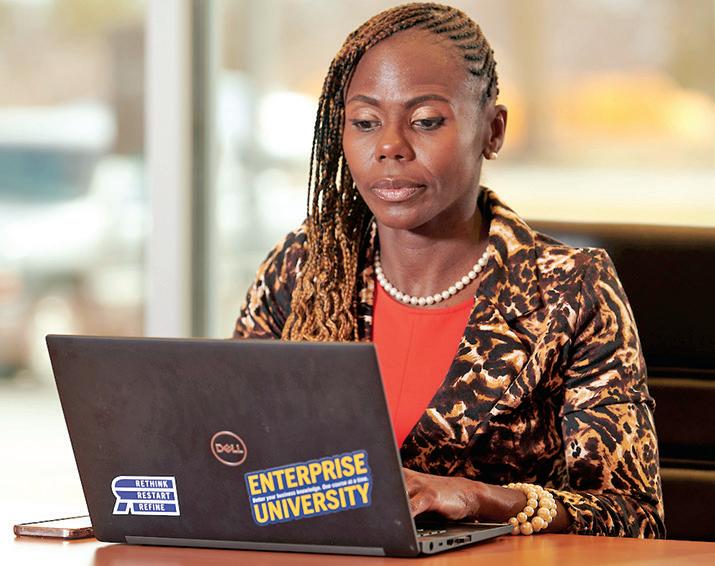



environment
offer more
As summer approaches, Six Flags Mid-America is offering a host of job opportunities throughout the amusement park.
Importantly, Six Flags is “committed to creating a diverse and inclusive environment for our team members and guests,” according to its website.
Six Flags is offering new higher pay rates, and employ-
ees can earn $12 and up an hour for select positions. It can work out flexible schedules where employees can work as little or as much as they would like.
Training is provided and leadership roles are also available.
Teenagers seeking their first job, students seeking college credit internships and retirees seeking part-time positions are
all welcome to apply. Featured employment opportunities include:
• Food Service - Earn up to $12 per hour while prepping, serving and selling food in our restaurants and outdoor carts.
• Ride attendants - Six Flags is best known for its amazing thrill ride line up and you could earn $12 per hour loading
guests into coasters and launching them off.
• Park Services - Our Park Services team keeps the grounds of Six Flags clean. Whether it is refreshing restrooms, wiping down patios or sweeping the midways, this position keeps the park looking great. Earn up to $12 per hour.
• Security - The Six Flags
Security team monitors various aspects of day-to-day operations. From assisting employees and guests with questions to enforcing company policies and state laws. Positions are available that offer $13+ per hour.
• Lifeguards - A variety of lifeguard positions from water slide attendants to deep water lifeguards are available and can pay up to $13 per hour. Six Flags will also provide Ellis & Associates lifeguard training.
• Entertainment – Six Flags is looking for talented dancers, singers and actors for the 2021 season. Audition videos are being accepted. To apply for these and other positions, visit www.sixflags/ stlouis.com/jobs

Provided by BJC HealthCare
Every day, through innovative treatments, worldclass clinicians, cutting-edge technologies, strategic partnerships and dedicated, compassionate caregivers, BJC HealthCare changes medicine for the better.
We’re proud of the awards, recognition and accolades we’ve received for being a great health care provider and a great place to work. Our goal is to be the national model among health care integrated delivery organizations in patient advocacy, clinical quality, medical research, employee satisfaction and financial stability.
We are more than 31,000 strong, with 4,350 physicians serving communities in the greater St. Louis Metropolitan area through our 13 hospitals and a network of health service organizations.
In our never-ending drive for excellence, we strive to enhance the quality of life for each patient under our care. And we need people like you to help us do it.
From the nurses, technicians and physicians on the front line of patient care, to the IT professionals who enable life-saving technologies, to those who keep our facilities safe and clean — everyone here has a role in making the world’s best medicine better.
BJC is successful because we attract the best talent and continually encourage staff to grow by improving and refining existing skills, or acquiring new knowledge and experiences.
Come grow with us
At BJC you’ll find ample opportunities to learn and grow in whatever career you pursue. More than 40% of our job placements last year came from internal candidates.
We provide you with a wide variety of personal and professional development opportunities to ensure that you have every chance to succeed.
At BJC, your career will benefit from on-the-job learning and mentoring from some of the most accomplished health care professionals in the nation. The BJC Career Services Center helps employees who want to identify skill sets that will enable them to grow in their current role or train for a new career at BJC.
More reasons to join
In addition to career-development and advancement opportunities, BJC offers competitive compensation and a comprehensive benefits package that includes a dedicated focus on the health and well-being of employees and their family members. These include programs and services to support and strengthen your physical health, such as medical and pharmacy coverage,
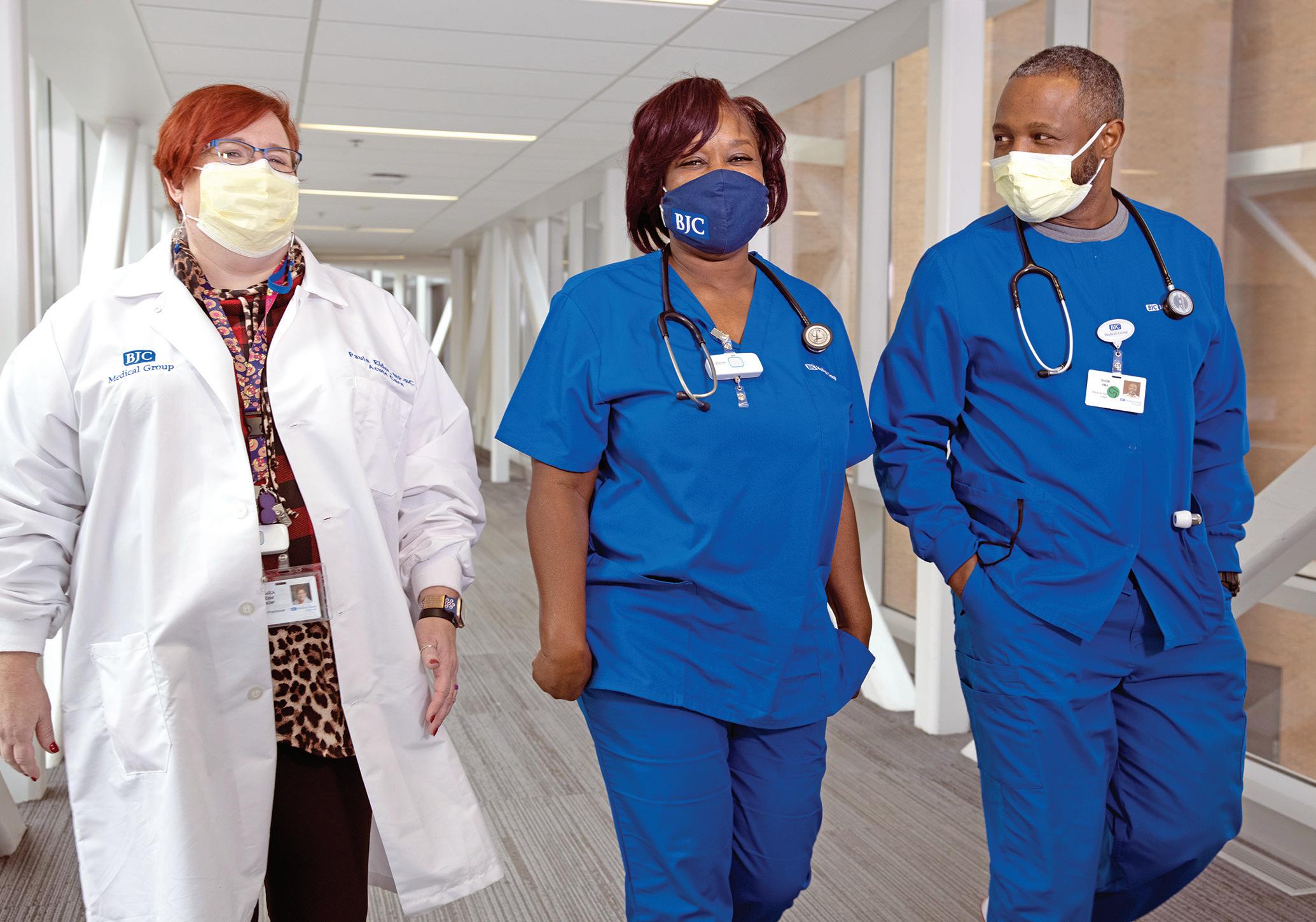
BJC is successful because we attract the best talent and continually encourage staff to grow by improving and refining existing skills, or acquiring new knowledge and experiences.
dental and vision coverage, and numerous well-being programs.
Your financial health, including retirement, is also important. Through our close partnership with Vanguard and Mercer, BJC offers a pension plan or 403(b) plan, plus a 401(k) retirement savings plan with several investment options.
In addition, we offer Flexible Spending Accounts, disability and life insurance, plus many other benefits and services — even employee discounts on hundreds of consumer products and services. Learn more about BJC’s comprehensive Total Rewards package.
Keep on learning
You can also take advantage of BJC’s Tuition Assistance Program from day one. Our program provides financial assistance for employees pursuing continuing education or certifications that will enhance their career and contributions to BJC’s success. This is how we ensure our employees’ continued ability to move forward in their careers and maintain a team that is prepared to offer our patients the highest levels of expertise and service.
On their first day of work, full-time employees are eligible to receive up to $4,500 in tuition reimbursement per year for successful completion of classes related to their professional responsibilities.
You’ll join a highly diverse workforce
At BJC, diversity drives success. Our commitment to diversity and inclusion is at the heart of how we work with each other. It’s how we deliver care, how we partner with
Giving back to the

our community and how we do business. This is why we value and embrace the diversity reflected in our patients, our employees and partners and the many diverse communities we serve.
Join our team and discover what you like best about being a part of BJC
The team at BJC respects your talent and ambition to succeed, regardless of where you are in your career, which is why we’ve worked hard to
streamline our hiring process. Whether you’re a full- or part-time worker, a recent college graduate or a seasoned veteran, we urge you to visit our Getting Hired page to find information for prospective employees, as well as information about referral programs.

Former St. Louis Cardinals
player Xavier Scruggs is embracing his role as the franchise’s first diversity, equity and inclusion consultant for the team’s baseball operations department.
His daily work will emphasize:
— Helping the Cardinals organization present favorable change concerning diversity and inclusion efforts.
— Educating and preparing players for cultural differences in baseball and their communities.
— Equipping players with resources and tools that best help them understand how their influence can affect people positively or negatively.
“I’m also grateful to be

a part of positive change, and (President of Baseball Operations) John Mozeliak didn’t shy away from discussing that in our first conversation, about this position when I brought it up to him,” Scruggs said. “This position is about acknowledging the past and moving forward with intentionality around many issues.”
He is also anxious to share thought and ideas with other diversity and inclusion leaders in the business community.
“I’d love to talk with anybody who has experience creating just and equitable work environments. So, I may work on my steps from there,” he said.
During his 26-game career in 2014 and 2015, Scruggs registered 57 at-bats with three doubles and nine RBI.
MLB offers minority business tips
Since its creation in 1998, Major League Baseball’s Diverse Business Partners program has spent more than $1 billion with diverse-owned businesses and the Cardinals have been responsible for many of these expenditures. The program has grown
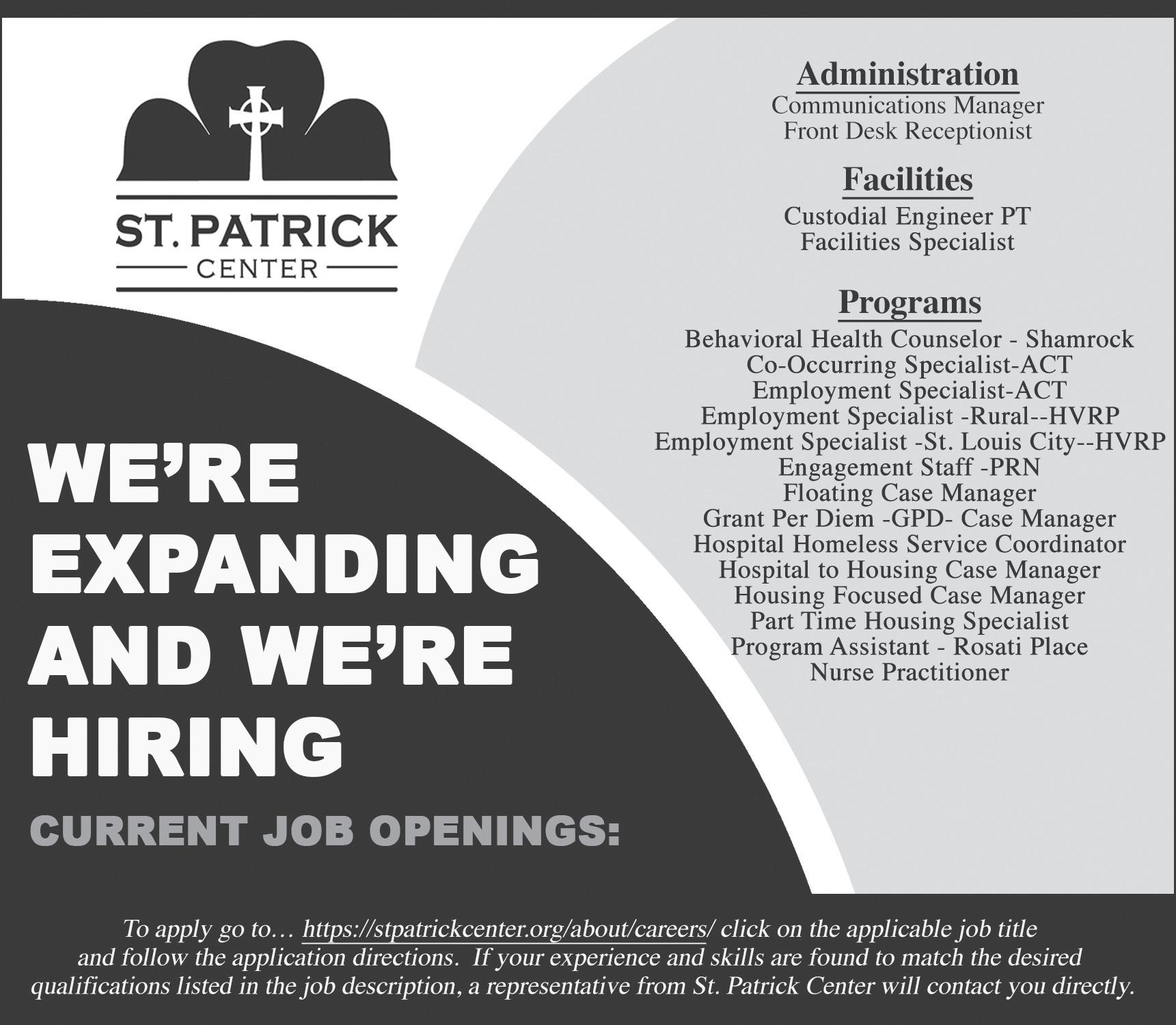
n Major League Baseball’s Diverse Business Partners program has spent more than $1 billion with diverse-owned businesses, and the Cardinals have been responsible for many of these expenditures.
since its beginning to not just include minority and women owned businesses but also veteran-owned, LGBT-owned businesses and small businesses.
MLB is offering these tips to minority entrepreneurs seeking business opportunities with the Cardinals or any of the other 29 franchises.
1. Know the Game of Baseball. Make it a habit to regularly check the baseball news and press release sec-
tions on MLB.com. Knowing the current issues or events in baseball can give your business a distinct advantage when proposing the use of your services.
2. Certify your business with one of MLB’s preferred certifying agencies. MLB encourages diverse businesses to contact National Minority Supplier Development Council (NMSDC), Women’s Business Enterprise National Council (WBENC), Small Business Administration (SBA), National
Gay and Lesbian Chamber of Commerce (NGLCC).
3. Be Specific. Know the scope of your business and how it can service baseball. Suggesting that your business can service all 30 Clubs may not be practical. Be prepared to know which teams and markets you can support.
4. Be realistic. Major League Baseball is proud of its world class brand. However, our franchises are small to medium size businesses. The demand for our business is competitive.
5. Know your competition. Be prepared to identify who your competition may be and why your company is the preferred choice.

Continued from D1
ty, safer, construction projects.
“It is very difficult to find enough skilled workers to perform all the work we have available,” said Bill Lowery,
The Career Connections Program works in partnership with educators to provide students with a practical CTE education taught by skilled instructors.
Project Executive with PARIC. “There are projects I would love for us to bid on, but we don’t have the workers available to do new projects in addition to projects we are already committed to. We are glad to see a program like Career Connection stepping in to fill that need for skilled workers.”
The St. Louis-Kansas City Carpenters Regional Council (CRC) represents more than 22,000 members in 33 local unions across Missouri, Kansas and Southern Illinois. To learn more about the Career Connections Program, visit carpdc,org or call (314) 269-5663.

An inclusive work culture mirrors the community the organization serves and yields many benefits for both the organization and its employees, says Angelica Ogando, founder and CEO of The Enriched Mind, LLC.
One of the key benefits of an organization having an inclusive work culture is that it has a lower turnover rate, Ogando says.
“If an organization is attracting more diverse candidates, it has people already in the organization who look like me, sound like me, and talk like me,” she notes.
“It is far less likely that I’m going to leave, especially if those other people who are like me are happy there.”
Another benefit to the organization is greater and higher-quality productivity.
“In an inclusive work culture, people feel respected and valued,” Ogando says. “Happy employees tend to give the best of themselves, generating higher-quality production. This ties into innovation. Do you have people who are different? If so, is your work environment one where people are encouraged to be themselves, be creative, and give their input?”
Employees should be recognized for their contributions, Ogando says. Recognition for bringing something different to the table, such as perspective from a diverse group, can create a very empowering work culture.
On the other hand, organizations that don’t have inclusive

work cultures tend to take steps backward in production and stagnate in terms of innovation.
“They have a higher turnover rate because they have disgruntled employees who feel like they’re being overworked and overlooked, they are not being seen and heard, and they are not being promoted,” Ogando points out.
“These organizations create cultures in which employees are unhappy and morale is low. The organization is not being innovative because employees
aren’t exchanging ideas. It is actually forcing people to leave.”
This impacts the bottom line in several ways. An inability to retain employees is costly as it requires resources for recruiting and training new employees.
In addition, the damage done by word of mouth by disgruntled ex-employees in the job market, in the marketplace, or on social media is immeasurable and difficult to contain.
Ogando says there are three main elements of creating an
inclusive work culture, including:
Self-Analysis—If the organization is trying to be more inclusive, it must do a self-analysis of where it stands in this pursuit. “Are you merely checking off boxes when it comes to diversity and inclusion, or do you have a strategy in place through which you are changing the culture to be more inclusive?” Ogando asks. “It’s about becoming self-aware. It is a challenge for an organization to sit down and say it is
lacking in its efforts and progress. However, that awareness will allow the organization to identify action steps and then take them.”
Education—What is true diversity and inclusion? “We think that diversity is just attracting a diverse pool and that it covers gender, race, and sexuality,” Ogando says. “This is not completely true because we forget the inclusion and equity components. We are hiring diverse people, but are we really being inclusive? Do
we welcome people who have disabilities? Are we hiring people who land on spots all along the spectrum? Are we making them feel included? A lot of companies are falling short when it comes to hiring people with disabilities—especially those with hidden disabilities— because they don’t understand and address the scope of it.” Training Programs— Figure out what employees need so that they feel they are valuable contributors to the organization. Do not assume that you know what each group needs; ask them.
“Create training programs and initiatives that tackle diversity, equity, and inclusion,” Ogando recommends. “Create employee resource groups in which people feel like they are being heard and understood, and someone is being an advocate for them. Train them because it is not enough to just hire diverse talent and invest in them by committing to their development and promoting them into management positions and executive-level roles.”
“Creating an inclusive work culture is not a final point,” Ogando explains. “It is an ongoing process. Once the organization undertakes its self-analysis, education, and training, it needs to assess progress internally and benchmark externally to see where it stands toward its goals. Then it needs to update its education and training to maximize its efforts in this incredibly important area.”

A Society for Human Resource Management (SHRM) study found that 57 percent of recruiters say their talent acquisition strategies are designed to attract diverse candidates.
Diversity is also important for prospective employees who are being recruited. An industry survey found that 67 percent of active and passive job seekers said that diversity is an important factor when considering companies and job offers.
Recruiters and talent acquisition leaders are being tasked to increase workplace diversity.
“So why is it so hard to move the needle,” asks the business website ideal.com, which was established by Somen Mondal and Shaun Ricci, who serve as CEO and COO, respectively.
“Is it a pipeline issue as it’s often argued? Are unconscious biases interfering with recruitment decision making? As with most complicated issues, it is all of the above,” they ask in an online blog.
As part of extensive online tutorial on increasing diversity in American workplaces, Ideal offers five tips to find qualified minority and female candidates.
Tip 1: Carefully write job posts to attract more diverse candidates
If you want to attract a more diverse candidate pool, the language you use in your job posting makes a difference. A study on job postings found those using masculine-type words like “ambitious” and “dominate” were less appealing to female applicants.

Tip 2: Offer workplace policies more appealing to diverse candidates
Research has found that one of the best workplace policies to attract diverse candidates is flexibility. A PwC survey found that compared to older generations, Millennials place more importance on a company culture that emphasizes work/ life balance. Offering flexibility such as work from home options and flexible hours not only helps you attract more diverse candidates, it helps prevent expensive employee turnover.
Tip 3: Use a personality assessment to recruit more diverse candidates
A valid and reliable personality assessment is a great tool to measure candidates’ personality traits, motivations, and skills. Personality assessments increase workplace diversity because they do not show adverse impact, that is, personality scores do not differ for minority group members. A study of 150 companies found that those that used a person-
ality assessment in their hiring had more racially diverse workforces.
Tip 4: Use sourcing meth-
ods that contain more diverse candidate pipelines
One of the reasons why candidate pipelines can be a bottleneck for diversity is a reliance on hiring through referrals. In general, people’s networks are comprised of people who are similar to them demographically. To increase the number of diverse candidates in your pipeline, take advantage of
third-party websites to post your open roles. Also, create a media-rich page of your company showcasing your culture, leadership and employees.
Tip 5: Seed your pipelines with more diverse candidates
Research featured in the Harvard Business Review found that when the final candidate pool has one minority candidate, he or she has virtually zero chances of getting hired. However, a “two in the pool effect” represents a promising method for reducing
Increasing the pool of diverse candidates for employment is on the minds of many business owners and CEOs. Diversity on the job is essential to future success for most of today’s top firms.
unconscious biases and increasing diversity in the workplace.
If there are at least two female candidates in the final candidate pool, the odds of hiring a female candidate are 79 times greater. If there are least two minority candidates in the final candidate pool, the odds of hiring a minority candidate are 194 times greater. Visit ideal.com/workplace-diversity to review the ideal.com diversity assessment and the company can assist employers.

By STL.works
No one is immune to falling into a slump at work. There are a multitude of reasons that keep us from leaping into the work day, excited to contribute:
• You have a bad manager
• You’re the bad manager
• You dislike your coworkers
• You’re unhappy with your salary
• You’re unhappy with your progression within the company
• You’re unhappy with your benefits
• You have issues with the company’s culture
While all of these have the potential to send you searching for a career change, it’s important to stop and consider if a company or practice area change would be all you need to stay on your current career path.
If you like what you do — and just not who you’re doing it for — your efforts are best spent finding a new team, department or company to work for.
What are you lacking in your current career?
Again, there are a multitude of reasons why people seek new career paths. It’s important to clearly define what yours are. It will give you the ability to avoid them when evaluating what you want to do next. In no particular order, here are the top reasons why most of us consider a career change:
• Dissatisfied with pay or salary potential
• Lack of healthcare or savings benefits
• No clear growth path for your position
• No opportunity to learn or advance skills
• Seeking a less stressful career
• Seeking a better work-life balance
• Seeking a better alignment between personal values and professional work
You might tick all these boxes, or you may have a completely different set of reasons why you’re seeking a midlife career change. Again, regardless of your reasons it’s just important to diagnose them now so you can avoid going through the same disappointments in the future.
Where can I start?
If you’re reading this you’ve likely already been wanting a new position, job, or considering a career change. There are three important steps you should walk through:
1. Evaluate your finances.
It’s truly a luxury to just be able to quit your job and figure it out later. For the vast majority of us we rely on our current job to pay our bills, our health care benefits and more. You need to look at your finances for two reasons: to determine what you want to be making and to determine what the path looks like to get there. Be practical. If you want to make a career change but the earning potential doesn’t align with the salary you need to support yourself, you’ll need to make some personal adjustments. Is the reduced salary worth it? Make sure you’re not trading one problem for another. If the career change you want to make will require education and training that can’t be done while working your current position, you’ll need to evaluate your monthly costs and save so you can cover your expenses during your training and transition into a new career.
2. Lean on the experience and expertise of others.
You need to talk to people who have made a career change and people who are in the industry you are interested in pursuing. Ask them why they
made a career change, how they did it and what they would change if they had to do it over again. Ask about specialities, practice areas, and local companies you might be interested in working for. You’re letting others know you have interest, giving them an opportunity to help if they can.
3. Educate yourself on the skills you lack.
While tapping your network will give you a baseline expectation for what you need to know, you’ll still need to do your due diligence in assessing what further level of training or education is needed to make a career change.Sometimes a career change looks enticing but doesn’t truly align with our abilities or interests.
Are you building on skills you already have?
Are you interested in learning these new skills, or do you see them as a barrier to your potential new career?
Are their local or online programs available to you to learn these skills and what are the associated costs?
Will you be able to complete the courses while working your current job?
Are there companies offering training on the job or tuition reimbursement?
What is a good midlife career change?
As adults it’s important that we maintain the youthful belief of no limits — we just need to pair that with reality. If you’re seeking a midlife career change in St. Louis, understanding the market opportunity across industries is important to choosing a path that has potential. Easy career changes that pay well are not as elusive as you might think. As a resource for St. Louis job seekers, STL. works knows the following industries are booming. They offer innovative paths towards skill and knowledge building, making them a more

attractive option for those who want to change careers without reentering a traditional education pathway.
Trade jobs are in high demand in the St. Louis area and nationwide. Careers in HVAC, as a plumber or pipefitter, carpenter, welder, electrician, and a heavy machinery or automotive mechanic have an average salary potential of $80,000 per year.
Technology
Technology is a critical component for all businesses. If you like the idea of keeping your career options open, technology is your golden ticket. Careers in web development, system architecture
and analysis, cybersecurity analysis, technical support, and app development are available across companies, industries, and locations. Along with accelerated programs and coding workshops, many companies will hire and train new employees into technology positions. Getting paid to learn will likely seem foreign to those of us still paying off student loans, but the technology sector is hungry for new talent so now is an opportune time to get started.
Manufacturing
Modern manufacturing jobs encompass both the trades and technology and offer incredibly satisfying work for people who prefer to work with their hands and enjoy being able to physically see what they’ve
helped to build through their efforts. Careers as a machinist, quality control inspector, CNC programmer, and precision machine engineer are available for those who are willing to invest in technical training through a certification program, training course, or associate’s degree.
Healthcare
If you want to work in an industry where you’re making a difference, it’s hard to beat healthcare.If a career as a radiology technologist, medical lab technician, pharmacy technician, physical therapy assistant, medical assistant, certified nursing assistant, or registered nurse interests you there are multiple pathways to gain the skills and experience needed to enter the field of healthcare.


